


















































CYCLING UK’S NEW STRATEGY Page 40 On







Plus











CYCLING BACK IN TIME




ALUMINIUM ALL-ROUNDERS
RIDING THROUGH THE NIGHT AND MUCH MORE


















KONA SUTRA SE ALT HANDLEBARS
CHALLENGE TYRES
ENDURA SHORTS & MORE

JUNE/JULY 2024
















THE WAY AHEAD






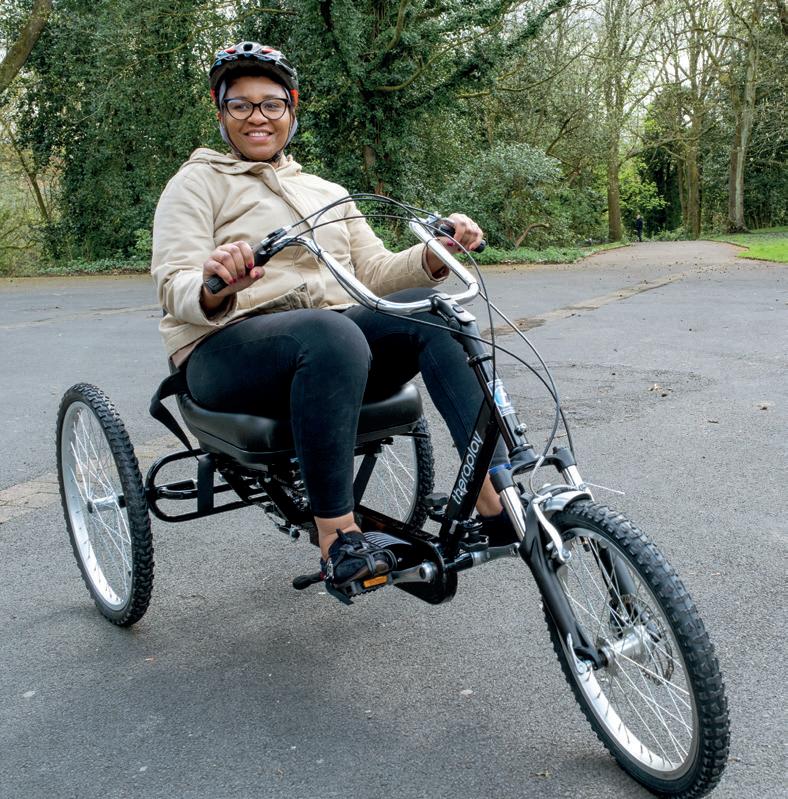
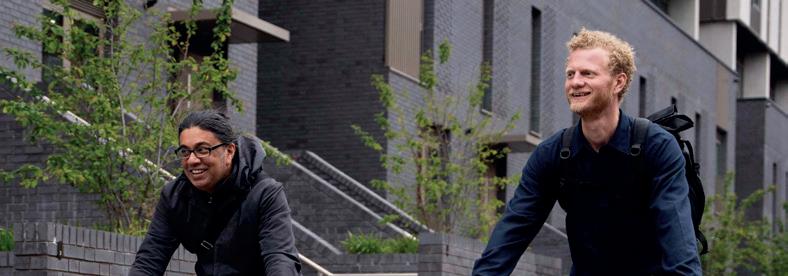


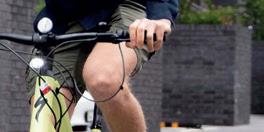









THE MAGAZINE OF CYCLING UK
cycle
test
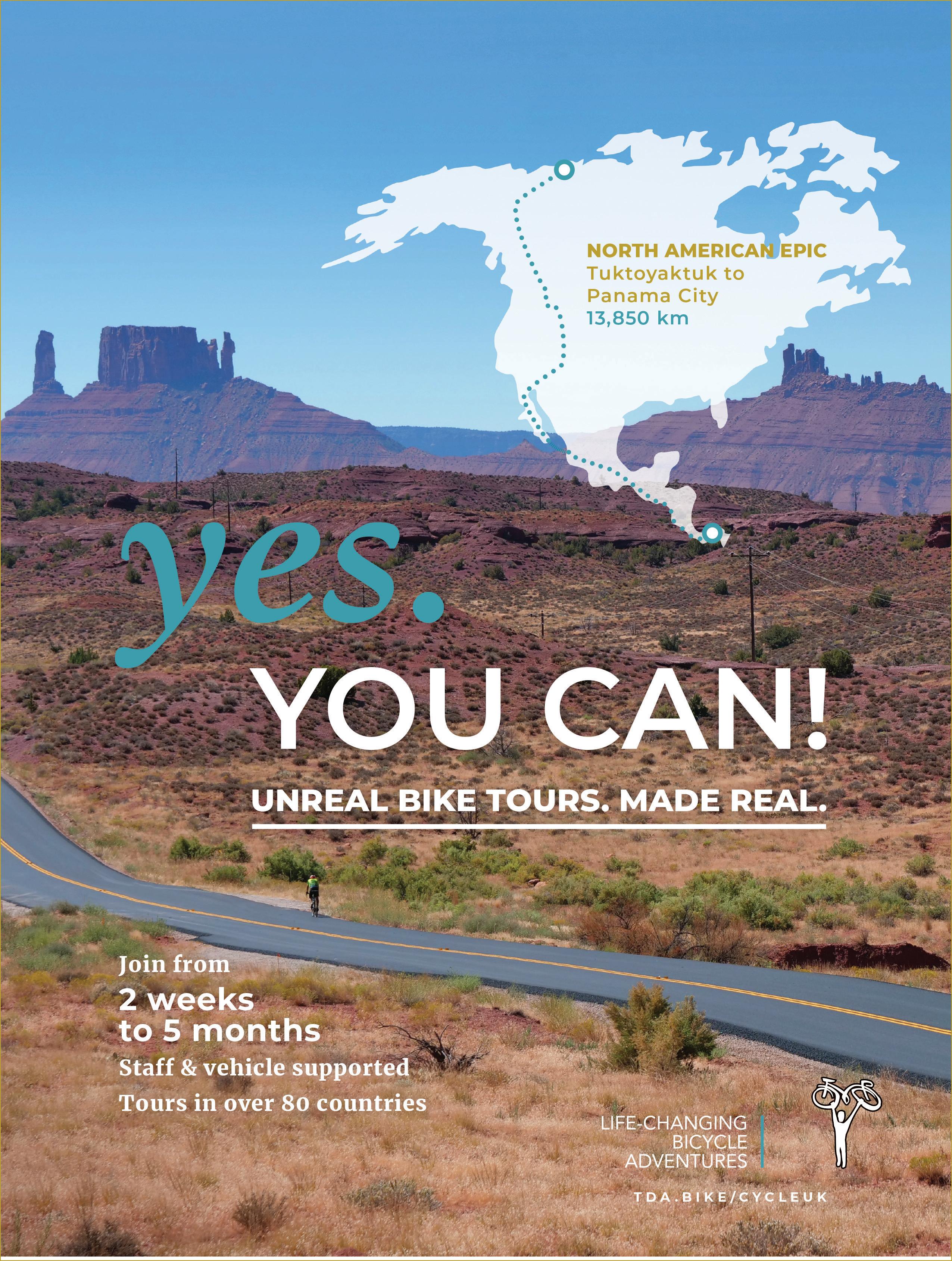

Welcome
“The past is a foreign country,” wrote LP Hartley in The Go-Between, “they do things differently there.” He wasn’t writing about cycling, of course, but the sentiments apply. Many things in the cycling world have changed enormously as the decades have rolled by.
The incremental differences are easy to miss when you live through them. Yet if you set the date in your mental time machine to, say, the 1970s and pull the metaphorical, Wellsian lever, you emerge into a very different place.
The cars were smaller and there weren’t nearly as many of them. Those are upsides we’ve lost today, along with the freedom of children in particular to get around by bike. But the bikes themselves were largely worse in the 1970s. Choppers. Ten-speed racers. Small-wheel shoppers.
The bike I rode around Cannock Chase in the 1970s, long before the first mountain bikes had crossed the Atlantic and even longer before Cannock became a trail centre, was an everyday Raleigh whose only concession to off-road terrain was (eventually) a retrofitted wider handlebar. My first road bike, meanwhile, was a five-speed ‘racer’ with suicide brake levers.
Rob Ainsley discovered his own pros and cons in the article you can read in this issue. He also found confirmation of something that long-time cyclists know instinctively: the challenges, opportunities and technology may change as time passes but one thing remains largely the same – the joy of cycling.




FEATURES
34 Cycling back in time
An old bike and no gadgets: 1970s’ touring in 2024
40 The way ahead
Your first look at Cycling UK’s new five-year strategy
50 Dusk ’til dawn
The joys of cycling through the night
PRODUCTS
20 Shop Window
A cross-section of new products
22 Gear up
Components, accessories and books
60 Aluminium all-rounders
Dolan RDX and Kinesis R1 road bikes on test
66 Kona Sutra SE
A steel tourer that’s adventure ready
69 Alternative handlebars
Multi-position flat bars for long ride comfort
DAN JOYCE Editor
REGULARS
04 Freewheeling
Bits and pieces from the bike world
07 This is Cycling UK


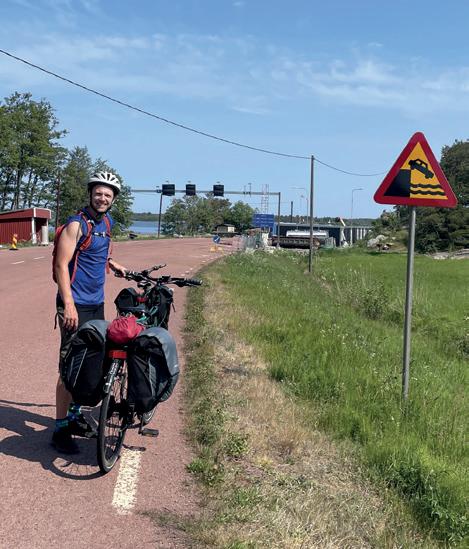


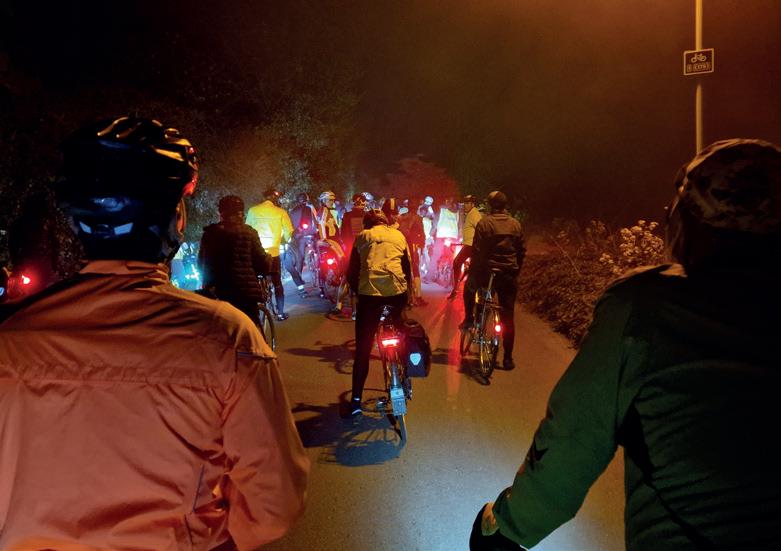

On the cover
How and why to become a Cycling UK trustee; Inclusive Cycling Experience programme; Create Streets report on active travel investment; our new long-distance routes; and more
18 You are Cycling UK
Cycling UK member Stephen Phillips
31 Letters
Your feedback on Cycle and cycling
47 Weekender
Coast to coast across Devon
54 Cyclopedia
Questions answered, topics explained
73 Travellers’ Tales
Cycling UK members’ ride reports
CYCLING UK: Parklands, Railton Road, Guildford, GU2 9JX E: cycling@cyclinguk.org W: cyclinguk.org T: 01483 238300. Cycle promotes the work of Cycling UK. Cycle’s circulation is approx. 51,000. Cycling UK is one of the UK’s largest cycling membership organisations, with approx. 70,500 members and affiliates. President: Jon Snow Chief executive: Sarah Mitchell. Cyclists’ Touring Club, a Company Limited by Guarantee, registered in England No 25185, registered as a charity in England and Wales Charity No 1147607 and in Scotland No SC042541. Registered office: Parklands, Railton Road, Guildford, GU2 9JX. CYCLE MAGAZINE: Editor: Dan Joyce E: editor@cyclinguk.org Designer: Christina Richmond Advertising: Jacob Tregear T: 0203 859 7100 E: jacob.tregear@jamespembrokemedia.co.uk Publisher: James Houston. Cycle is published six times per year on behalf of Cycling UK by James Pembroke Media, 90 Walcot Street, Bath, BA1 5BG. T: 01225 337777. Cycle is copyright Cycling UK, James Pembroke Media, and individual contributors. Reproduction in whole or in part without permission from Cycling UK and James Pembroke Media is forbidden. Views expressed in the magazine are those of the individual contributors and do not necessarily reflect those of the editor or the policies of Cycling UK. Advertising bookings are subject to availability, the terms and conditions of James Pembroke Media, and final approval by Cycling UK. Printed by: Acorn Web Offset Ltd, Loscoe Close, Normanton Industrial Estate, Normanton, WF6 1TW T: 01924 220633

Founded in 1878
CONTENTS
50 73 40 34
Photos: Pannier, Julie Skelton, Joolze Dymond, Roo Fowler, Will Palmer, Jordan Gibbons, Joe Cotterill & more
Top to bottom: Rob Ainsley, Roo Fowler, Titus Halliwell, Dan Wynn
A SHORT TOUR AROUND THE WONDERFUL WORLD OF CYCLING

You ride
Jez Briggs

HShop window
MORE ITEMS ON PAGE 20


Chair of Cycling UK affiliate group BikeActive Norfolk
aving volunteered at the adult disability cycling group BikeActive, based at Alton Water in Suffolk, I saw how it brought so much joy to their clients’ lives through cycling. So I thought it would be great to set up a similar group where I live in south Norfolk.
Two years ago I bought some equipment, managed to get a group of volunteers together and convinced a few clients, parents and carers to try a ride with us. BikeActive Norfolk started rides along National Cycle Route 30 at Earsham in Norfolk in spring 2023, cycling along the pretty River Waveney valley on a low-traffic route and heading on to a local café afterward. Everyone loved it.
Through spring and summer 2023 we delivered over 100 rides to 20 different clients. We acquired grants for better equipment and were gifted some useful disability cycles. Our incredible volunteers built an amazing website, BikeActiveNorfolk.org, transported our equipment to and from our sessions and helped service our cycles.
It’s been hard to get enough volunteers, tough to convince clients to give cycling a try, and difficult to get sufficient funds for much-needed specialist equipment. But thanks to our supporters and funders we have kept going. We will run every week through spring, summer and autumn this year, and fortnightly through the winter months.
We have attracted clients from a local SEN college to ride with us regularly. We will be running at a second venue in Topcroft, Norfolk, which also has low traffic volumes. And we will also be opening a junior group for children and young people. bikeactivenorfolk.org
INCLUSIVE CYCLING
Cycling UK’s new programme, the Inclusive Cycling Experience, offers free try-out sessions and non-standard cycle loans in Greater Manchester and Inverness. For details, see p10 or visit cyclinguk.org/inclusive-cycling-experience.


Tern Orox



Tern’s new adventure bike is a go-anywhere e-cargo cycle. It comes with 27.5×4in or 29×2.6in tyres, has an 85Nm Bosch Performance CX motor and runs one or two 800Wh batteries for a range of up to 200 miles. Maximum gross weight is 210kg. While most cyclists would be better served by an urban e-cargo bike like the Tern GSD, this allterrain behemoth will haul very large loads off road – if you need to do that. £5,900+, ternbicycles.com/uk
Park Tool CN-10
You seldom regret buying good-quality tools. So it is with Park Tool’s Professional Cable and Housing Cutter. The initial outlay – £50! – is steep but this tool cuts cleanly every time, saving the frustration and cost of frayed cables and crunched outers. There’s also a crimper for cable-end caps and a former for reforming cable housing and ferrules. £49.99, parktool. com

5-minute fixes
Tubeless fitting tips
Really?! Smart Tires
Pneumatic tyres have been the best option for bicycles for more than 130 years. Non-inflatable alternatives have always been worse. This novel ‘METL’ tyre from the Smart Tire Company has been displayed for a while and still pops up at bike shows. It employs a tight coil of resilient nickeltitanium tubing for a “smooth ride”. The future? Colour me sceptical. smarttirecompany.com/ cycling

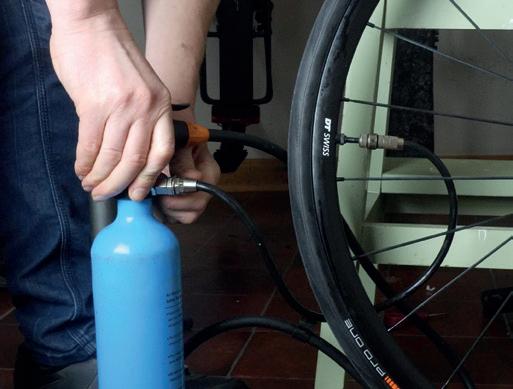
Tubeless tyres don’t always inflate first time. Make sure the tubeless rim tape is stuck down to a clean rim, starting opposite the valve hole. Make a small hole in it at the valve hole, not a cut, and ensure the tubeless valve is tightly secured so air can’t escape. Spray the tyre beads with more soapy water to lubricate. Remove the valve core so air will whoosh in quicker. Try again. No joy? Remove the tubeless valve, fit an innertube, inflate, then deflate and remove, leaving the tyre seated on one side of the rim. Try again. cyclinguk.org/tublesstyres
4 cycle JUNE/JULY 2024 cycle
Left to right: Traffic-free cycling for all. Jez Briggs (rear rider)
Classic kit
Above: Jez Briggs
Bike tech
Try this
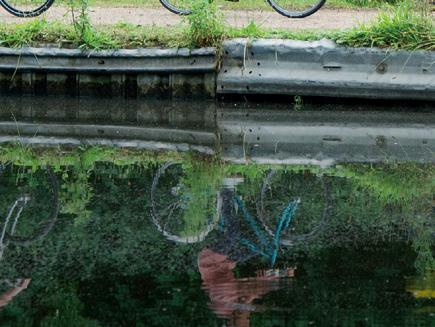
Be a #BikeHero this Bike Week
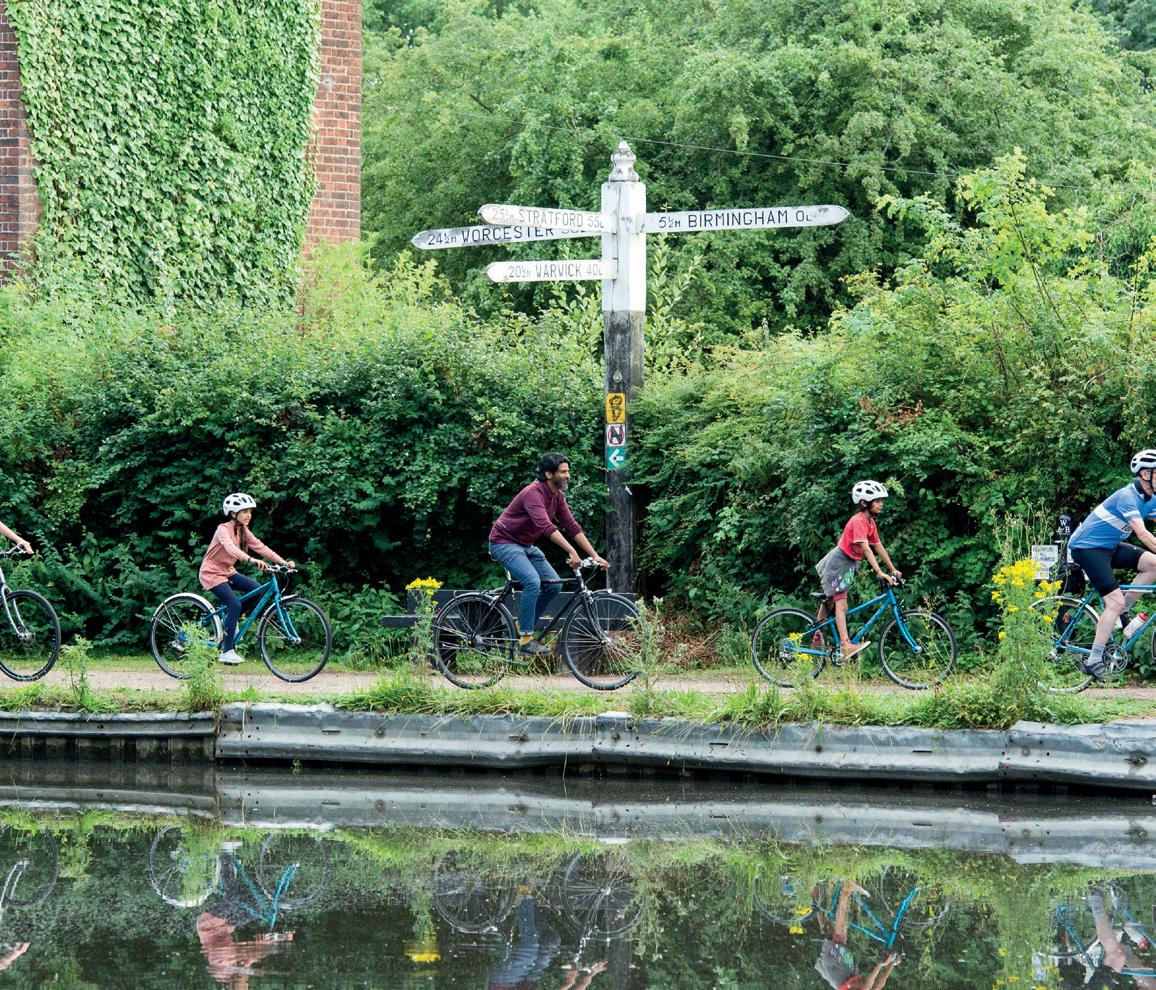

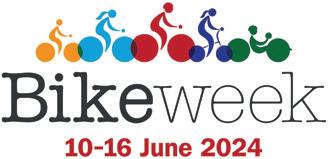
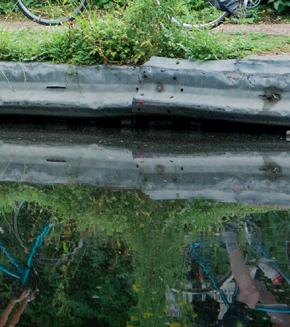
Bike Week, which marked its centenary last year, is the UK’s biggest awareness-raising event for cycling, and in 2024 Cycling UK wants to celebrate cycling as a force for good. We all know the many benefits riding a bike can bring – from improving health and wellbeing to helping protect the environment, and most importantly just being a lot of fun. This year, you can be a #BikeHero by organising a cycling-related event during Bike Week (10-16 June). It could be a cycling breakfast at work for those who commute by bike, a led ride, teaching a child to ride or anything else – be creative! cyclinguk.org/bikeweek
Watch this
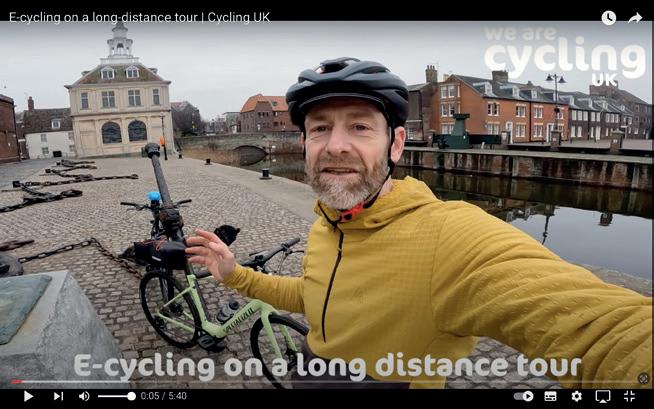

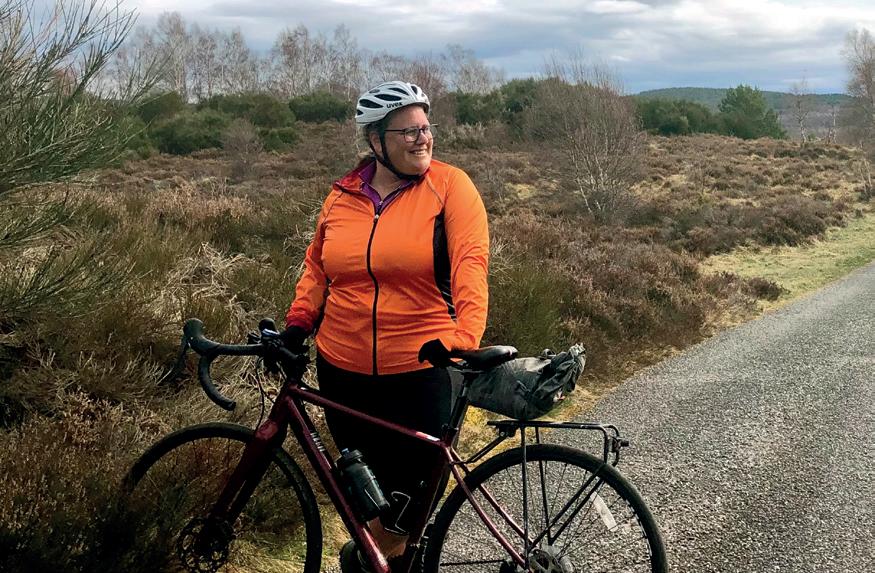
On my bike
Emily KnastonWilliams
Bicycle mayor of Inverness & one of our 100 Women in Cycling 2023
Why do you cycle?

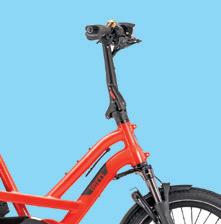
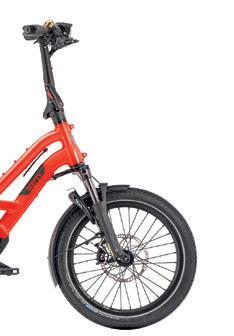
It’s really liberating – whether it’s ditching the car for going to the shops or the gym or to work, or out exploring locally.
How far do you ride each week?

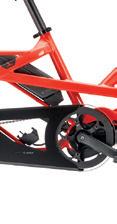


E-bikes can replace cars for many urban journeys but they can also take you much further afield. Electric assistance puts multi-day rides like Cycling UK’s Rebellion Way, West Kernow Way and Traws Eryri within reach of a greater range of cyclists but creates additional considerations, such as battery range and recharging. For an overview of these, plus a look at the benefits that an e-bike brings to longer journeys, watch our YouTube video ‘E-cycling on a long-distance tour’. You can find this and other Cycling UK videos at youtube.com/@CyclingUK.
Events
York Cycle Festival
The inaugural York Cycle Festival from 21-23 June brings together the long-running York Cycle Rally, the Summer Meet of the National Clarion Cycling Club and the Retrobike Show for fans of classic, vintage and retro bikes. It takes place on the Knavesmire in York. There will be club displays and a trade show, cycle jumble and auction. There’ll also be great food, craft beer, live music, spectacular grasstrack racing and a full programme of led rides. Parking, entry, rides and activities on site are all free of charge and everyone is welcome! Camping is available on site. Details and campsite bookings are online at yorkcyclefestival.org




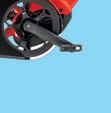
About 30 miles about town. I try to do a longer ride most weeks as well.
Which of your bikes is your favourite?
My everyday bike is a Tern GSD. I cannot overstate just how transformational e-cargo bikes are for everyday journeys. But I also have a Norco Search gravel bike.
What do you always take with you when cycling?
Snacks and a full water bottle.
Who mends your punctures?
I do. But I’ve put Tannus inserts in my tyres so I’m hoping to avoid them.
It’s raining: bike, public transport, or car?

Bike. Good waterproofs are everything.
Lycra or normal clothes?
Normal clothes for round town, Lycra for longer rides.
If you had £100 to spend on cycling, what would you get?
Winter tyres for my Tern.
What’s your favourite cycle journey?
I did a tour with a group of friends from Corran Ferry – down to Oban, around Mull and then Ardnamurchan, before heading back via Glenfinnan. Nothing beats sunny days on the bike with all your mates.

What would most improve matters for UK cyclists?
The end of car dominance! Reclaim the streets now.
CYCLINGUK.ORG cycle 5
York Cycle Festival is on the Knavesmire from 21-23 June
Right: Joolze Dymond Below: Isle of Mull, by Getty Images
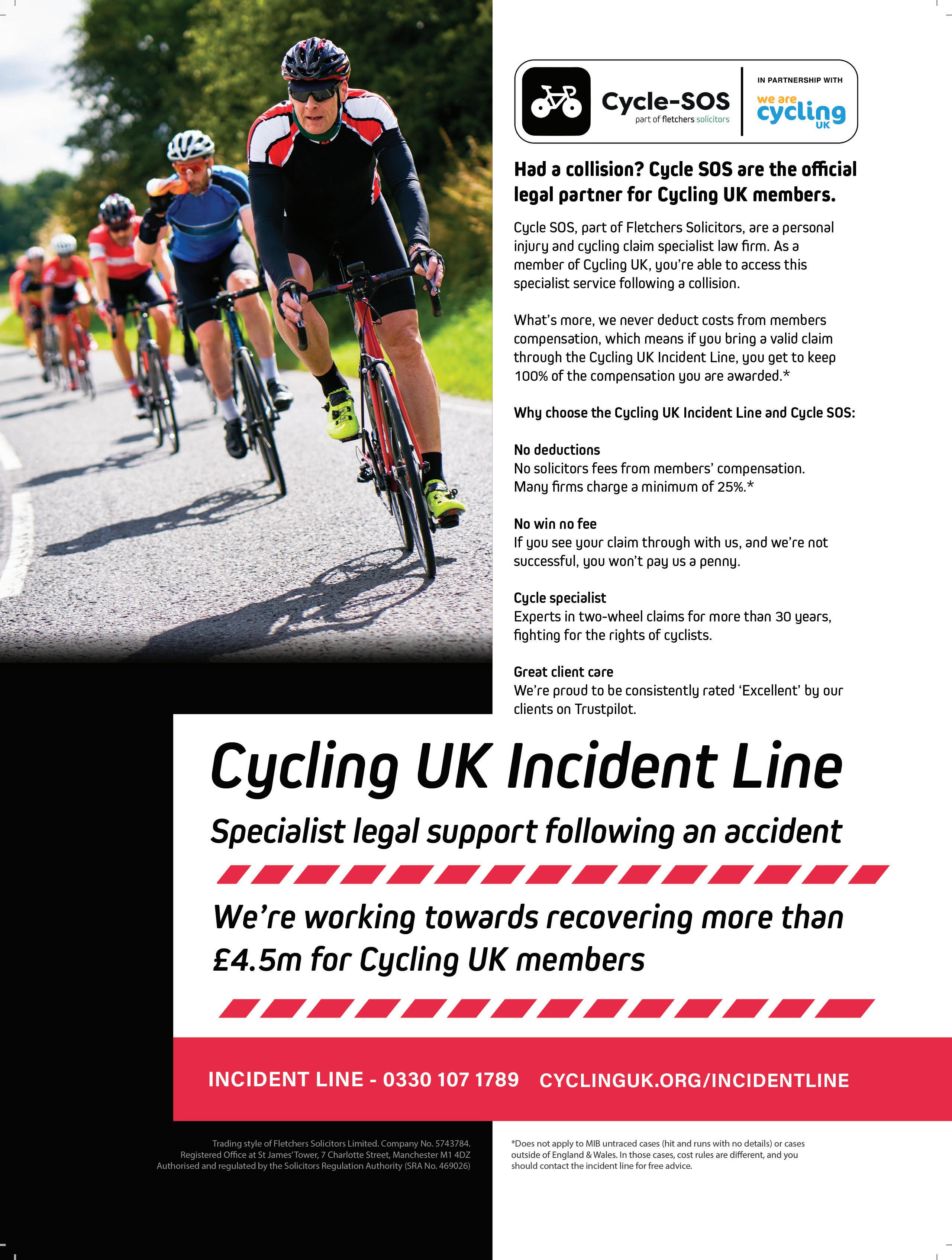



Stay in touch
Be in the know on all things cycling related. If you’d like to hear more about Cycling UK’s work – our projects, training, campaigns and fundraising, and how you can get involved – sign up to hear more: cyclinguk.org/subscribe






WThe journey begins
Cycling UK’s new five-strategy launches this June, aiming to deliver happier, healthier and greener lives through cycling.
Sarah Mitchell introduces it
e’re giving you a first look at the full detail of our new strategy in this issue, ahead of its public launch on 12 June. This strategy sets out the change we want to see in society and our plans over the next five years to make that change happen. I believe that it is – quite rightly – a bold and ambitious plan, one that builds on the successes of the last strategy and on our 145 years of heritage and expertise.
As people who love riding our bikes, we all know that cycling can be a powerful force for good. It delivers an extraordinary range of benefits, from transforming our health and wellbeing to tackling the climate emergency. Our new strategy focuses on fully realising this potential for cycling to help people and society.
Your input has been invaluable in shaping this strategy. Through focus groups and surveys, you’ve told us about your priorities and the things you most value about being a Cycling UK member. From our award-winning campaigning work and providing the best possible membership experience, to supporting Cycling UK groups and enabling the next generation to cycle – you’ll see many of those priorities reflected in our new strategy.
We recently gathered all our staff together in York to kickstart our work on the new strategic aims, and I was

inspired by the skills, experience and passion of our staff team. Cycling UK really is in safe hands. I’m so proud to be leading this wonderful organisation towards our 150th anniversary and so grateful for your continued support.
47% of people in England aged 5+ have access to a bicycle. It’s similar in the other home nations
Our trustees will play an important role in ensuring that we achieve our aims under the new strategy. They guide all our work and help to ensure that we use our resources as effectively as possible. As the terms of some of our trustees come to an end, we’re looking for members who can bring their skills, experience and passion for cycling onto the board. If you’ve got those things to offer, and want to get more involved in Cycling UK’s work to enable more people, from more diverse backgrounds, to experience the benefits of cycling, I’d encourage you to think about standing for a trustee role in this year’s election process – applications are open now.
I’m delighted that Cycling UK recently launched a brand new programme to enable people with disabilities and long-term health conditions to experience the joy of cycling. The Inclusive Cycling Experience has a fleet of specialist cycles that will help people to overcome many of the barriers that prevent them from using a standard upright bicycle. Free cycle loans, along with confidencebuilding sessions and expert support from our team, will boost the mobility and independence of people in Greater Manchester and Inverness. Thank you to our partners at the Motability Foundation for funding this important work.
Finally, please join us to celebrate Bike Week from 10-16 June; there will be plenty of ways to get involved. The theme this year is cycling as a force for good. Together we can improve lives through cycling – and you don’t need to wear a cape to do it. We want to celebrate all the bike heroes who encourage and enable more cycling. We know that when more people cycle, we all become happier, healthier, greener and more connected. cyclinguk.org/bikeweek
When more people cycle, we all become happier, healthier, greener and more connected
this is
Stay connected facebook.com/CyclingUK @wearecyclinguk www.cyclinguk.org cycling@cyclinguk.org 01483 238301 CYCLINGUK.ORG cycle 7
Families cycling in the New Forest
Photo:
Julie Rand
In London, cycle flows across the central cordon more than tripled between 2001 and 2020

Governance

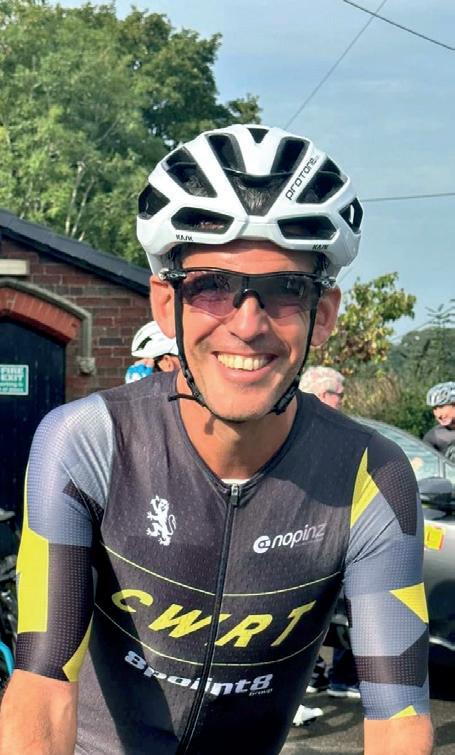
(source: TfL report)
THE ROLE OF TRUSTEES
ON BOARD WITH CYCLING UK
We’re looking for new trustees for Cycling UK’s board; one of them could be you. Three current trustees outline their roles
Over the next five years, Cycling UK will be focusing on delivering an ambitious new strategy, which was recently finalised by our board of trustees. We’re now looking for members to join the board as the terms of some of our current trustees come to an end.
As a Cycling UK trustee you get directly involved with what the organisation does to enable people from all walks of life to experience cycling’s joys and benefits. Our trustees have a wide variety of backgrounds and interests. Here are three of them.
Robin Tucker
Robin runs his own business consultancy and has executive level experience at Natural England and Vodafone. He is secretary of the Oxfordshire member group and one of its ride leaders. He has drawn on his experience of business and local cycle campaigning to input into the strategy development process. He said: “I see cycling as a practical solution to many of the world’s problems when it comes to issues such as health, climate and transport. I’m excited to play my part in steering the organisation to bring this message to new audiences as we enter our new strategy period.”
Melanie Carroll
Melanie owns a bookshop and is a freelance Bikeability and adult cycle instructor. She is campaigns officer for the Lincolnshire member
group, a ride leader for Lincoln Women’s Group and a local campaigner. Melanie is passionate about diversity in cycling and has used her experience and knowledge in this area to the board’s benefit. She said: “I’m really pleased that a commitment to boost the diversity of new cyclists is enshrined within Cycling UK’s new strategy. Ensuring that cycling is accessible and promoted to all is absolutely vital for the future.”
Mark Smith
Mark is managing director at Trinny London, and has held positions as chief operating officer at Sweaty Betty and as a director at Evans Cycles. He is always on a bike – commuting on his Brompton or racing on his road bike. Mark’s expertise has been invaluable in shaping the enablers of our new strategy. He said: “I strongly believe that Cycling UK must be professional and efficient in order to deliver maximum benefit for the people we work with and really make a difference to our cause. It’s essential that we understand our audiences, invest in our people, and diversify and strengthen our income base if we are to remain a sustainable organisation well into the future.”
If, like Robin, Mel and Mark, you can bring your passion for cycling and use your background and professional skills to help us deliver our strategy, now is the time to consider standing for a trustee role in this year’s election process.
Governance Cycling UK is governed by a board which comprises up to 12 trustees. At least nine must be members of Cycling UK, elected by the membership. The board may also co-opt trustees to fill gaps in skills, knowledge and experience. Each elected trustee serves for a term of three years, up to a maximum of three consecutive terms. All trustees share the same core duties and must act as a group, not as individuals.

Procedure TRUSTEE APPLICATIONS
The application process for appointments to join the board for 2025-27 is now open. The deadline for applications is 9am on 3 July 2024. Visit cyclinguk.org/ about/cycling-uk-board/ how-to-become-a-trustee for more information and to download the application pack, which includes details of the skills we’re looking for this board term.
this is 8 cycle JUNE/JULY 2024
Robin Tucker Melanie Carroll Mark Smith
Trustee Nadia Kerr on BBC Breakfast
Below right: BBC
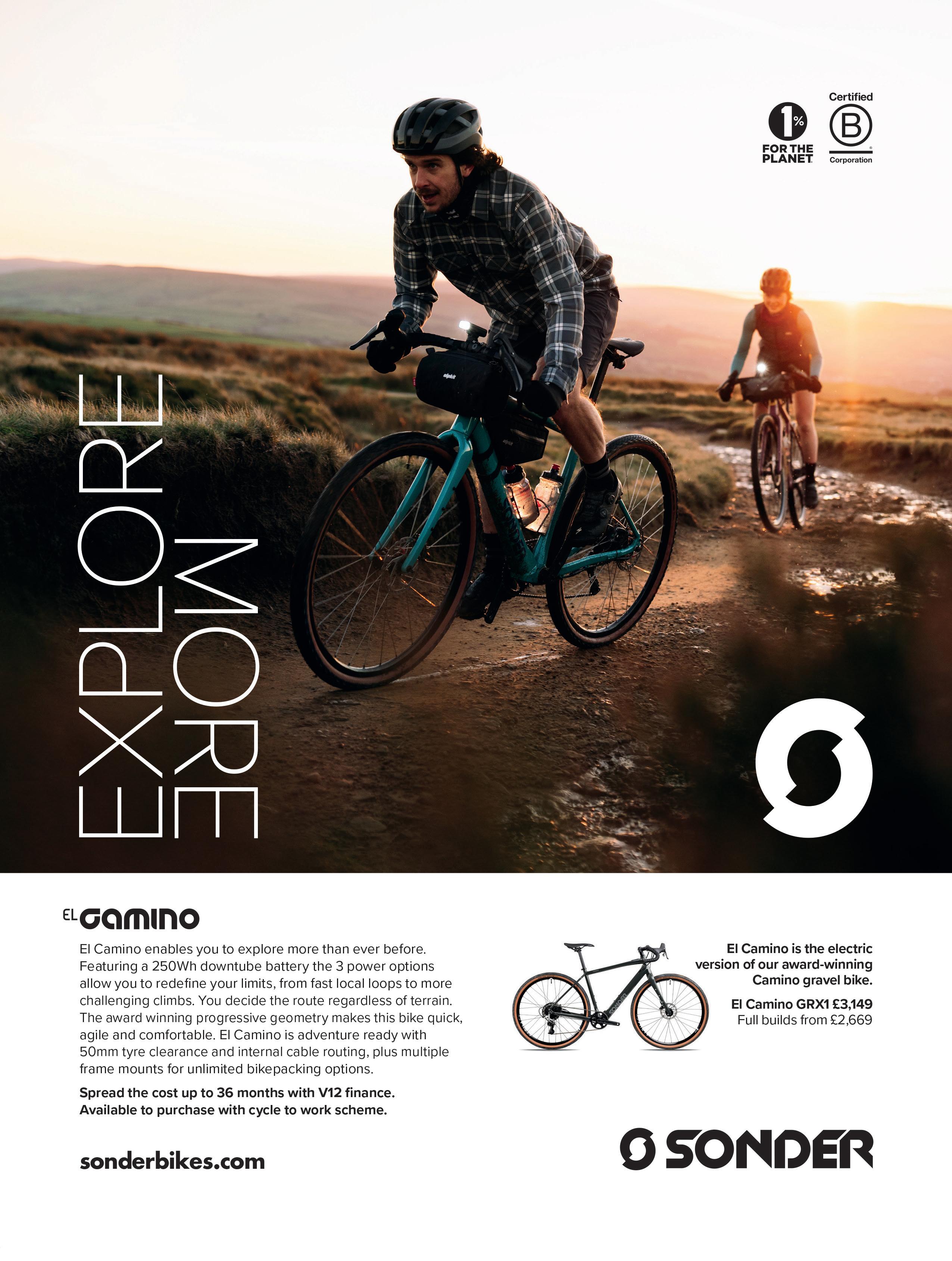

Scotland
CYCLING SUPPORT AT HOLYROOD
In March Cycling UK hosted an exhibition stand in the Scottish Parliament. We were able to talk to 47 MSPs about the benefits of cycling and the need for further investment. That opportunity for engagement, visibility and relationship building was excellent, and may now prove invaluable as new First Minister, John Swinney, seeks allies in parliament. We will be reaching out to Cabinet Secretary for Transport Fiona Hyslop, urging her to recommit to supporting cycling and sustainable travel.
Events
STRATEGY WEBINAR FOR MEMBERS
We’ve launched our new five-year strategy, which aims to fully realise the vast potential of cycling to help people and society. We’d love to tell you more about what it means for our work and hear from you. Join us for an online member event on 5 June to hear more about the strategy and why we believe it will be really positive for members and groups. Register for your place: cyclinguk.org/ member-webinar
On average, men in England made three times as many cycle trips per year as women from 2015-19
(DfT travel survey)
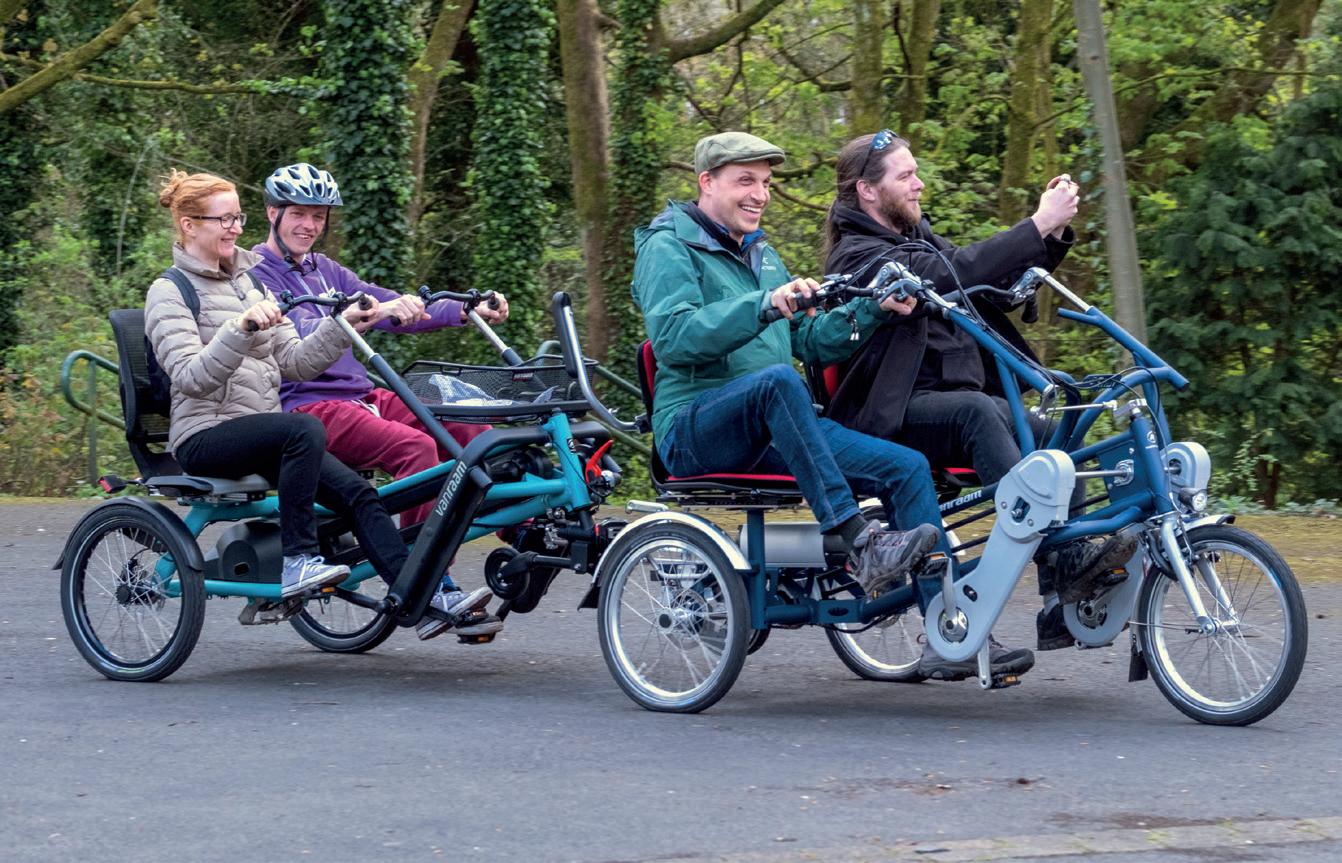 Disability cycling
Disability cycling
THE INCLUSIVE CYCLING EXPERIENCE
Cycling can bring a sense of freedom as well as an important means of getting around to many people with disabilities or long-term conditions. However, getting the right cycle can be difficult. This is where Cycling UK’s new project, the Inclusive Cycling Experience, comes in. This exciting new programme will support disabled communities to start cycling by offering free try-out sessions and nonstandard cycle loans. This will break down two of the main barriers disabled people face when it comes to cycling: the
Awards
100 WOMEN IN CYCLING 2024
cost and lack of availability of appropriate cycles; and a lack of skills and confidence.
The loans range from one day to a month, and users can come back multiple times. Cycling UK’s fleet of bespoke and customised cycles includes tricycles, e-cycles, recumbent cycles and tandems. These will help overcome many of the problems that prevent people with disabilities, such as visual impairment, limited mobility or dyspraxia, from using a standard upright twowheel bicycle.
The confidence-building try-out sessions have expert
It’s your last chance to nominate this year’s 100 Women in Cycling. Who would you like us to celebrate in our eagerly awaited awards for women who work hard and do exceptional things that inspire others to cycle?
You can nominate grassroots campaigners, community ride leaders, influencers, industry movers and shakers, or
support to ensure each person gets a cycle that is right for them and their cycling needs. Essential skills will be taught, too.
Funded by the Motability Foundation, the Inclusive Cycling Experience is available in two regions: Greater Manchester and Inverness. Participants must be over 16 and resident in either of the two locations. The scheme is open to people who have a disability, a long-term health condition or who self-identify as disabled.
cyclinguk.org/inclusivecycling-experience
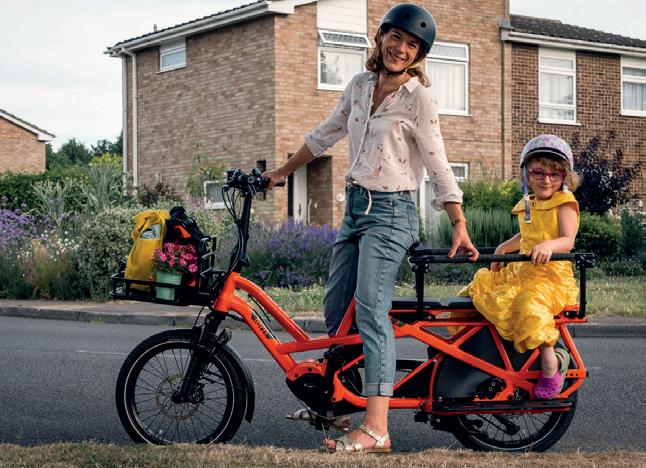
sporting heroes – or anyone else that you think deserves recognition.
Don’t miss your chance: nominations close Sunday 9 June. Visit cyclinguk. org/100women/nominations.
this is
10 cycle JUNE/JULY 2024
A wide range of adaptive cycles and e-cycles will be available
Caz Conneller, from 2023’s 100 Women
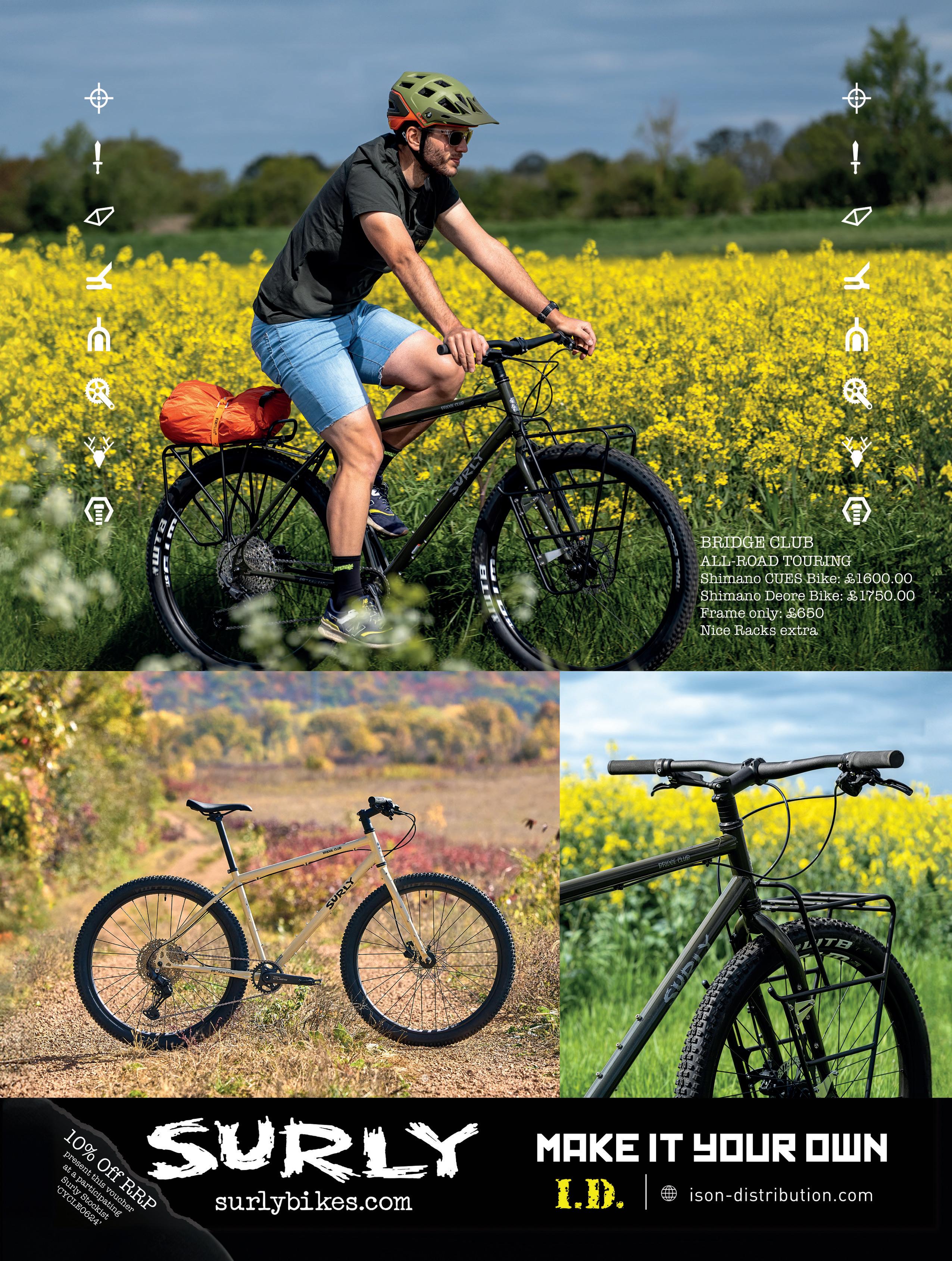
Campaigns
ELECTING TO SUPPORT CYCLING
Want to make the case for cycling to your local politicians? The Move Free report by Create Streets, which was commissioned by Cycling UK, shows how giving people more transport choices boosts high streets, housing, health and happiness. It’s packed with evidence and case studies of places which have flourished by making it easier to walk and cycle. We’ve condensed all the evidence into handy summary documents so that whichever issues your elected representatives care about, you can prove that cycling is the answer. cyclinguk.org/move-freesummary
Prizes
SUMMER RAFFLE
The Cycling UK office is buzzing. We’re busy securing prizes, ready for you to buy your tickets for our summer raffle for just £1 each from 3 July. Every ticket purchased helps improve lives, places and the planet through cycling’s remarkable benefits. Bookmark the raffle page now (use the QR code or visit cyclinguk.org/ raffle). Thanks to all who entered our New Year raffle, raising over £17,000.

4% of employed adults in Scotland cycled to work in 2021 (transport.gov.scot)

Transport
BACKING FOR ACTIVE TRAVEL
New report makes an economic case for cycling investment. Duncan Dollimore elaborates
How do we avoid cycling being seen as an antagonistic issue and make sure it appeals to parties across the political spectrum? In the run up to a general election, we need the evidence, case studies and compelling stories that illustrate the wide-ranging benefits of giving people transport choices, and to explain why it matters to voters.
Thanks to your support, we’ve been able to commission high-quality independent research from think-tank Create Streets.
Entitled Move Free, the report shows that governments and councils that are willing to put active travel at the heart of communities will be rewarded with happier, healthier and richer places.
For example, retail sales increase by an average of 30% following projects that improve pedestrian, cycling or public transport access to shops. For politicians who aren’t that interested in carbon emissions but care about their struggling high street, that’s a persuasive argument. We’ll be able to use this research ahead of the election to demonstrate that cycling is the solution to
problems a future government will be trying to tackle.
When we launched the research at an event in the House of Commons in March, the room was buzzing with people discussing how making it easier to move around places in different ways is great for health, happiness and prosperity. We spoke to housing developers, people in the construction industry, and business leaders – as well as government ministers, MPs and Lords.
We were fortunate to have both Transport Minister Guy Opperman MP and Shadow Transport Minister Stephen Morgan MP speaking at our event and responding to the research, with both of them agreeing on the positive impacts that active travel can have.
It was excellent to hear Stephen Morgan say that “Labour will support local authorities to make cycling and walking an option for all” and that “it is so important that an incoming Labour government gets this right”.
If he gets his wish and Labour does win the election, we’ll be sure to remind them of that! cyclinguk.org/blog/move-free-reportlaunch-parliament
12 cycle JUNE/JULY 2024 this is
The report launch at the House of Commons


Member benefit
LARGE SCALE SAVINGS ON MAPS
Cycling UK members get an exclusive 35% discount on an annual subscription to OS Maps Premium. Discover thousands of ready-made cycling routes or plan your own using the National Cycling Network overlay. View, print or download maps to access them whenever and wherever you need. cyclinguk.org/ member-benefits/ ordnance-survey-maps

Member benefit
SUNNY OUTLOOK FOR SKINCARE
Keep your skin healthy this summer with Pelotan. Avoid skin damage and sunburn on those long-distance rides with high-performance sun protection that’s trusted by elite athletes, including Grand Tour winners. With up to eight hours’ protection, you won’t have to reapply on the fly and can feel comfortable cycling for longer. Unlock a 25% discount on Pelotan products today. cyclinguk. org/member-benefits/ pelotan

Cycling UK members enjoy 10% off all things cycling at Decathlon

Insurance & events

SUMMER CYCLING COVERED
As summer approaches, it’s the perfect time to map out your next cycling adventure in the UK. For those who cherish the freedom of pedalling through picturesque landscapes, there’s no better time to revel in the warmer weather than during Bike Week (10-16 June).
Bike Week is the UK’s biggest celebration of cycling, and this year we want to celebrate all those who cycle and encourage and enable more cycling. When more people cycle, we all become happier, healthier, greener and more connected. There’s lots of ways to get involved – visit cyclinguk.org/bikeweek for more.
During Bike Week, enjoy the peace of mind that comes with a week’s worth of free bicycle insurance from our partners, Yellow Jersey. Their Essentials Bicycle Insurance package is tailored for recreational cyclists, safeguarding your bike against potential mishaps like theft and accidental damage during long-distance rides.
The package covers one bike with a value up to £1,500 and also safeguards your accessories up to £250. For details, see yellowjersey.co.uk/bikeweek-2
Don’t forget that Yellow Jersey offers a range of year-round discounts to Cycling UK members on its bicycle insurance policies. Log in to your member benefits portal for all the detail: cyclinguk.org/member-benefits
Once you’ve got your Yellow Jersey insurance sorted, check Cycling UK’s routes
page (cyclinguk.org/route-listing) to discover detailed descriptions, maps and highlights for a whole host of inspirational cycling routes across the UK.
If your Bike Week adventure ignites a desire to push your limits, why not tackle an off-road challenge with a 15% discount on any one-day Glorious Gravel sportive throughout the summer and beyond.
Glorious Gravel hosts several rides that promise to encapsulate the essence of a British summer, including the Northumberland Gravel Epic. This July event, setting off from the picturesque market town of Rothbury, intertwines serene forests and picturesque villages, providing riders with a captivating journey through this lesserexplored corner of the county.
The Welsh Borders Gravel Epic is a punchy route starting in the glorious Llandegla Forest this August. The route throws everything a gravel bike can take at you, with stunning climbs on the road, hilltop gravel tracks and a thrilling final descent.
No matter your skill level or location, Glorious Gravel offers rides spanning from the Isle of Wight to northern Scotland, catering to both seasoned off-roaders and newcomers alike. Get your discounted ride –visit cyclinguk.org/member-benefits/new15-uk-gravel-rides
Now you’ve got everything need, you can dust off your bike, pack your panniers, and embrace a summer filled with exploration and boundless opportunities.
14 cycle JUNE/JULY 2024 this is
Cornwall’s West Kernow Way
Left: pannier.cc
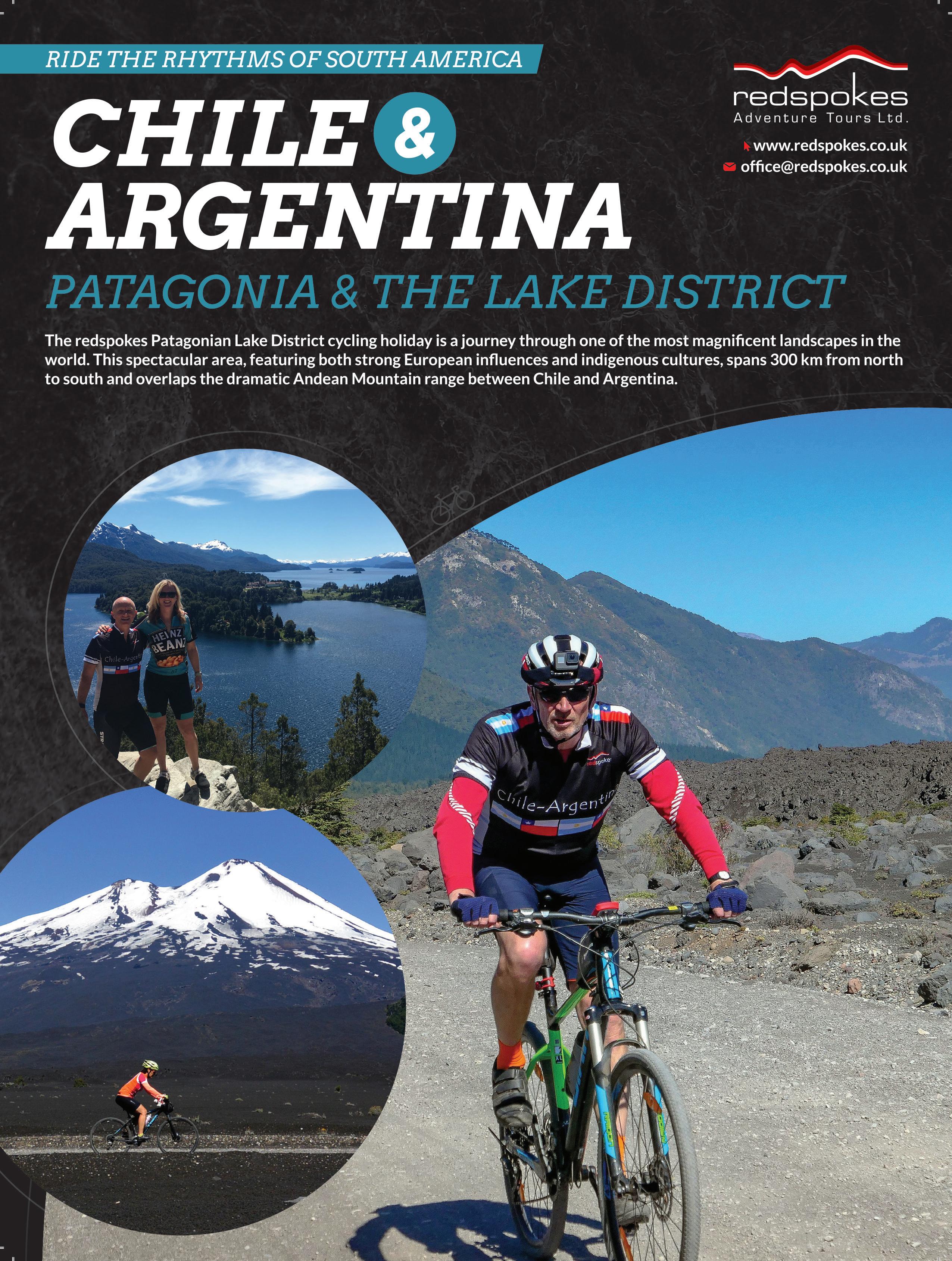
Routes
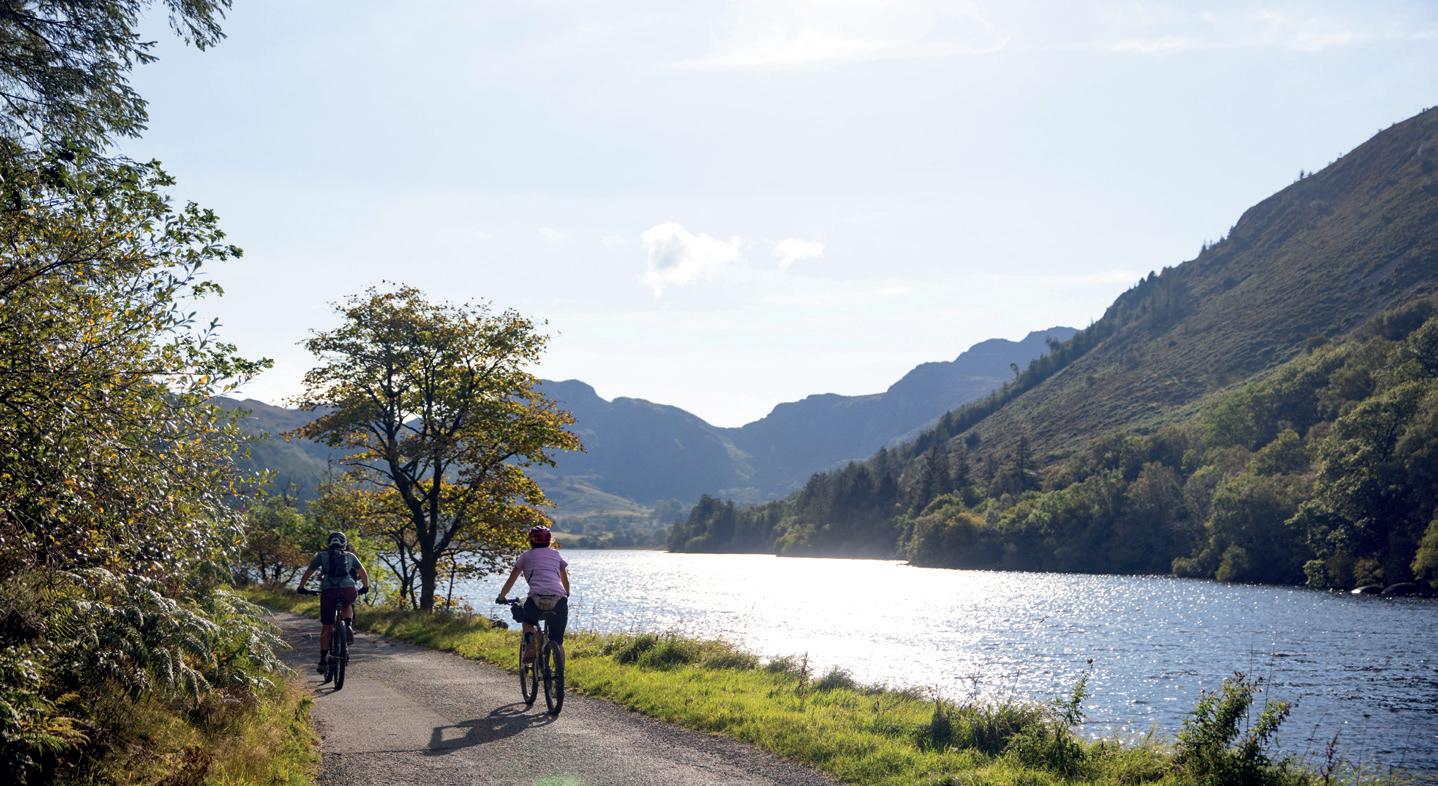
UPCOMING ADVENTURES
Help us create new long-distance routes by donating today. Together we can develop more awe-inspiring routes in 2025
Since 2018 we’ve created several breathtaking adventure cycle routes across the UK, inspiring thousands of riders like you to connect with our rich history and stunning natural landscapes, enjoying the very best of the UK’s historic landmarks.
• Traws Eryri weaves 196km through one of the UK’s most dramatic mountain landscapes. With sweeping descents, gnarly climbs and rugged terrain throughout, the route promises to show you the best of the wilds of North Wales.
• The Rebellion Way is a 373km cycling adventure through Norfolk. Meandering along a mix of quiet and mostly flat back roads, byways, cycle paths and bridleways under huge panoramic skies, it’s a fantastic introduction to multi-day, on- and off-road adventuring for anyone.



In 2025 and beyond, we want to create more of these routes for you and for future generations so that more cyclists can enjoy and explore our spectacular landscape. This time we need your help to make it a reality. We’re raising funds to finance our work on new routes. Your donation today will bring new, awe-inspiring cycling adventures to life. It also helps to encourage sustainable tourism and support local businesses along our routes. You can be part of this adventure: donate today to make our new routes a reality for you and others like you.

• The Cantii Way takes its name from the Celtic tribe that inhabited the area during the Iron Age. Combining quirky coastal towns and dramatic chalk cliffs with the rolling hills of the Kent Downs Area of Outstanding Natural Beauty, this is a 237km adventure to savour.
• The West Kernow Way takes in many of the highlights of the western half of the Cornish peninsula over 238km, including the Botallack tin mines, the Bronze Age monument Mên-an-Tol, Land’s End, St Michael’s Mount and Lizard Point. Expect spectacular coastal scenery, hedgerows bursting with wildflowers and ancient tracks across isolated moorland.
• King Alfred’s Way is a 350km circular offroad adventure route through 10,000 years of history, connecting some of southern England’s most iconic sites.

What’s more, your support will go further right now thanks to a generous matched funder. For every £1 you donate before the end of May, the Gill Foundation will kindly match your gift so you can double your impact. (Donations after the end of May are still welcome!) Scan the QR code or visit cyclinguk.org/longdistance-routes-appeal




As a member-driven charity, we’re deeply grateful for the support of our members and route lovers who have already given to our long-distance route appeal. We cannot continue work like this without the generosity you have shown. Thank you to those who have already supported us by raising £21,066 (as of 7 May). Your help can allow more people to enjoy the breathtaking British countryside.
Staying up to date
We want you to be the first to know how our next route is developing. With your donation we will give you insider access. You will:
• Receive regular updates on the development of our route series
• Get early access to order the route guide
• Be sent the plotted route via GPX file on the day of launch
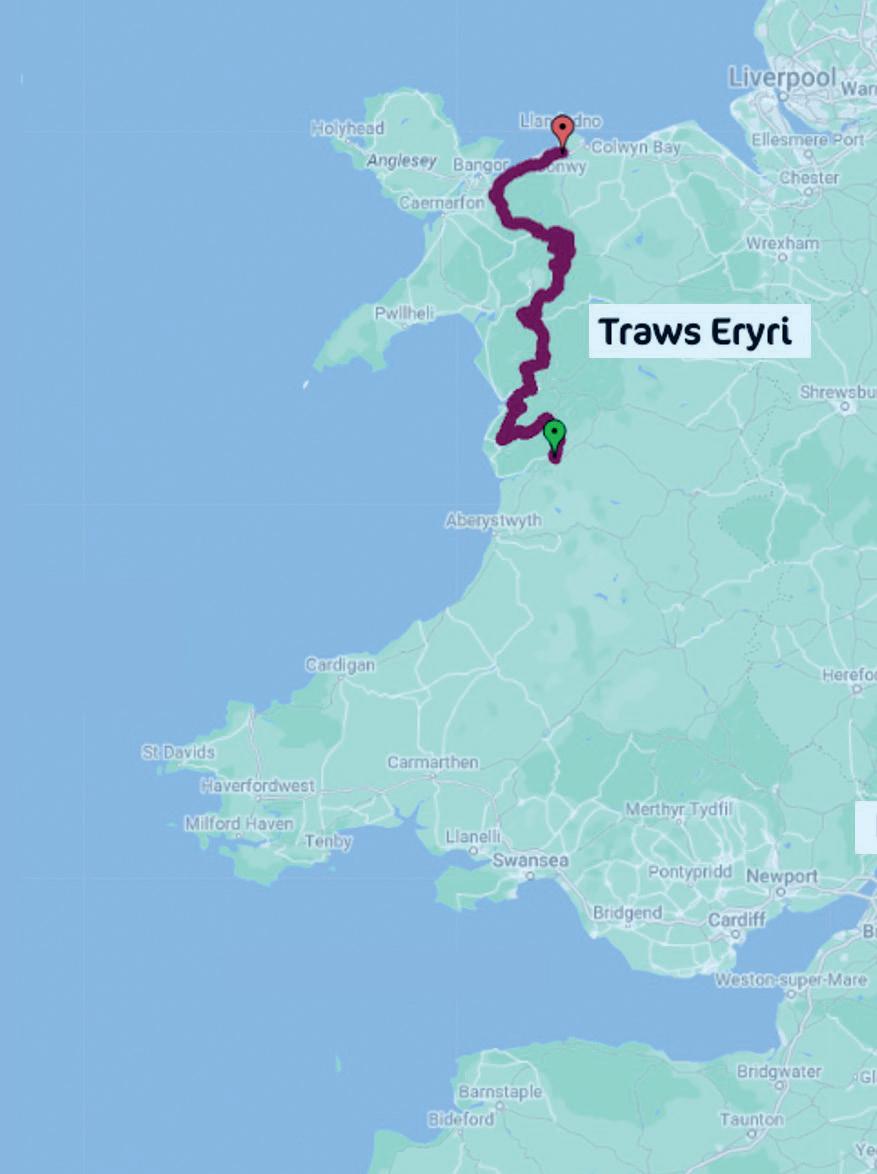
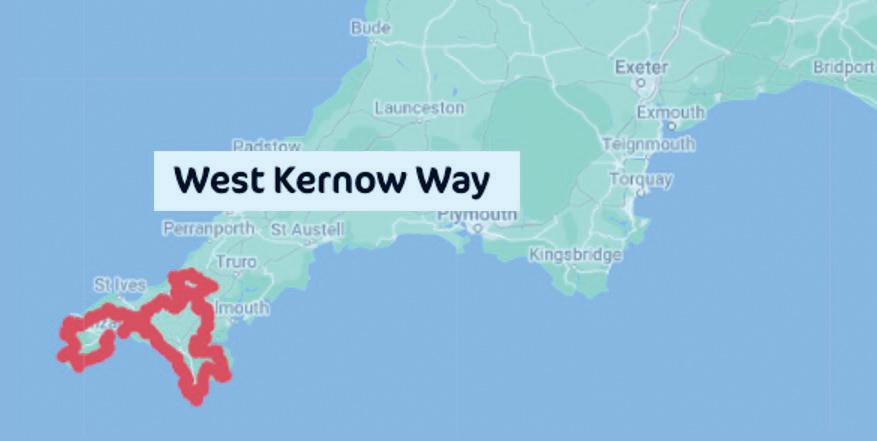
The Gill Foundation
Julie and Martin Gill from The Gill Foundation explain why they have supported and generously match funded our long-distance route appeal.
“We have been cycling for about 20 years, initially commuting then riding various organised sportives in different places, and then starting our own cycle club. Moving on from single-day rides, the appeal of seeking new horizons
this is Top left: Sam Dugon. Top right: Saskia Martin 16 cycle JUNE/JULY 2024
Traws Eryri in North Wales





SAM ROBERT







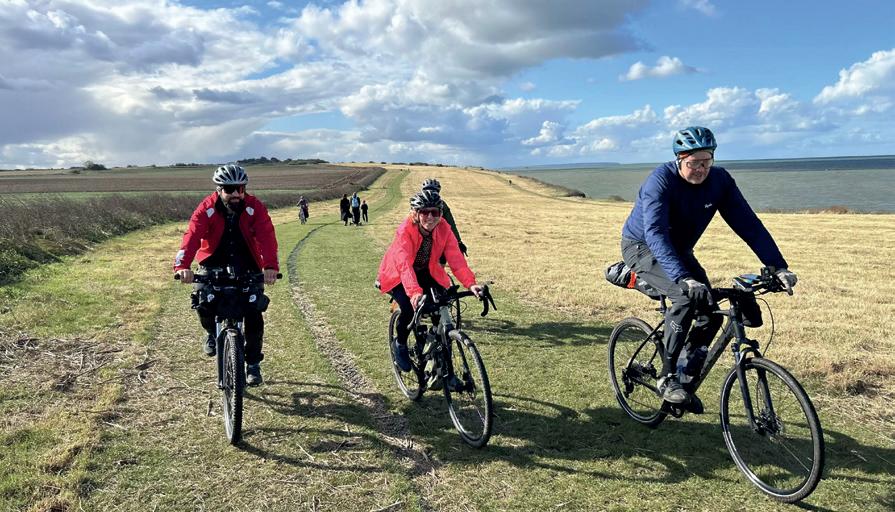
GREG KROLAK

In 2021 we embarked on the newly launched King Alfred’s Way. What followed was a week of epic weather and company on what was our first long-distance bikepacking adventure. A group of misfits with all sorts of kit and dubious fitness levels, navigating by photocopied map pages and coming together to enjoy a part of the UK we’d never experienced. Highlights were sleeping in beautiful meadows, getting close to Stonehenge, feeling the aura of the Avebury stones, talking a pub landlord into letting us camp in the beer garden, and experiencing a beach in the Surrey Hills. The memories will always live with us, and I personally cannot wait to make more. Thank you, Cycling UK!
encouraged us to undertake longer journeys both in the UK and Europe. Multi-day trips from Devon to London, around the Cotswolds, London to the South of France, NC500 and Norway to Spain opened our eyes to the joy of riding through amazing scenery, meeting new friends and keeping fit.
“We stumbled on some of the Cycling
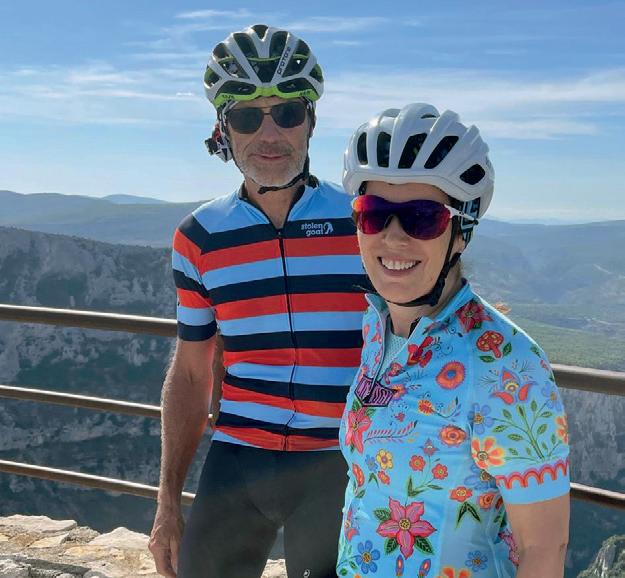



After discovering and cycling the whole Cantii Way on my own, I decided to invite a couple of friends on a weekend bikepacking adventure. A group of friends, fantastic views, varied and interesting trails and lot of laughter – good times! We are all planning the next trip.


UK long-distance routes from watching GCN coverage and have now ridden King Alfred’s Way, the Cantii Way (several times) and the Rebellion Way. The Rebellion Way was a particular joy and is forming the basis of our cycle club’s spring tour this year!
“Talking through the enjoyment of riding these routes with family and friends, we felt
we wanted to support Cycling UK in its campaign to create a series of new UK based multi-day routes. These should allow riders to explore new parts of the country by cycle, enjoying historical sites and seeing incredible views from quiet roads and gravel and MTB trails. So there should be something for everyone. The routes should also open new sections of lost by-ways or closed access to make for new adventures.”
CYCLINGUK.ORG cycle 17 this is
Rebellion Way in East Anglia
Martin and Julie Gill
LISA WILLIAM
Last year my husband and I rode the Rebellion Way. It was a lovely but windy five days, visiting lots of interesting places.
Bivvying on King Alfred’s Way
you are
Club cyclist
STEPHEN PHILLIPS
In the 1960s, 12-year-old Stephen Phillips began riding with his local group – thanks to the encouragement of older riders like Jack
Wheels are in my DNA. I spent my childhood on wheels: a battered trike; a home-made go kart; roller skates; and a scooter. At 12 I finally had my first bike and was determined to join a cycling club. My mum found that the local section of the Cyclists’ Touring Club had a clubroom at a place called Bentley Heath. A recce was done and I was allowed to cycle into the rural lanes the following Wednesday evening.
The night air was cold so I had put on my school coat. The dynamo was humming. My bike was a Triumph Palm Beach with a bouncy saddle, a 3-speed Sturmey-Archer gear and a straight handlebar. At the point where country replaced town, someone sped effortlessly past me. This was no doubt someone from the cycling club so I gave chase.
My pursuit began fairly well, dynamo fizzing loudly. After a junction, the road climbed steadily and the red rear light of the other cyclist drifted further and further ahead. Sometime later I arrived at the clubroom with steam rising from me. There was, so far, just one other person there, the cyclist I had chased in vain.
“I’m sorry, I didn’t realise that you were coming here. I would have waited for you,” said the cyclist. I had met Jack. He had taken up cycling to encourage his son to have a go. The son did appear once or twice at the clubroom. Jack, though, had been bitten by the cycling bug – and here he was.
Jack showed me how to ride my bike properly and advised what to buy when I could afford to do so. He told me off when I stepped out of line and made sure I got home at the end of club rides. Sometimes he literally pushed me over the final miles.
The Palm Beach was replaced by a scruffy lightweight Jack Holland, which was gradually improved over time, and I was introduced to a
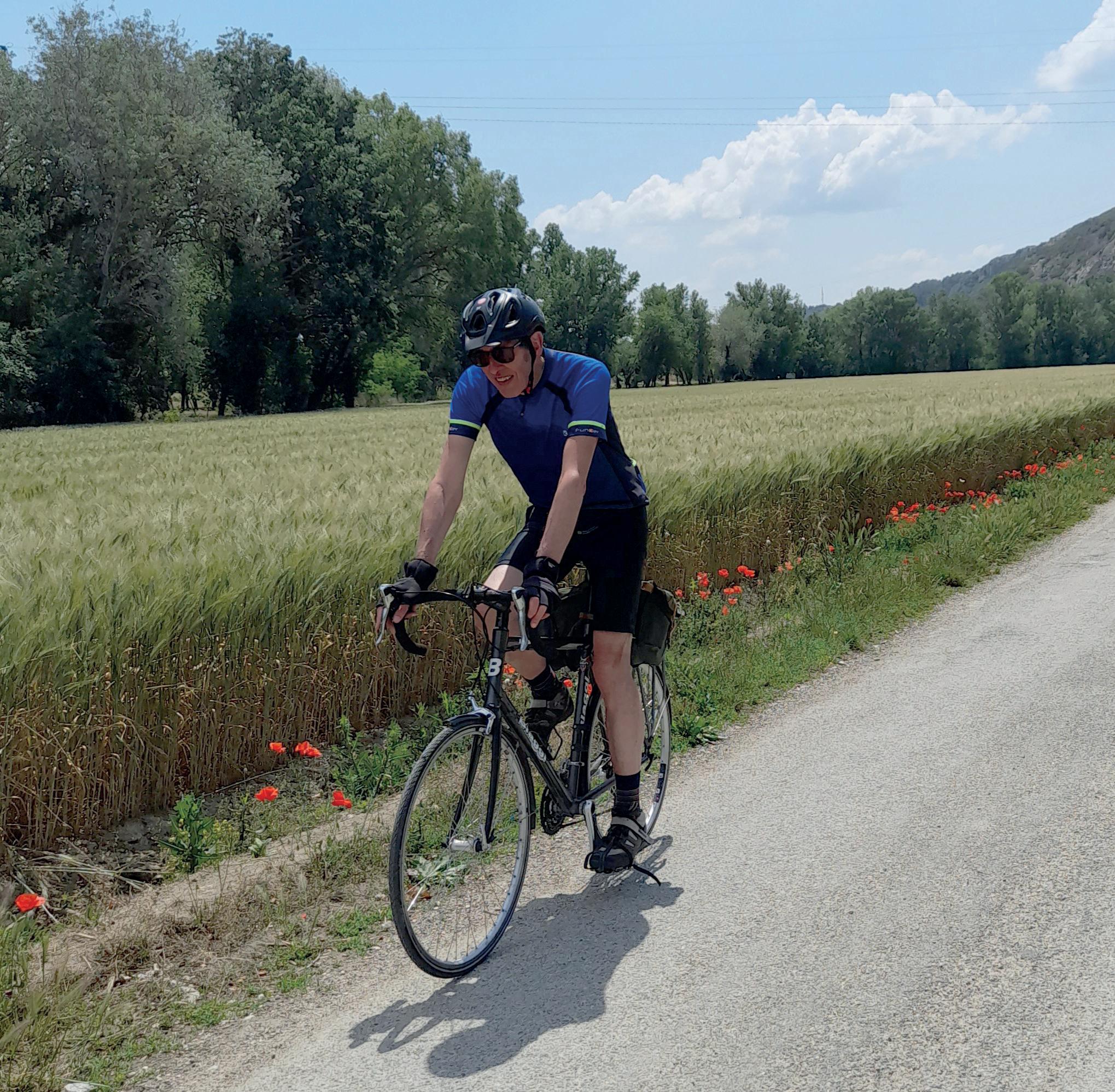
network of unspoilt Warwickshire and Worcestershire lanes.
The weekend club runs would end at a ‘tea place’, often a cottage with tea served in the front room. Stories were told, ranging from funny to serious.
I did not appreciate at the time that I was witnessing the end of an era. Motorways were soon carving through the countryside, cutting across the lanes. New hygiene regulations seemed to put an end to the cottage caterers. Roads changed, there was creeping urbanisation and an astonishing increase in traffic. But the tradition of the club run continues still.
None of us foresaw the level of interest in cycling that has developed in recent years. Tea places are now a variety of cafés, pubs offering food or garden centres. Stories are still spun there.
Club runs have always had a rule of riding at the pace of the slowest person. Who this is becomes apparent, especially towards the end of the day. I had become a strong rider and I was on the front of the group one day, helping to bring us home.
There was a call from the back: “Easy, Jack is down!” (i.e. has been left behind). Further on came the call: “Better stop at the junction. Jack is well down!”
I brought the group to a halt at the road junction, by chance the same one through which I had pursued Jack several years earlier.
Jack appeared and rode straight past the group, stuck his arm round me and said: “Oi, you young strip!

We’re even now, so you can slow down!”
I was lucky. The members of that cycling club could have told 12-year-old me to go away and come back in a few years’ time. They did not. I am indebted to friends who supported me so much and sparked a love for cycling that I still have.
Juniors today
Many Cycling UK groups welcome young riders, with some provisos:
• Children aged 12 and under must be accompanied by a parent or guardian, or somebody acting ‘in loco parentis’ on rides; there is no younger age limit for accompanied children.
• Young people aged 13 and over may ride unaccompanied.
• Young people aged 17 and under should have a completed Parental Consent Form, which should be handed to the ride leader or event organiser.
For more details, visit cyclinguk.org/ article/legal-guide/ safeguarding.
Stephen cycling in France recently – thanks to Jack Below: Stephen, aged 14, on his resprayed Jack Holland
18 cycle JUNE/JULY 2024

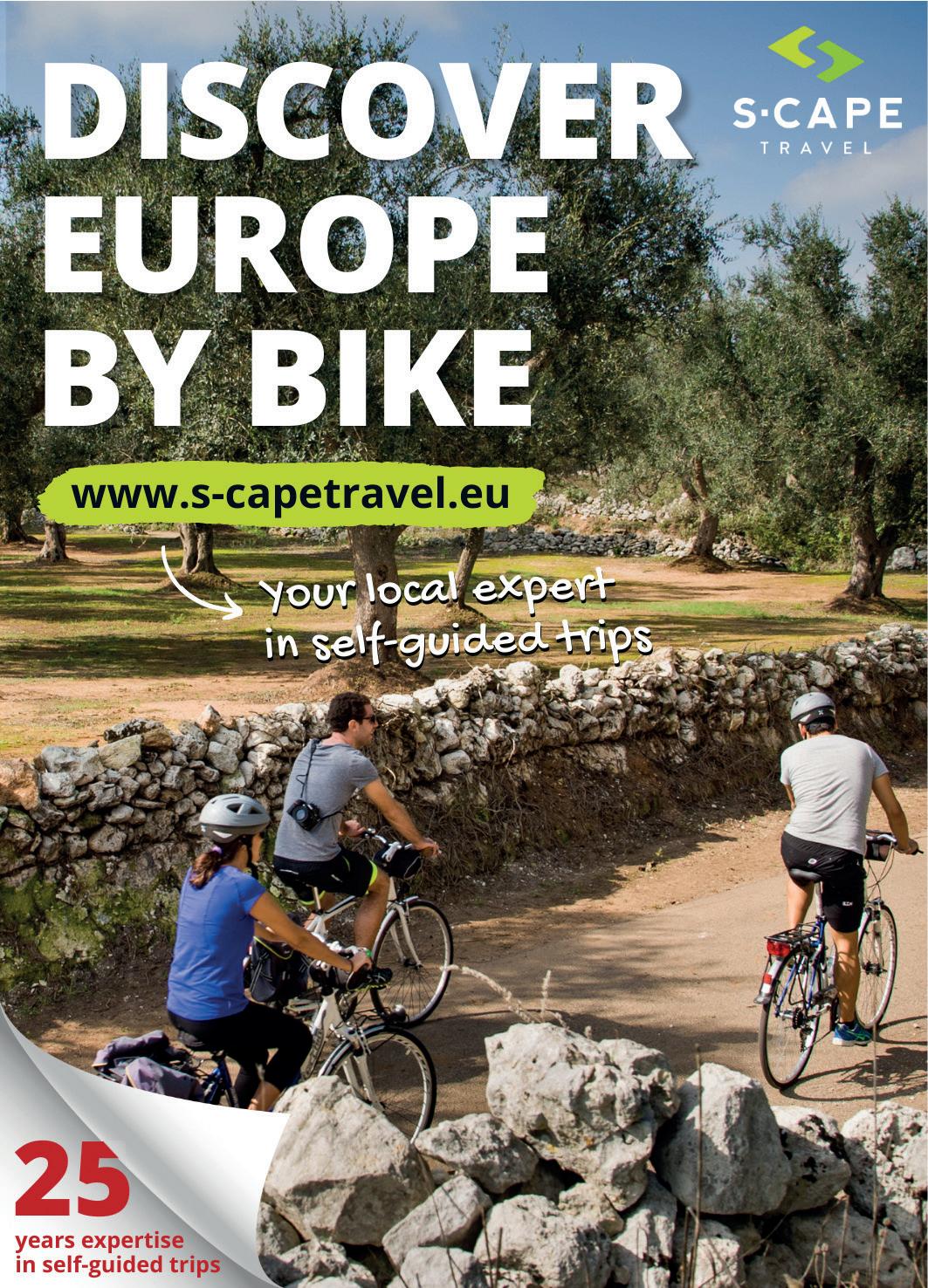
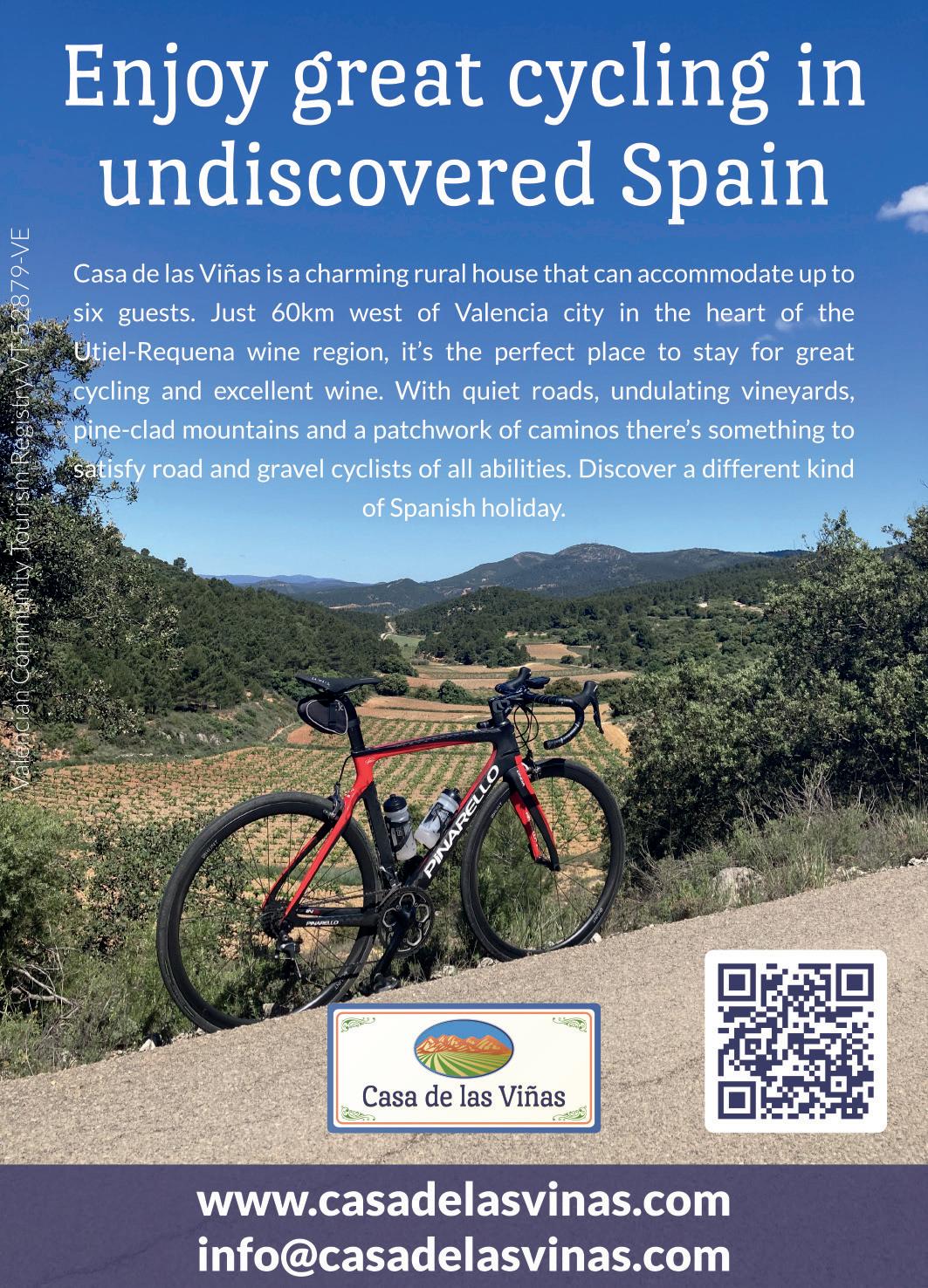
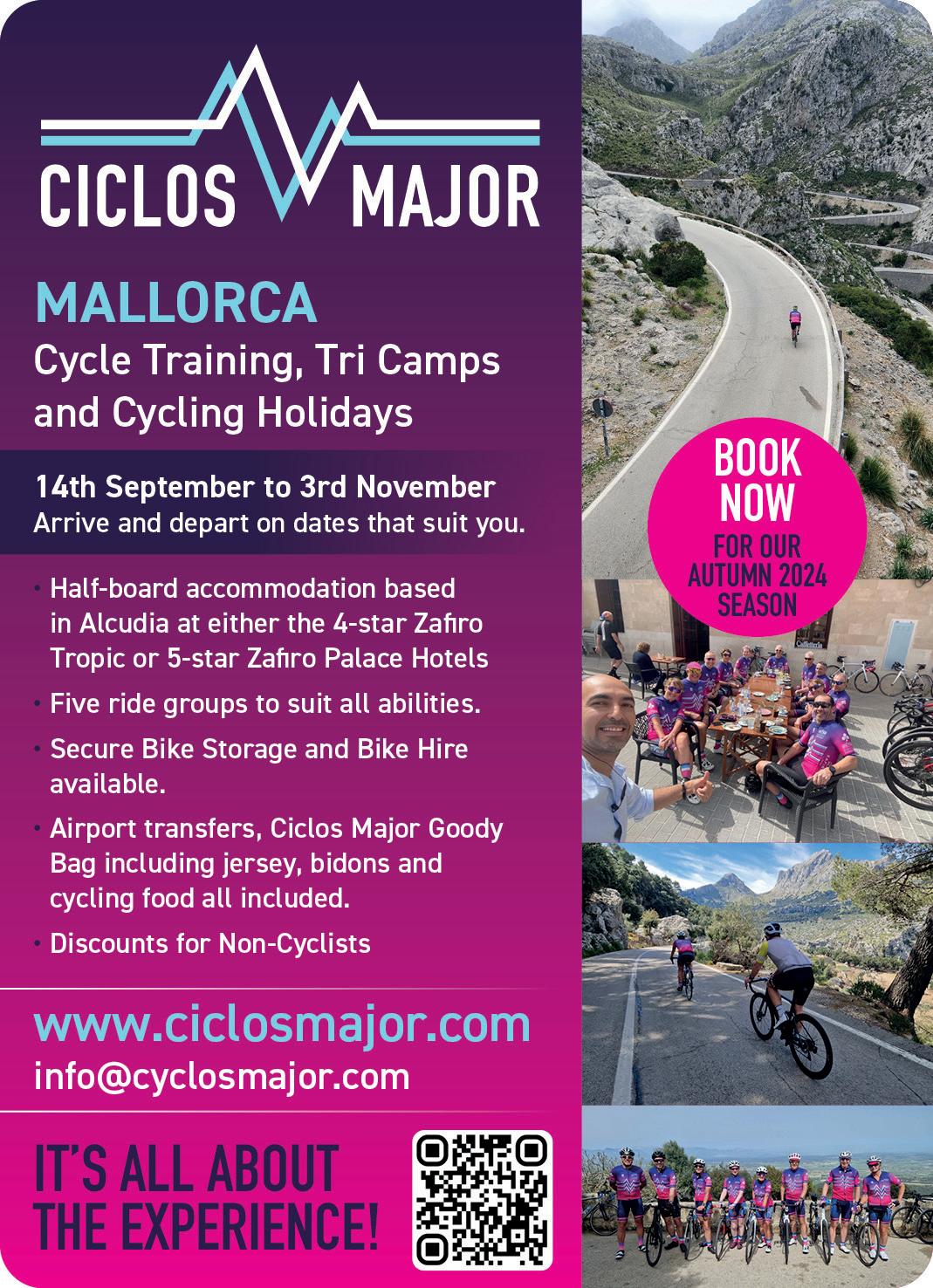
SHOP WINDOW
Sunshine is the upgrade most of us will be looking forward to this summer. But if it's products you're after, Dan Joyce has some suggestions
Save money
As a member, you can save up to 50% on a wide range of cycling products and services. Visit cyclinguk.org/ member-benefits







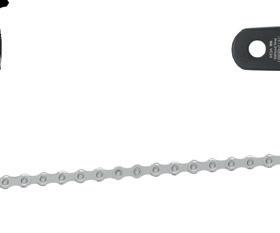


1 Shimano ESSA £158
Shimano’s new entrylevel groupset is a 1×8 setup with a 32 or 40t chainset and an 11-45 cassette. The derailleur is £50, chainset £40, cassette £40 and shifter £28. shimano.com


2 Fold+Roll







Rolling clothes makes them less creased in your commuter bag. This wrap also keeps them separate. Lay your stuff on it, fold in the sides, roll, then hook the end over. foldnroll.com
3 Pelotan SPF30 200ml Spray
If we do end up needing sunscreen this summer (fingers crossed!), this is breathable and sweat resistant – and Cycling UK members get 25% off. pelotan.cc
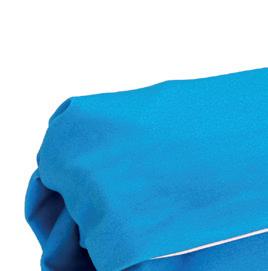





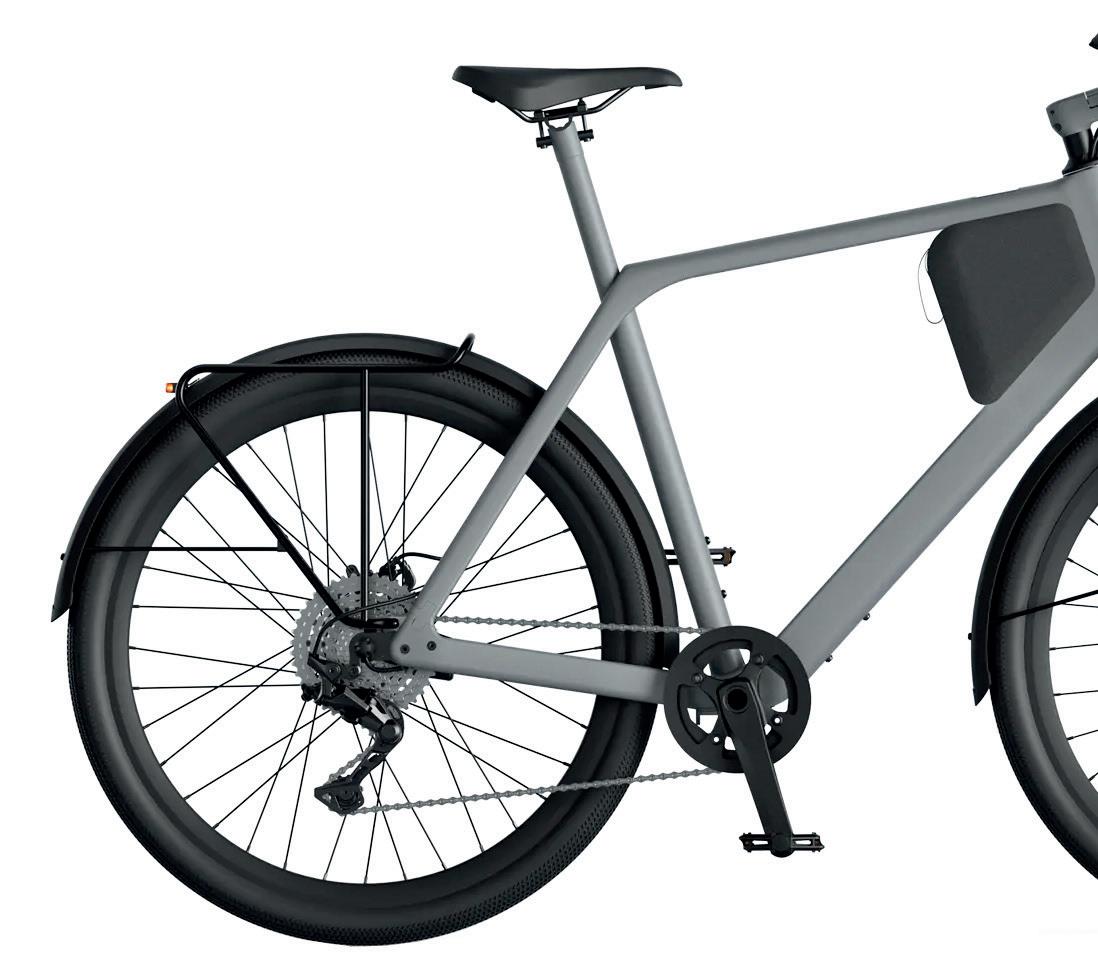


4 Lemmo One Mk2 £2,049+
This urban e-bike has a clutch in the rear hub to bypass its motor so you can ride it like an unpowered bike when required. The battery pack is simple to remove, too. uk.lemmofuture.com

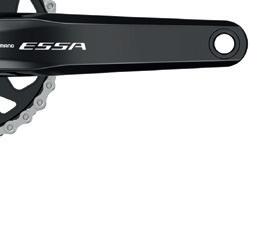


5 Apidura Expedition E-bike Charger Pack £62
A waterproof and foampadded 1.6L bag that’s specifically designed to carry an e-bike’s charger on long/ multi-day rides. It straps underneath the down tube. apidura.com
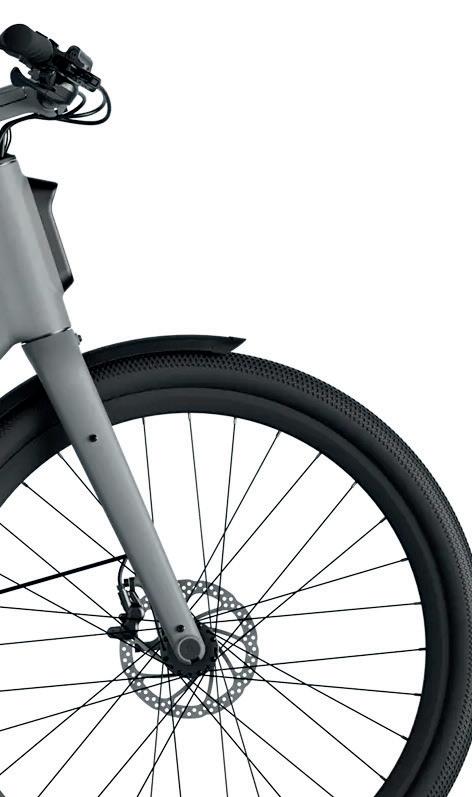


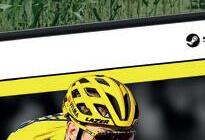

Photo Stick £49+
6 Stinner X Made
To photograph bikes I prop them up with an actual stick. This screw-together Y-shaped support does the same job better – for a price. Steel or titanium options. stinnerframeworks.com
7 Tour de France
2024 £34.99
Play out a different version of Le Tour with the new stageracing sim. Swashbuckling attack or stare at your stem? Decide on your PC, PlayStation or Xbox. cyanide-studio.com/en
7
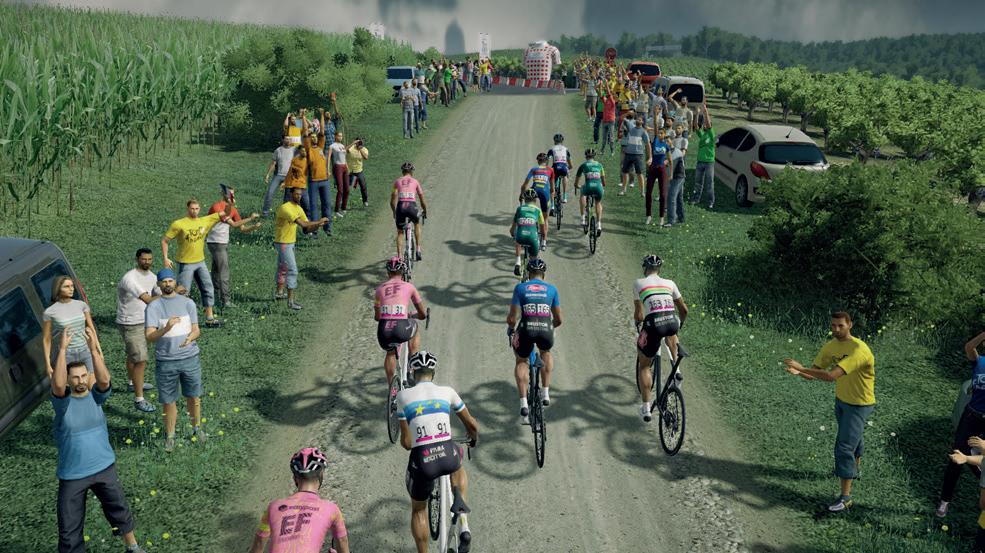


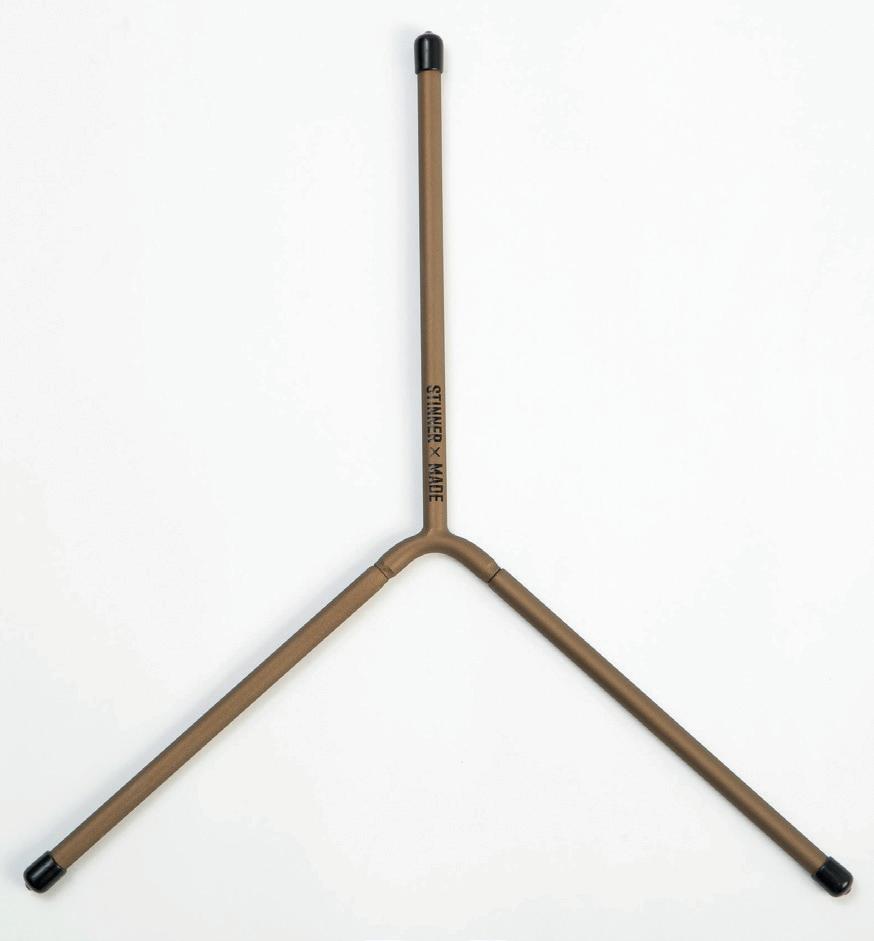
Product news 20 cycle JUNE/JULY 2024
More online Check out our in-depth reviews of the latest bikes and gear online at: cyclinguk.org/cycling-advice has some suggestions 3 4 5 6 7 2 1
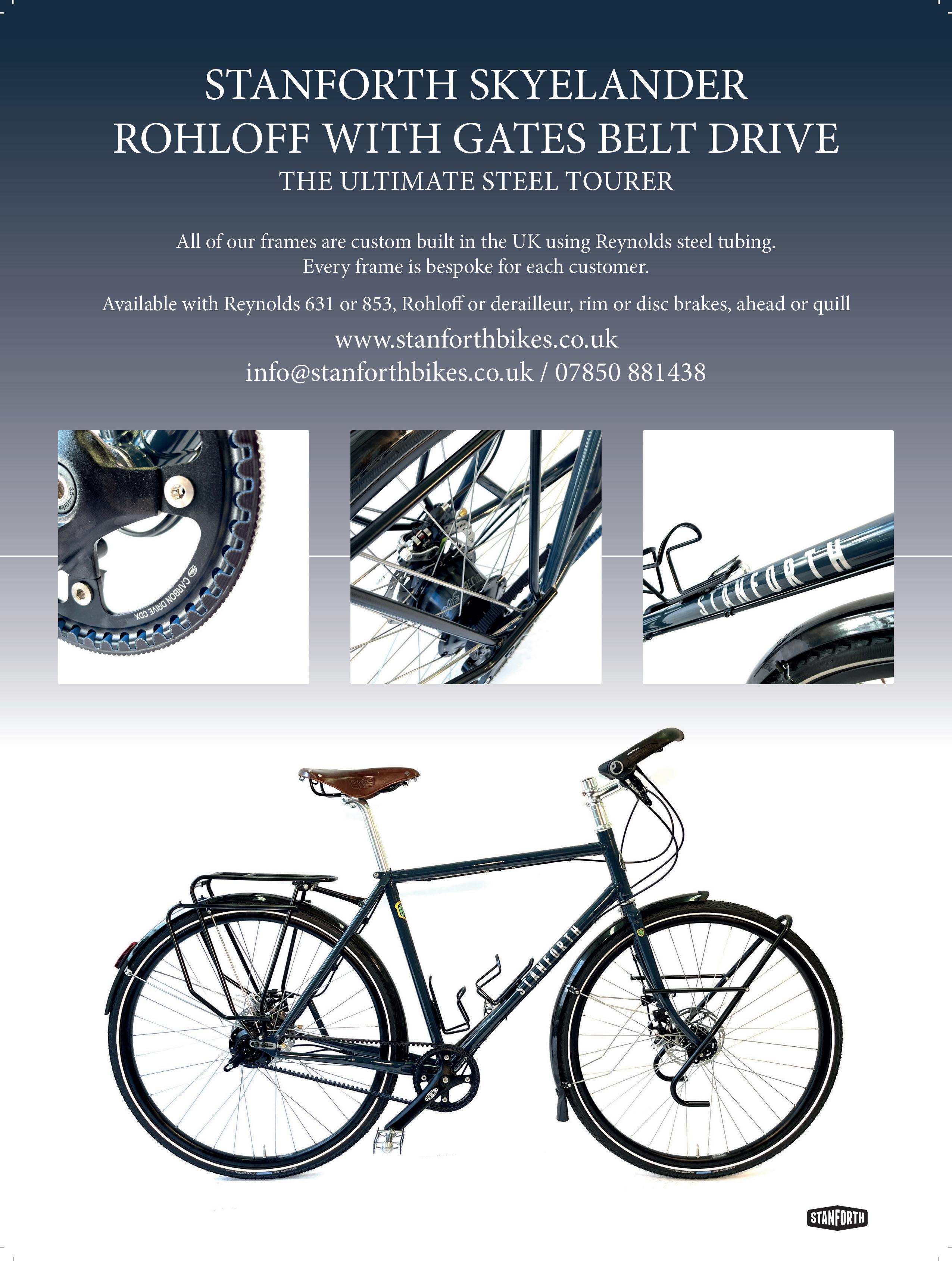
Gearup
COMPONENTS, KIT, AND MEDIA SELECTED AND REVIEWED BY BIKE JOURNALISTS AND CYCLING UK STAFF
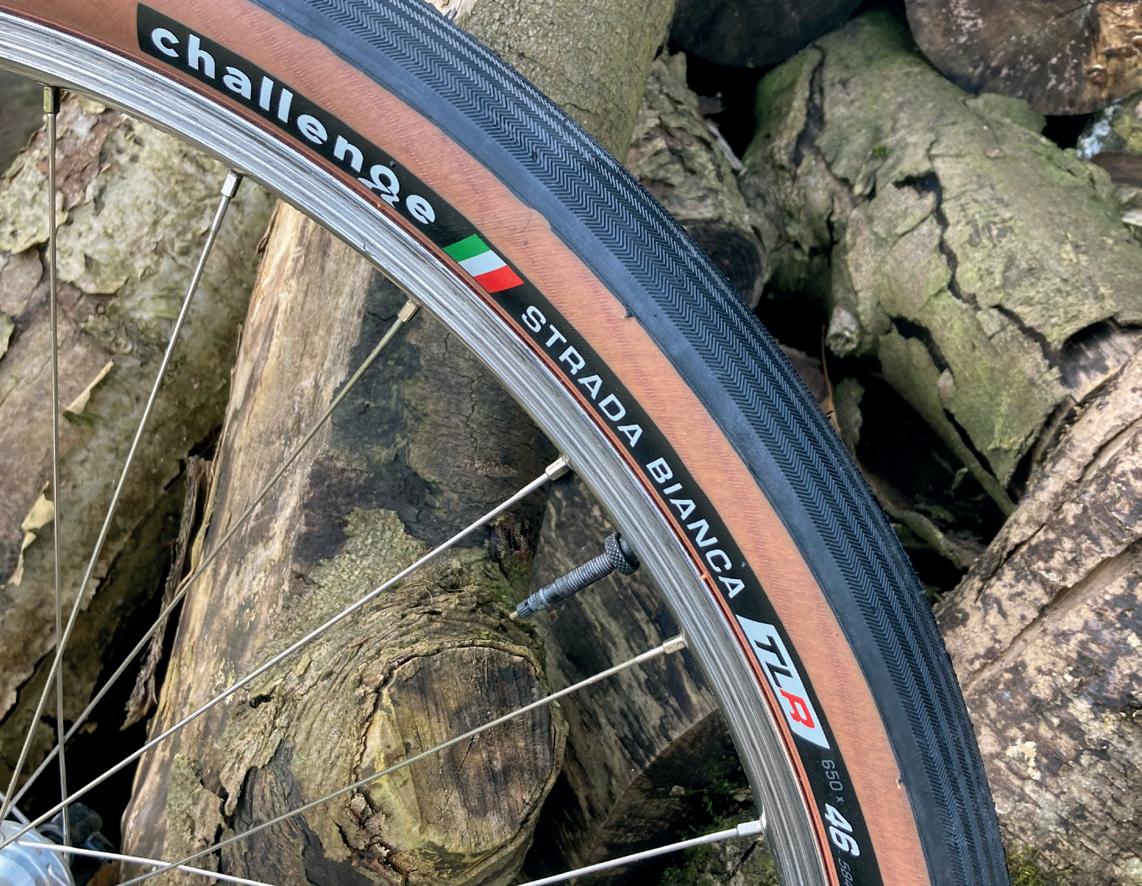
Strada Bianca
tyre
Few tyres look as inviting as a Challenge Strada Bianca 650B freshly installed on a rim. It’s one of many Challenge Strada Bianca tyre models, all with the same traditional and effective tread pattern, all but one of them made to fit 700C or tubular rims and many of them using a handmade clincher carcass in the ‘open tubular’ style.
This model has instead what is termed a ‘nylon superlight vulcanized’ carcass with 120tpi thread count. It inflates
to a slender 43mm wide on a 22mm Pacenti Brevet tubelessready rim. Not only is it a little narrower than the stated 46mm, but at 440g it’s slightly heavier than the claimed 420g. Even so, it’s a light tyre for the width – the 700×45C version is said to weigh 550g – thanks largely to its minimal tread and that smaller 650B size.
Fitting to said Pacenti rims was a cinch, the beads popping smartly into place under pressure. Both tyres then retained air for several minutes
but required the addition of sealant before they would stay up long enough to ride. The sidewalls proved porous enough to let some sealant ooze through when it was swilled around. Although both tyres then stayed inflated for several hours, both repeatedly lost significant air overnight despite extended efforts to spread the sealant around.
As ever, another rim might give another result, and Challenge recommends Challenge Smart Sealant, which may stick more effectively to the waxy, vulcanised surface of the carcass than the Continental sealant I used. The manufacturer suggests an inflation pressure of 1.5-2.5bar, or 21-35psi, with a maximum of 58psi. I tested at 32/40psi front/ rear on a variety of surfaces.
Unsurprisingly, given the barely perceptible tread, mud does not feature in the tyre’s list of recommended surfaces. Cobbles, hardpack, ‘pavement’ and gravel, ideally white and Tuscan, do. This is a tyre for all roads rather than off road, although the herringbone pattern is proven to work well in wet conditions.
Weight and low inflation pressure soften the Strada Bianca’s performance on smooth roads, but throw in a bit of roughness and the voluminous tyre is in its element, swallowing bumps, stones and ridges with gusto while delivering plentiful grip, wet or dry. And it looks good while doing so.
Richard Hallett
Put to the test
Is there a product you’d like us to test? Write to: Cycle, Cycling UK, Parklands, Railton Rd, Guildford, GU2 9JX or editor@cyclinguk.org
Other options
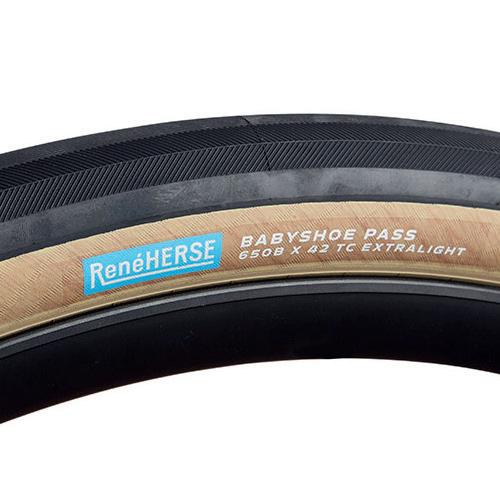
RENE HERSE
BABYSHOE PASS
£82
Fast-rolling, lightly treaded tubeless-ready 650×42B tyre in several versions, including a 380g Ultralight. svencycles.co.uk

PANARACER GRAVELKING SLICK
TLC
£49.99
Light but easily punctured, supple, tubeless-ready flyer in three 650B sizes and one 700C. panaracer.co.uk
Verdict
Big air volume and a lightweight tread make this a real joy on cobbles or hardpack, while remaining a more than adequate performer on smooth asphalt.
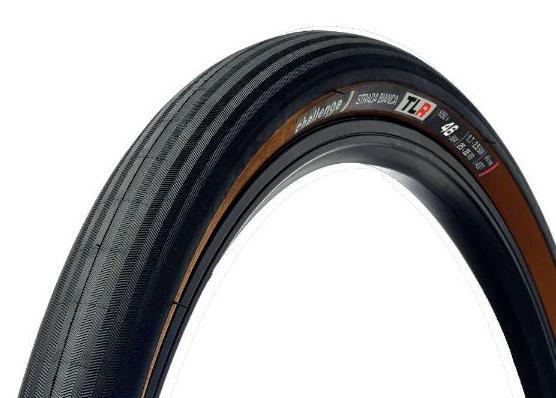
Reviews 22 cycle JUNE/JULY 2024
Cycle’s test promise At Cycle, we are proudly independent. There’s no pressure to please advertisers as we’re funded by your membership. Our product reviews aren’t press releases; they’re written by experienced cyclists after thorough testing.
650×46B TLR
£57 challengetires.com, upgradebikes.co.uk Wide and smooth-rolling all-roads tyre that also comes in 700C Challenge
Pros & cons + Fast and grippy tread + Plush ride - Overnight air retention

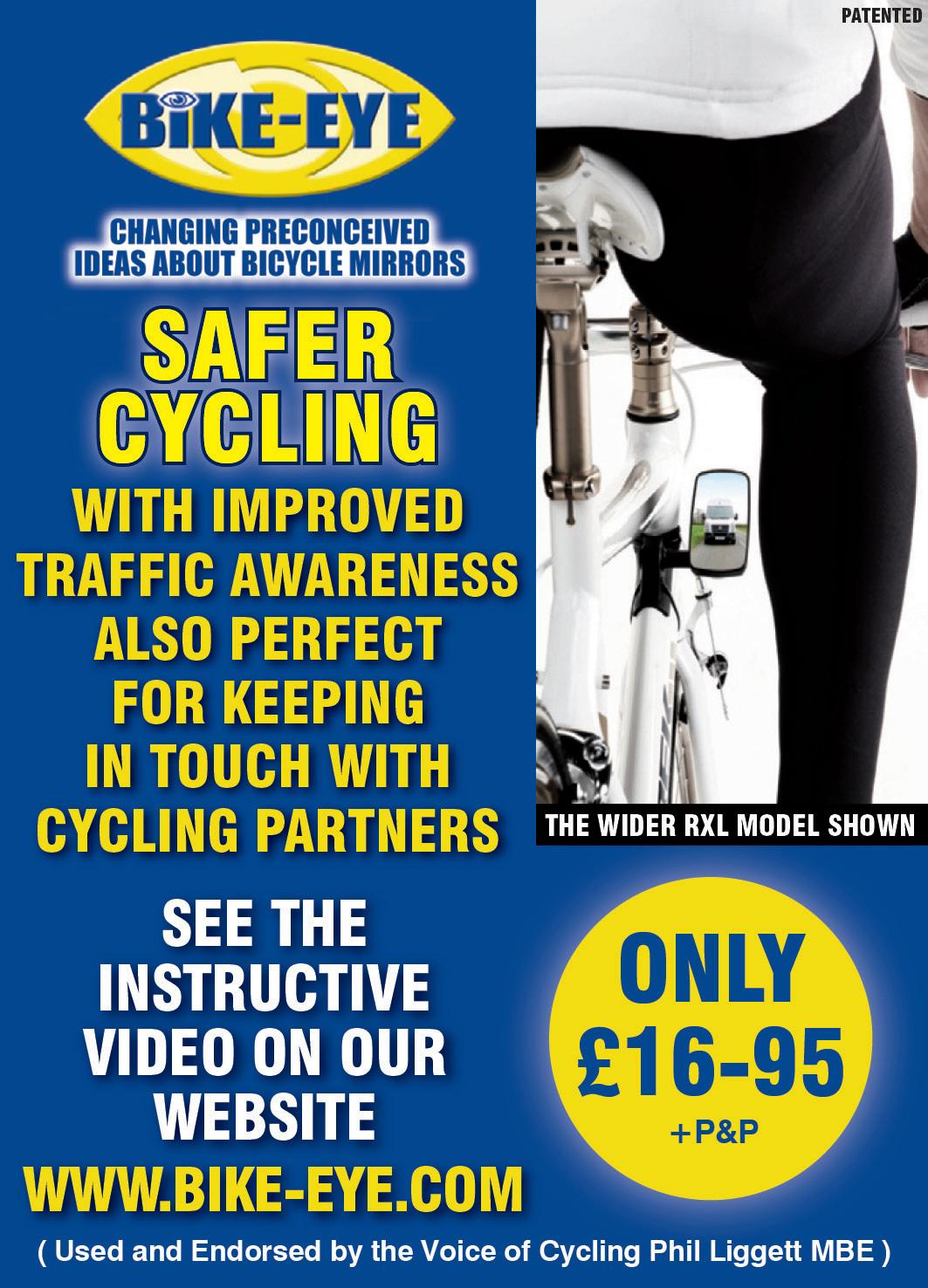




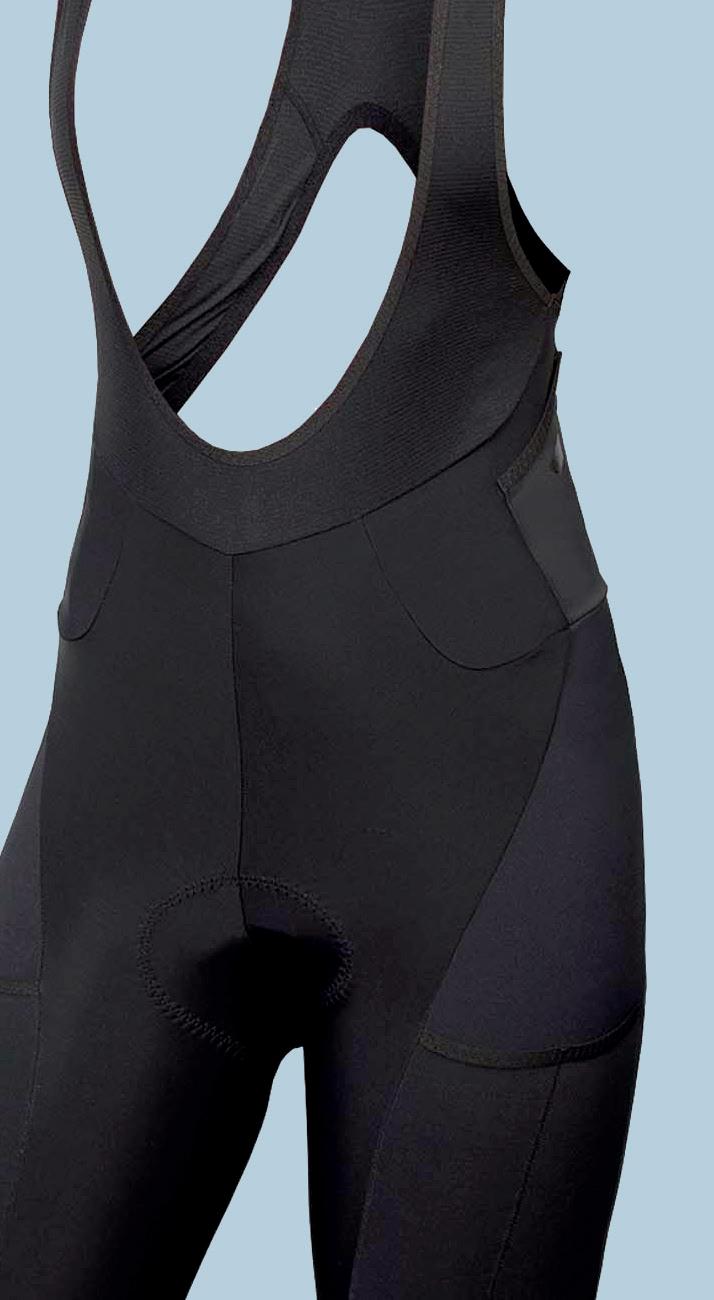


to find a pair that is perfect for your needs.
I tried sizes M and L in these shorts. Both fitted but I ended up wearing the M the most, as I found both pairs rather long in the leg. The leg cuffs did feel great on the thigh and were secured well by the grippy material on the inside. I tend to prefer the cuffs slightly higher than they sat, but this is personal preference. It’s all about finding the right design for your shape. If you have slightly shorter than average but quite athletic legs, you might find these shorts a little too long and thin.
After seeing these shorts modelled by lots of cyclists at local café stops, I was excited to get my hands on a pair and try them for myself. My initial thought when they arrived was how high quality they were. The material feels smooth and premium, and the seams are well stitched. They look very ‘pro’.
I’ve not owned a pair of bib shorts with pockets before; I am now very much sold. Gone are the days of cramming endless miscellaneous items into my jersey pockets. There is ample room in the two leg pockets for
a phone or some snacks. While stretchy, they hold items well, and I wasn’t worried about losing things mid ride.
Most importantly to note: the shorts’ ‘800 series conform EGM pad’ is substantial. I felt that this offered a good level of protection, and it seemed to dissipate the usual pressure points. Finding the perfect shorts for you is a very individual process. The padding is quite bulky. While adding comfort, I found it a little too bulky for my shape. Endura does, however, offer a 90-day satisfaction guarantee, which is a great way
The bib section of the shorts is very comfortable and sits well on the skin. There are also another two small mesh pockets built in. I found the shorts easy to manoeuvre for comfort breaks. They have been designed in a way that there are no unnecessary steps required to rearrange straps or tuck in extra material – unlike other bib shorts I’ve used. Sizes: XS-XL. (Men’s version comes in S-XXL.)
Pip Munday
Verdict
If you’re looking for a premium pair of shorts with plenty of storage and a quality feel, these are a definite contender. Although the sizing wasn’t perfect for me, these are by far the nicest pair of shorts I’ve cycled in, and I believe the price tag is justifiable.
Other options


LUSSO WOMEN’S TERRA BIB SHORTS
£135
Made in Manchester, these shorts have stretchy, mesh straps and a high-volume, abrasion-resistant pocket on each thigh. lusso.bike

ALTURA PROGEL PLUS WOMEN’S CARGO CYCLING BIB SHORTS
£75
Good value for cargo bib shorts, these have a mesh pocket on each thigh. They also have some reflective detailing. altura.co.uk
24 cycle JUNE/JULY 2024 REVIEWS GEAR UP
Reiver
Women’s GV500
Bibshort
£139.99 endurasport.com Cargo bib shorts suitable for any ride, not just gravel Endura
comfort breaks
Pros & cons + Practical pockets + Easy
- Sizing won’t suit all


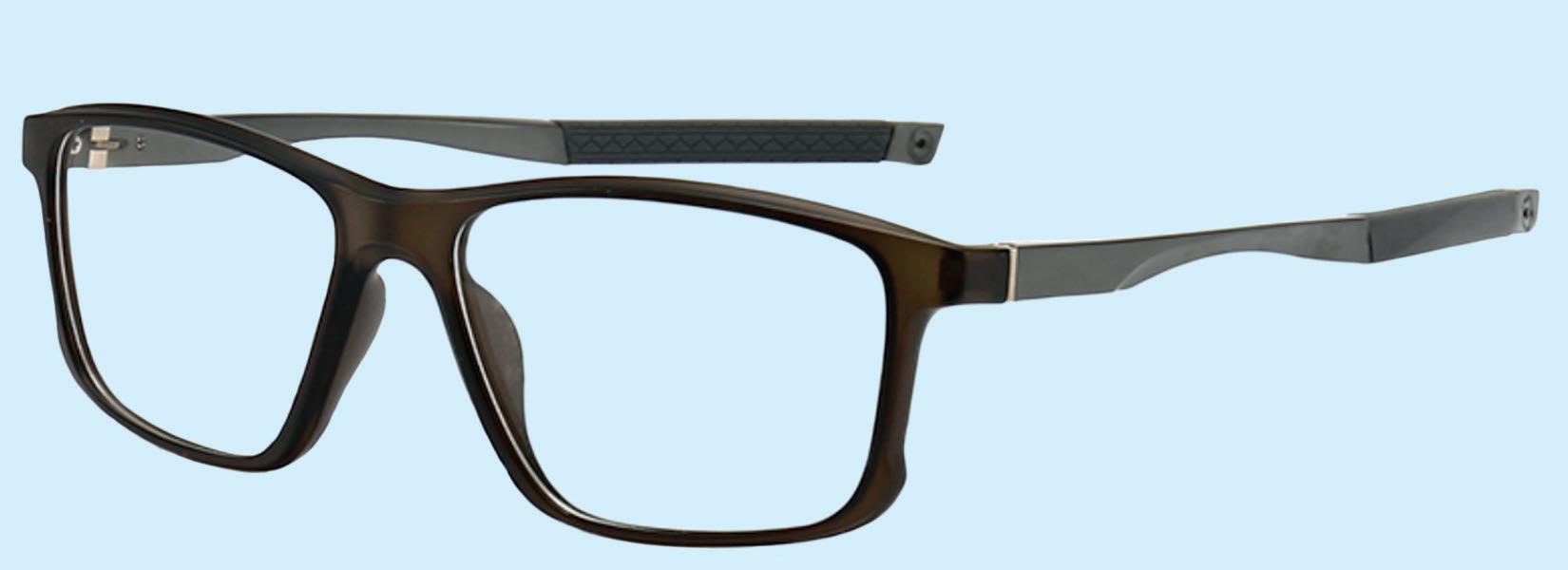

Pros & cons
+ Comfortable
+ Look good off the bike - Not the most secure
Cycling-specific prescription glasses tend to stay on your face better than generic spectacles, as well as shielding your eyes from wind and debris more effectively. The downside is that they can be very expensive.
I was quoted an horrendous price for some Oakleys by a high street optician – and that was just the frames. But there are online retailers selling prescription sports glasses for sensible sums.
I’m on my third pair of Rapide glasses from Optilabs (having broken the others when I wasn’t

wearing them). NowYouSsee offers a similar online service. You fill in a questionnaire, pick a frame style and lens type, and send your prescription. Your glasses arrive by post.
The HDsport is a new model with integral prescription lenses rather than clip-ins. Although aimed at cyclists – “road, trail or commute”, the blurb says – the styling is more ‘lifestyle’ than ‘insectoid wraparound’. This isn’t important for me as I put on distance glasses specifically for cycling (and occasional driving) but it’s a bonus for anyone who wears their glasses all day.

I tested HDsport glasses with clear lenses, since I also ride at night, and a single-vision prescription (+£45). Scratch and glare resistance treatments are included in the price. A ‘racing red’ tint (+£59) and light-adaptive lenses (+£89) are available, as are other prescription types such as varifocals. Frames are grey, red, blue or green. The total price of the glasses I tested is £144, which compares to £170.95 for my latest Rapides – whose scratch and glare resistance cost extra. So the HDsports are good value even before you factor in your 15% Cycling UK discount.
The lens quality and prescription accuracy seems directly comparable to my Rapides. I thought wind might get around the lenses but it didn’t seem to. What was a problem was the lack of security off road. They kept slipping down my nose and I was worried they’d fall off entirely. The nose pads have relatively little grip and would benefit from a ‘nose wax’ like Nerdwax to help them stay put.
The arms also have a lighter hold on the side of my head than the Rapides, even after adjustment. This is a two-edged sword: they’re more comfortable to wear for longer periods but it made them impractical for mountain biking. They were fine on road, although I still preferred the firmer fit of the Rapides.
Dan Joyce

OPTILABS RAPIDE
£145.95+
Good wraparound design and they always stay put on your face, even when mountain biking. Base price includes prescription lenses (clear or tinted). optilabs.com
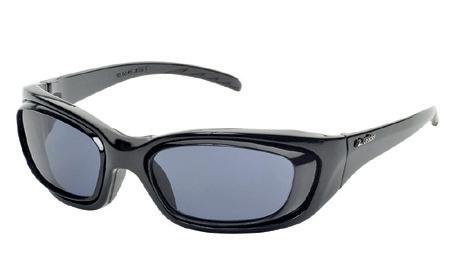
EYEPOD RIDER
£129+
Price is for a single-vision prescription. Bifocal and varifocal are also available, as are various tints and lens types (polarised, mirrored and so on). sportsglasses.online
Verdict
Good value, casualstyle sports glasses that are comfortable to wear and don’t look conspicuously bikey when you’re not cycling. For me they worked fine for road rides and urban cycling but not mountain biking.
26 cycle JUNE/JULY 2024
REVIEWS GEAR UP
HDsport £144 as tested nowyousee.co.uk Casual-style prescription
glasses NowYouSee
cycling
Other options

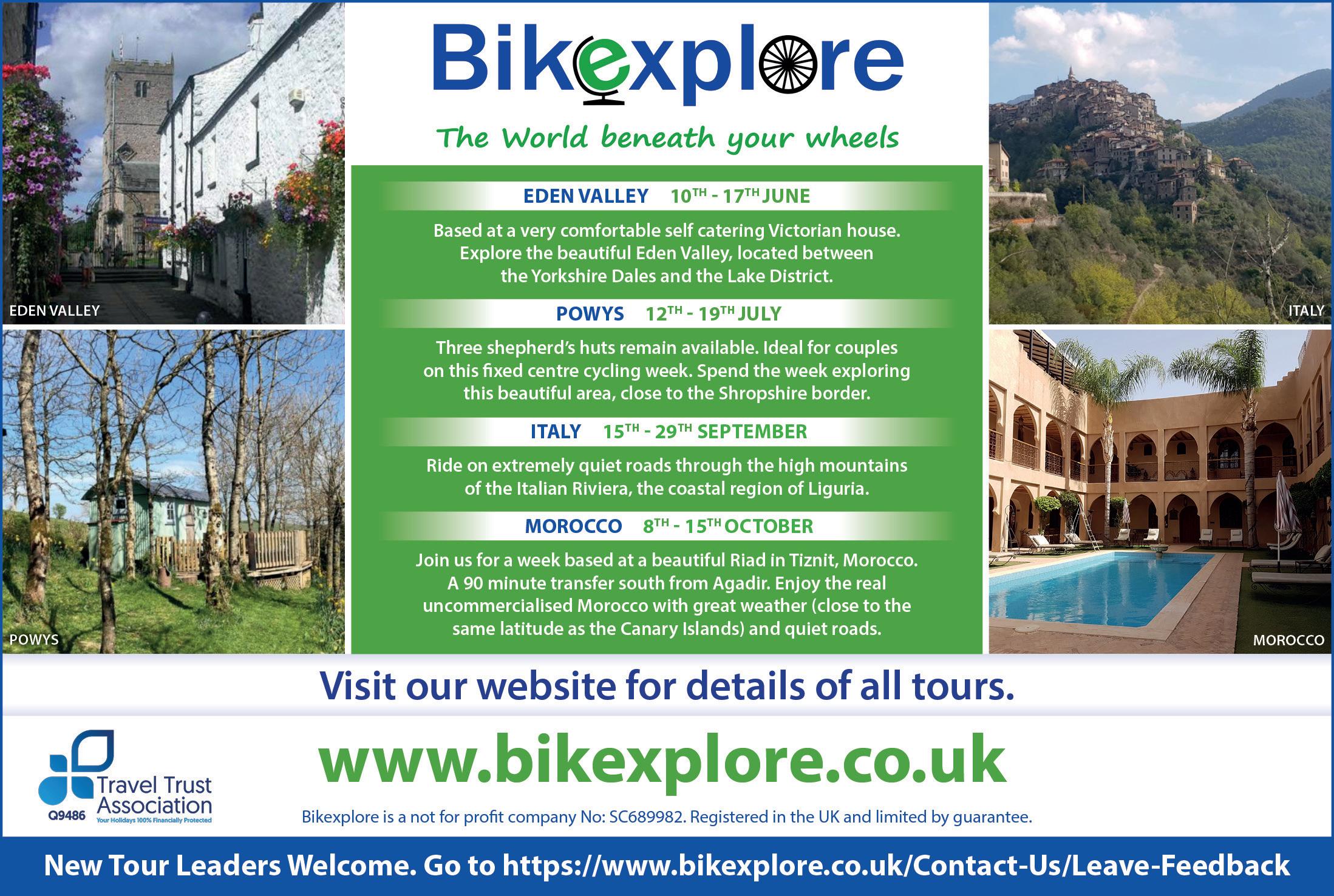
Books
CYCLING INSPIRATION WHEN YOU’RE STUCK INSIDE
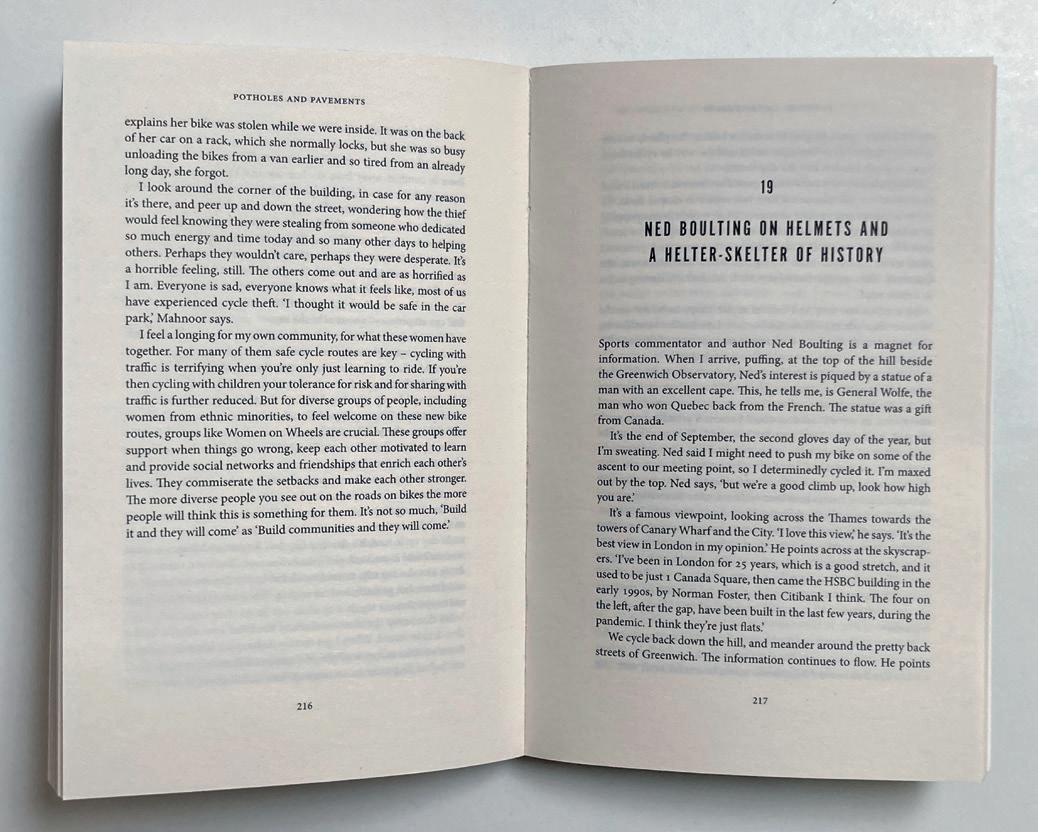
Potholes and Pavements
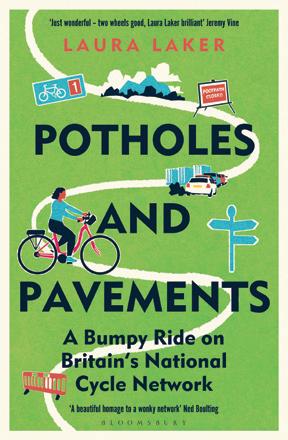
Details
By: Laura Laker
Publisher: Bloomsbury
Price: £16.99
ISBN: 9781399406444
POTHOLES AND PAVEMENTS IS the story of journalist Laura Laker’s post-lockdown attempt to reconnect with cycling using the National Cycle Network (NCN).
My initial expectation was to read stories of getting out into beautiful areas using the NCN. While such stories are included, this is also an account of the remarkable history of how the NCN came to exist in the first place, highlighting how much work was done by so few people.
I’ve had a troubled relationship with the NCN over the years. Persuading councils to take better care of my local sections of it has been an uphill battle, so the context to how it came into being – with a mish-mash of grants, money from public bodies and sometimes sheer bloodymindedness – was eye-opening.
Most of Laura’s trips around the UK take place on her trusty e-bike. There are the expected tales of our archaic system for taking bikes on trains, and the variable quality of the NCN routes themselves. However, her experiences also serve as reminders that if you’re willing to get past those issues, there are beautiful days on the bike and some stunning scenery to look forward to.
The book gives a sense that the NCN has achieved all it can with it its current funding model, and Laura proposes a number of sensible suggestions for ways forward. Unfortunately the barriers to most of these are government and public buy-in. While that’s a sobering thought, it’s a good manifesto for our future campaigning efforts. Gethin Pearson
You can read excerpts from some of the books that Cycle has reviewed at cyclinguk.org/cycle-book-excerpts

Details
By: Mike Wells
Publisher: Cicerone
Price: £17.95
ISBN: 9781786312198
Print queue
Cycle doesn’t feature all books received. Reviewers pick the ones they think you need to know about from the editor’s list. Send books to: Cycle, Cycling UK, Parklands, Railton Rd, Guildford, GU2 9JX
Cycling the North Coast 500
I WISH THIS book had been available when I rode the NC500 in 2017. Its pocket size, detailed maps, elevation profiles and colourful pictures would have been helpful – especially to one of our group who had no idea where he was! I like that this guide provides alternative route options and advice to help plan your trip and get a feel for the north before you start attacking the hills. Also, if your itinerary allows, Mike Wells has done the research about interesting places to visit en route.
Jim Densham

Details
By: Andrew Barlow
Publisher: Vertebrate
Price: £15.95
ISBN: 9781839811845
Gravel Rides Lake District
OFF-ROAD CYCLING in the Lake District can be challenging to plan. There are miles of bridleways but you can’t tell from a map which are gravel, which are faint moorland trails and which are rocky chutes beloved of mountain bikers. Andrew Barlow’s well written and beautifully photographed guide details 15 gravel rides from 17 to 270km, which will appeal to riders of all ages and abilities. They vary in surface but they’re all doable on a gravel bike, and all have OS maps in the book and downloadable GPX files. It’s a delight of a book.
Sean Fishpool
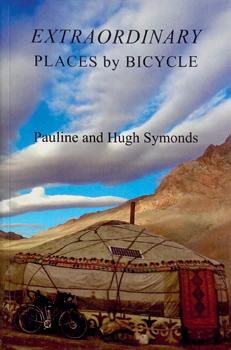
Details
By:
Pauline and Huw Symonds
Publisher: Hayloft
Price: £30
ISBN: 9781910237755
Extraordinary Places by Bicycle
WE’VE JUST LEFT Cumbria – can we make it to Mongolia? So begins one of Pauline and Hugh’s many epic cycle trips, travelling 60,000km over 10 years. While some of their adventures might seem a bit too intrepid, like crossing 2,500m mountain passes in the depths of winter, it’s a joy to join them for the ride. Their affable writing sketches vivid pictures of places and people, and is bursting with useful insights about cycle touring in different countries.
Sophie Gordon
28 cycle JUNE/JULY 2024 Reviews
Excerpts
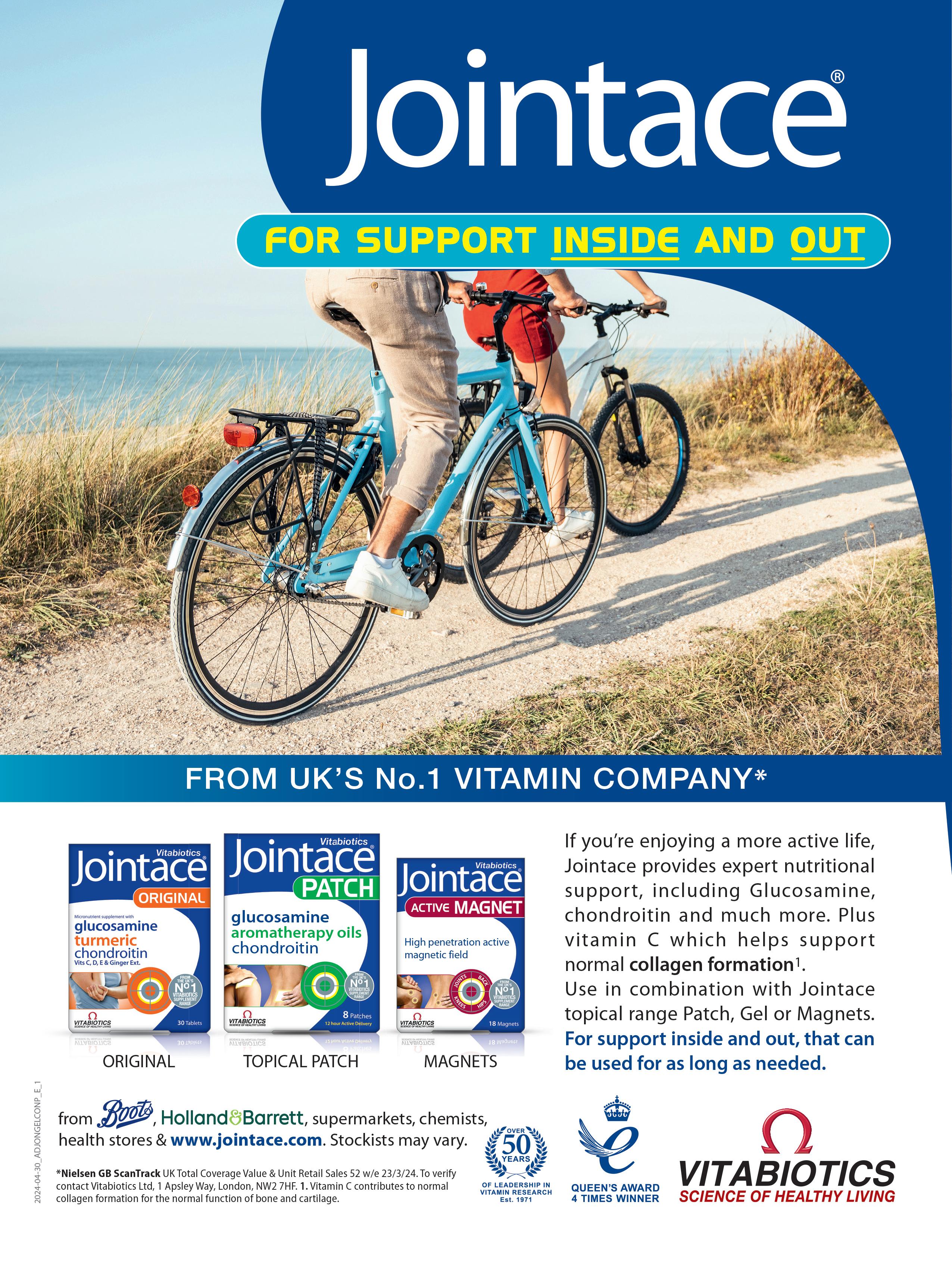


THIS MONTH FIXED-WHEEL FACTS, BIKES (BUT NOT TRIKES) ON TRAINS, BACK PAIN, KIRKPATRICK MACMILLAN, AND MORE

Letter of the month
MISCONCEPTIONS FIXED

IGet in touch
LETTERS are edited for space, clarity and, if necessary, legality. The editor reads and automatically acknowledges all letters but publishes only a selection. Feedback for the next issue must arrive by 28 June. Please include your membership number.
WRITE TO: Letters, Cycle, Cycling UK, Parklands, Railton Rd, Guildford, GU2 9JX or email editor@cyclinguk.org

CYCLING vs SCIATICA
t’s quite some time since I last saw a letter regarding fixed-wheel cyclists but back in the ’70s such a letter did appear, criticising the use of a photograph of three cyclists whom the writer thought were riding fixed-wheels and therefore must be racers.
The photograph was taken by the late Tim Hughes on 13 February 1977 as we cycled above the Llyn Brianne reservoir. I know this because I am the cyclist on the front nearside. As it happens, the writer was right: we were riding fixedwheel bikes. But I hadn’t raced since the early ’60s, and the only one who might have raced would have been Tim’s wife Audrey, who was tucked in at the back.
When I first joined the South Bucks DA in 1954, I suspect about a third of the members rode fixed all year round, and only a few of them ever raced. The big advantage fixed wheel has is that it can be used as a third brake. On icy winter roads it’s a far more subtle way of slowing to a stop.
I only wish I had the legs to ride fixed still but, living in the Chiltern Hills, the 66-inch gear I used to tour on would not get me very far now in my mid-eighties. While I may have given up on fixed, I’m still riding using ever lower gears and haven’t got round to an e-bike yet. It’s a case of use it or lose it!
Mac Crombie

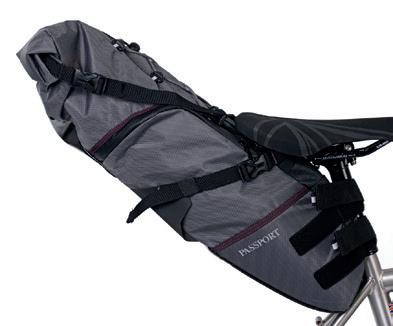
The letter of the month wins a Passport Saddle Pack, courtesy of Ison Distribution. This 9.8-litre roll-top bikepacking bag has a waterproof liner to keep your kit dry and a wipe-clean tarpaulin base to shield you from mud. There are two external pockets for keys or tools, and the seatpost strap is rubberised to keep the bag stable. For more about the whole range of Passport bikepacking luggage, visit passportcycles.co.uk
Regarding the query about sciatica in the April/May issue: I also had either this condition or piriformis syndrome; there was no clear conclusion from various professionals. I found I could continue cycling; stopping and dismounting was the problem. I didn’t sit in a chair for three months. I was doing the Transcontinental Race (my bike is pictured) and my training obviously suffered. I started the race not knowing whether I would last the first 24 hours. It turned out to be the best treatment: 325km a day for 13 days, during which I stopped taking painkillers and almost forgot the ailment. It returned once I got off the bike, but not to the same level and continued to improve afterwards. I’m sure every case is different, but cycling was my saviour. There’s more on my blog: richardgate.wordpress.com Richard Gate
PASS NOTES
I applaud the letter from Rosy Gray (Caught on camera, Feb/Mar issue). Just one minor niggle: her last sentence refers to “the increasing incidence of inconsiderate driving”. My own experience of 40 years’ cycle commuting is that since the change in the Highway Code drivers are, on average, passing with significantly more room. I didn’t expect this, but the message appears to be getting through – and thanks are due to Cycling UK for promoting it.
John Morfey
Opinion CYCLINGUK.ORG cycle 31
Letters Stay connected facebook.com/CyclingUK @wearecyclinguk cycling@cyclinguk.org editor@cyclinguk.org
Win a Passport Saddle Pack worth £69.99
1970s’ fixies
Left: Tim Hughes
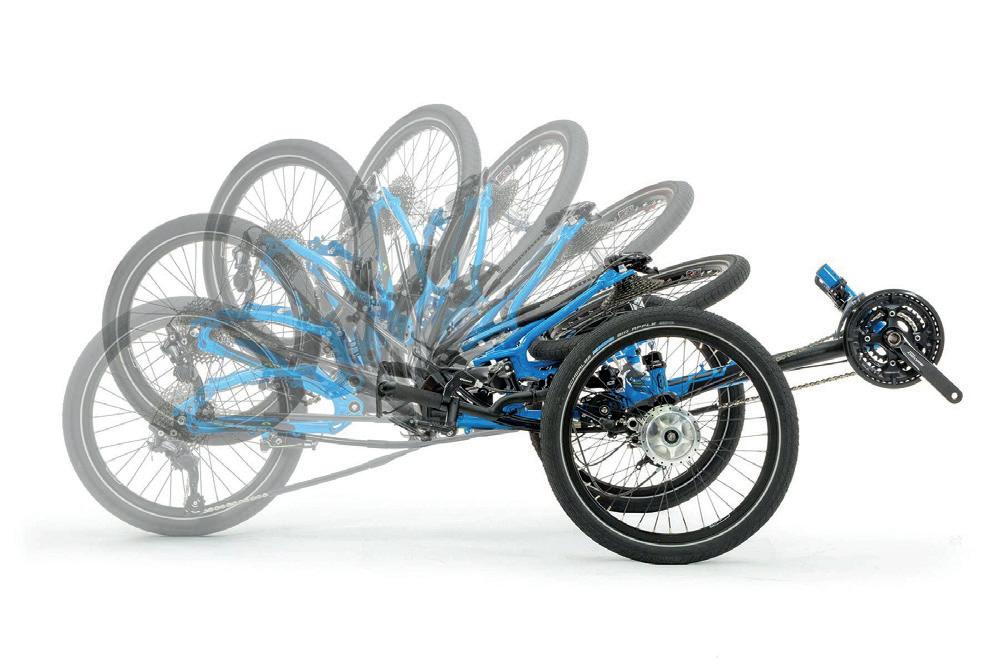

TRIKES AND TRAINS
I would like to support all the points Simon Holmes made in his letter in the April/May edition. It is hard enough to get bikes on trains, particularly when the almost inevitable cancellation of a train occurs. However, I would like Cycling UK to spare a thought for those of us who use unusual cycles, often due to disability or to transport children. I have not been able to get my tricycle on a train.
To quote Network Rail: “I regret to inform you that tricycles are not usually carried unless otherwise permitted under a Train Operating Company’s cycle policy.” I have yet to find a rail company I have access to that has a policy to allow my trike on a train, even for disability purposes. If we want to see more people cycling, surely Cycling UK should be supporting more cycle places on trains – including those for unusual cycles.
Jim Hope
E-BIKE FORK FAILURE
Two months ago I had an unusual cycling accident, from which I am still recovering. I was cycling along a quiet road when the steerer tube sheared at the fork crown, sending me over the bars face down onto the road. I was taken by ambulance to hospital.
I had had the bike (a Marin) converted to an e-bike by Cytronex. Marin says the bike’s frame warranty is void because of the conversion. Cytronex said the bike was suitable for their conversion. The bike was a specified item on our Admiral house insurance policy yet no one is accepting liability and Admiral refuses to pay out. I am advised that there is no chance of winning any legal case.
Engineers and cycle mechanics have concluded that the accident was caused by metal fatigue of the
fork crown. I wonder if any of your readers have also had any catastrophic failures with an e-bike conversion, and lack of acceptance of any liability?
Dr Bob Broad
REWRITING HISTORY?
I disagree with Nicholas Oddy’s stating (Book review, Feb/Mar issue) that the Macmillan story is a myth. Andrew Ritchie’s book, ‘The Origins of the Bicycle’, contains 50 pages of transcribed 19th century source material, intended to be complete, making it easy to follow his analysis. He does not rely on the only contemporary evidence, the useless 1842 Glasgow newspaper article, but on all the non-contemporary evidence considered during the British cycling fraternity’s ~1890 investigation. Oddy seems to be saying that lack of contemporary evidence is evidence of lack. However, Ritchie is convinced that: (i) there is too much other evidence, too consistent to be ignored; and (ii) Macmillan built a bicycle, based on witness statements that he added driving gear to a hobby horse. The evidence persuades me to agree. Does Oddy have new evidence which backs his assertion that “the Macmillan story is bogus”?
Chris Jeggo
Nicholas Oddy will certainly have backed up his assertion in his talk, ‘Kirkpatrick Macmillan, the inventor of the pedal cycle or the invention of cycle history?’ at the 1st International Cycling History Conference in Glasgow in 1990. When I was looking for a reviewer for the Macmillan book, I asked cycle historian Tony Hadland, co-author of Bicycle Design. “No one,” he told me, “knows more about Macmillan than Nicholas Oddy.” That’s good enough for me!


Photo of the month

TGV CYCLE CARRIAGE
Here’s my unbagged bike on a TGV (Paris-Lyon) for the first time. Some TGV units now have a luggage space in coach eight dedicated to bikes. You can only book it with an SNCF ticket; the €10 fee is added to the ticket price. To see which trains have spaces, select the ‘with bicycle’ option at sncfconnect.com. There were also people on my train with dismantled bikes in bags. No charge for that. Clive Parker
CYCLING UK FORUM
Get immediate feedback from other members at forum.cyclinguk.org. Here’s an abridged extract from a recent thread: cyclinguk.org/ how-do-you-carry-big-shopping
HOW DO YOU CARRY BIG SHOPPING?
plancashire: How do you shift big shopping? I use a Burley Travoy trailer. Detached from the bike, it is a good shopping trolley. diapason: Carry Freedom Large Y-trailer behind either my ICE or F-frame Moulton. Black recycling box holds a week’s shopping.
Nearholmer: We cheat, by living about a mile from the shops, so barely ever fetch more than a pannier’s-worth.
PH: I have a trailer but hardly ever use it. I live in a first-floor flat and getting the trailer out is a bit of a faff. I have a bike with rack sturdy enough to take the load and some big panniers.
Pendodave: I don’t do large objects but I did have 22kg split over two panniers coming back up the hill from Sainsbury’s last week.


gaz: For many years, a pre-loved Raleigh Mule and a pair of ancient Carradice panniers. Last year I treated myself to a Black Friday deal on a Burley Nomad. willp01908: I use a Topeak Journey trailer. I like the single wheel – on the cycle tracks in MK, there are bollards all over the place. pjclinch: I tend to do little and often with just panniers on a more conventionally sized bike, but when it’s something big or quite a lot it’s the 8-Freight cargo bike.
bohrsatom: My Tern HSD has two 37-litre panniers which are more than enough to swallow a big shop, and I attach bulkier stuff to the rack with a couple of ROK straps. For really large loads I have a Burley Flatbed trailer. I’ve used it to carry all sorts of stuff, such as a coffee table.
32 cycle JUNE/JULY 2024 Left: Getty Images. Top: icetrikes.co
LETTERS YOUR FEEDBACK
Even folding trikes are seldom allowed
Contemporary evidence is absent
Advertorial FIVE ICONIC CYCLING ROUTES IN EUROPE
Discover Europe’s premier cycling destinations with Cicerone Press, the go-to publisher for adventurers. With nearly 400 guidebooks featuring crystal-clear maps and expert advice, planning your next adventure has never been easier.
Exploring Europe by bike is a fantastic way to immerse yourself in the continent’s rich cultural and natural heritage. With excellent cycling infrastructure catering to cyclists of all levels, there’s an adventure waiting for everyone. Here, we showcase five of the best cycle touring routes in Europe, each offering something unique, from delicious food to breathtaking scenery.
1The Danube Cycleway
Experience riverside cycling along the beautiful blue Danube
Some of Europe’s most picturesque riverside cycling is found on the popular Danube Cycleway. Stretching 2,888km from Germany’s Black Forest to Romania’s Black Sea coast, it passes through Germany, Austria, Slovakia, and Hungary, with stops at Vienna, Bratislava, and Budapest. Whether tackling the full route or a shorter segment, this route offers mostly level and straightforward cycling, perfect for a leisurely exploration of the Danube.
2 Route des Grandes Alpes
Embark on a mountainous adventure
Experienced cyclists seeking a more mountainous adventure can conquer the towering peaks and breathtaking passes of the Route des Grandes Alpes. Spanning 720km from Lake Geneva to vibrant Nice, the route boasts unparalleled beauty and a


rich mountain culture. Although plenty of charging points are available for e-bikes, good fitness is essential – the climbs were made famous by the Tour de France, after all.
3 Ruta Via de la Plata
Immerse yourself in Spain’s cultural heritage
For a ride steeped in history, the Ruta Via de la Plata allows you to immerse yourself in Spain’s cultural heritage along one of its most important pilgrim routes. Covering 930km from Seville to Gijón, cyclists can explore eight UNESCO World Heritage sites and several notable towns and cities. With mainly empty roads and gentle climbs, this route caters to cyclists of all skill levels, ensuring a memorable journey through Spain’s rich and storied past.
4 Canal du Midi
Indulge in a gastronomic journey
Delicious food and wine is as compelling a reason as any to embark on a cycling adventure. The Canal du Midi offers a gastronomic journey through the heart of the French countryside, with flat, easy cycling along tranquil waterways, shaded by towering plane trees and bordered by scenic
CYCLING UK MEMBERS GET 20% OFF guidebooks and e-books at Cicerone www.cyclinguk. org/memberbenefits

vineyards. The 240km route is divided into five manageable sections, with numerous local festivals enhancing the culinary journey along the way.
5 Wild Atlantic Way
Explore Ireland’s dramatic coastline
The Wild Atlantic Way is one of the world’s longest signed coastal routes. It runs for 2,450km down the west coast of Ireland from Derry/Londonderry to Cork. Quiet roads wind alongside deserted beaches and tiny harbours before climbing over mountain passes and passing countless historic sites. There’s fantastic maritime heritage to explore, plus windswept cliffs, sandy beaches, and picturesque fishing villages.
More Information
With Cicerone guidebooks, cyclists can access detailed route descriptions, mapping, preparation advice and information on facilities for all routes, ensuring a smooth and enjoyable ride. You’ll find more inspiring articles and the full range of guidebooks at cicerone.co.uk .
CYCLINGUK.ORG cycle 33 XXXXXXXXXXX ADVERTORIAL CICERONE ADVERTORIAL
All images © Cicerone Press. ‘Ruta Via de la Plata’ from Cycling the Ruta Via de la Plata, 2022, by John Hayes; The Danube Cycleway from The Danube Cycleway Volume 1 2019, by Mike Wells; ‘Route des Grandes Alpes’ from Cycling the Route des Grandes Alpes, 2022, by Giles Belbin.
Ruta Via de la Plata
The Danube Cycleway
Route des Grandes Alpes

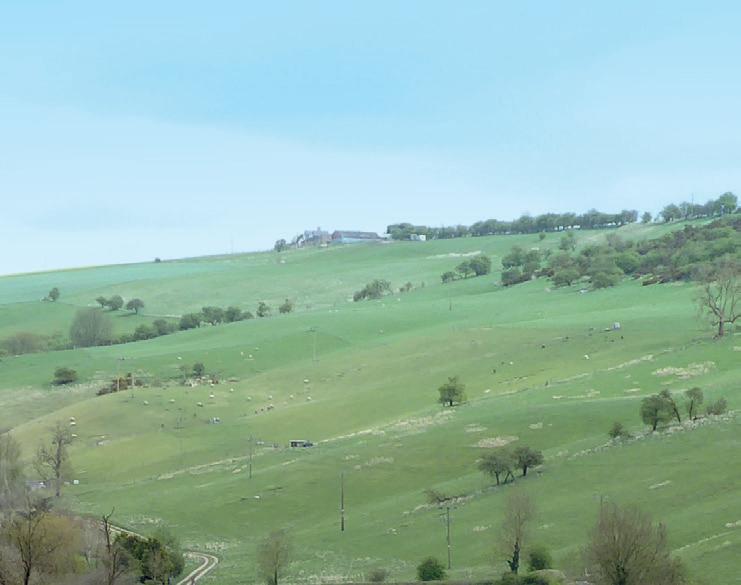


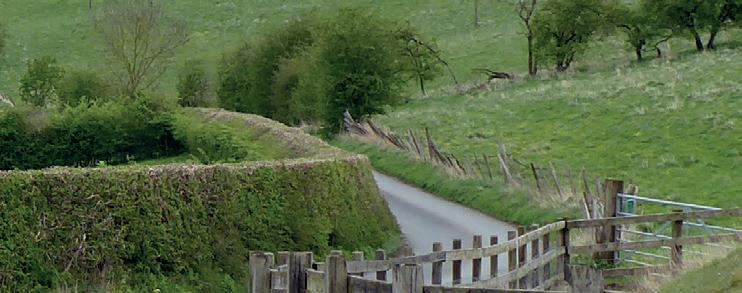
Rides
CYCLING BACK IN TIME

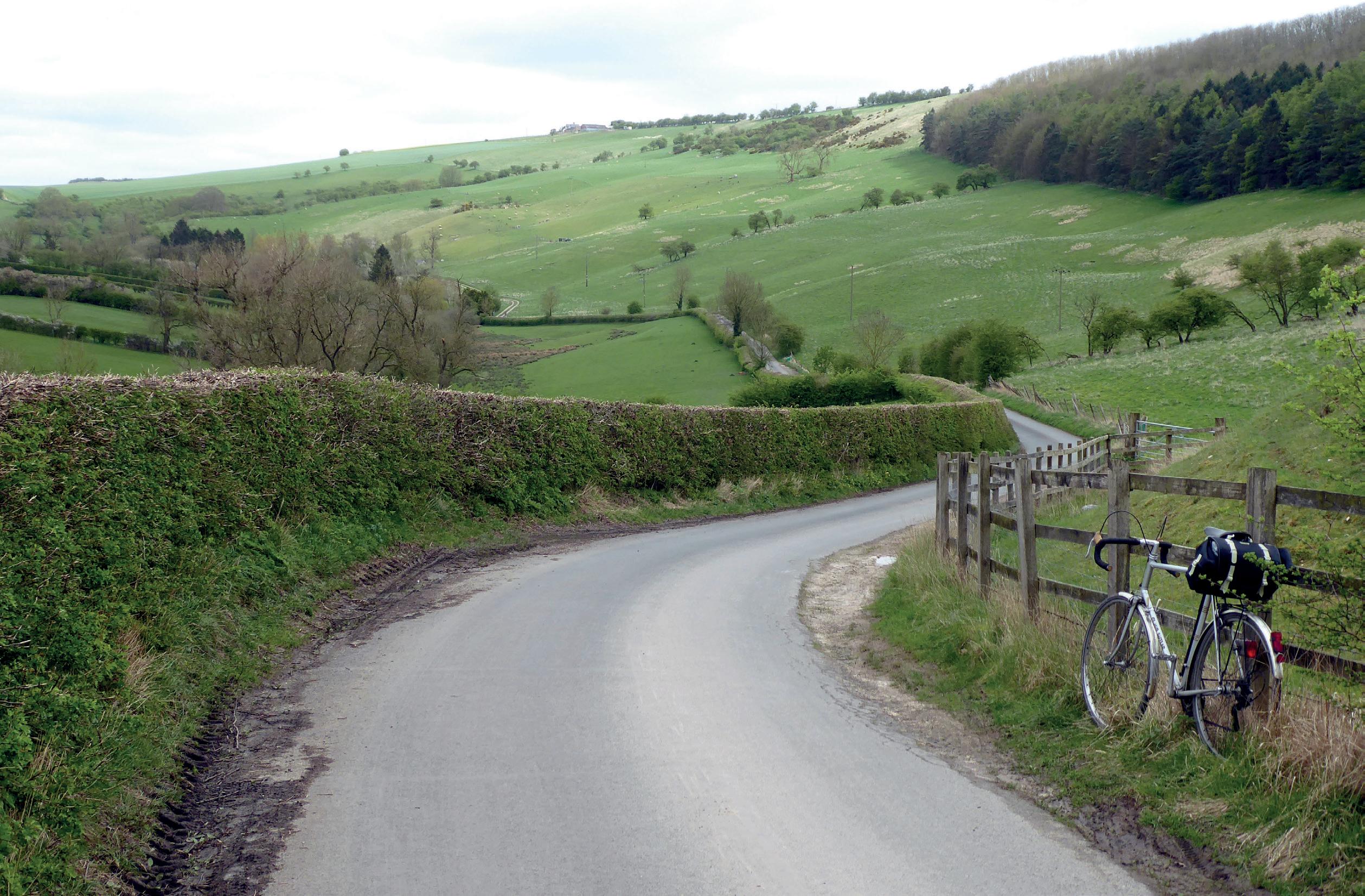
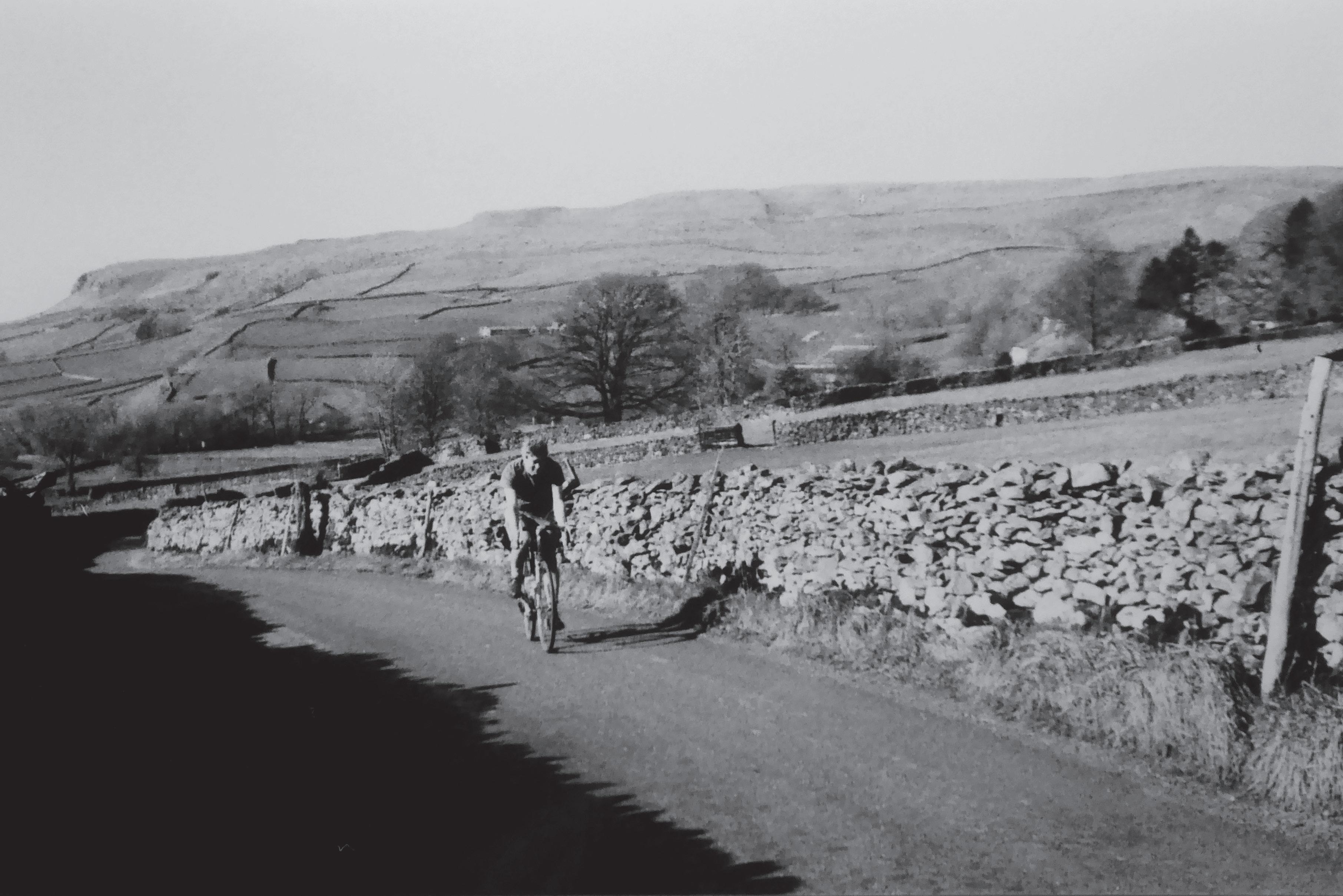
Five decades after his first cycle tour, Rob Ainsley tries 1970s touring in 2024: a gadgetless coast-tocoast journey on the Way of the Roses
34 cycle JUNE/JULY 2024
Great
Top: Kilnwick Percy, nr Pocklington
Bottom: Rob riding up out of Austwick, west of Settle

Cycle touring is all about different places. But I wanted to travel in time, too. In April this year I did the Way of the Roses old style. I rode the 170 scenic, hilly, back-lane miles across northern England, from Morecambe to Bridlington, on a 1978 bike, with kit of the period, doing only what we could do then.
So: no Lycra; no gadgets; toeclips not cleats; saddlebag not panniers; paper maps not GPS; call boxes not mobiles; cash not cards; a 35mm SLR camera with black-and-white film; asking strangers for local information. Hmm... what about food and drink? Lager rather than cask ale? Could I have avocados or banoffee pie? Here’s how my ride through Britain’s least favourite decade worked out.
BEST OF TIMES, WORST OF TIMES: THE 1970S The 1970s’ reputation is dire. A murky decade of power cuts, strikes, inflation, casual racism and sexism, dull muddy football, smoky pubs that closed in the afternoons, terrible fashion (flares! kipper ties! comb-overs!) and dog poo on pavements (sometimes, strangely, white).
But for me as a teen, it was also an exciting time, a coming of age: first romance; first disappointment in romance; first job; first sacking; first proper bike. It also saw my first ever bike tour: a weekend from Hull to York via Selby, staying in youth hostels, on my new Raleigh Clubman. It rained, we met a magician, slept on a barge and had great fun.
Could I recapture some of that excitement today? First I needed to find myself a period bike. I scanned eBay, which mostly yielded rusty shed-finds wanting massive refurbishment. I checked supermarket small ads and saw one-careful-owner old rarities. I browsed bike restorers’ websites, finding meticulously reconstructed 1960s' racers costing my annual earnings, and perhaps destined for a fund manager’s wall.
But at Resurrection Bikes of Harrogate, which recycles donated bikes for charity, I struck gold. Or rather, silver: a 1978 Claud Butler Jubilee in very good nick, mostly original, for £150. Reynolds 531, Weinmann centrepulls, quick-release hubs, Brooks B17, down tube shifters, large flanges (whatever they are). My test ride brought back vivid memories of Seventies' bikes: taut, springy, narrow handlebars, with the knife-edge gliding momentum of a tall, slender ice skater.
Not everything was authentic. I was quite happy to have modern puncture-resistant tyres and the triple chainset that had been added at some point. It still had the ‘de luxe’ rack it came with, but to modern eyes it looks as flimsy as a coat hanger. Anyway, I wanted to try saddlebag touring, and Carradice kindly supplied me with a Nelson Camper Longflap, newly made but to the traditional pattern:




a capacious Gladstone bag of a thing, strappy and accommodating.
Cycling friends lent me lights, maps and a cycling cape of the era. Lock? I vaguely remembered having a padlock and chain back then, so replicated the setup from a local hardware shop.
I was ready to set off, heading for nearly 50 years ago.
ACROSS THE NORTH
The Way of the Roses is lovely – arguably England’s most popular long-distance leisure cycling route. Much of the attraction is the timeless business of quiet roads through thrilling scenery, with a pleasing balance of remoteness, café-stop villages, handsome old towns, honeypot York, and seaside resorts (with train access) at either end. Some people do it in a day; others, like me, take a more leisurely four.
For such trundlers, dawdling through the hills, classic stopovers are Settle, Ripon and Pocklington, making four consistent days of 40 or so miles.
CYCLINGUK.ORG cycle 35 WAY OF THE ROSES GREAT RIDES
ROB AINSLEY
Rob collects international end-to-ends and blogs about rides in Yorkshire and beyond at e2e.bike
Right, top to bottom: The 1978 Claud Butler Jubilee that Rob bought from Resurrection Bikes was over geared but otherwise good. Period Bartholomew maps weren’t very useful. The Ever Ready lights were even worse. The timeless Carradice saddlebag, on the other hand, was great
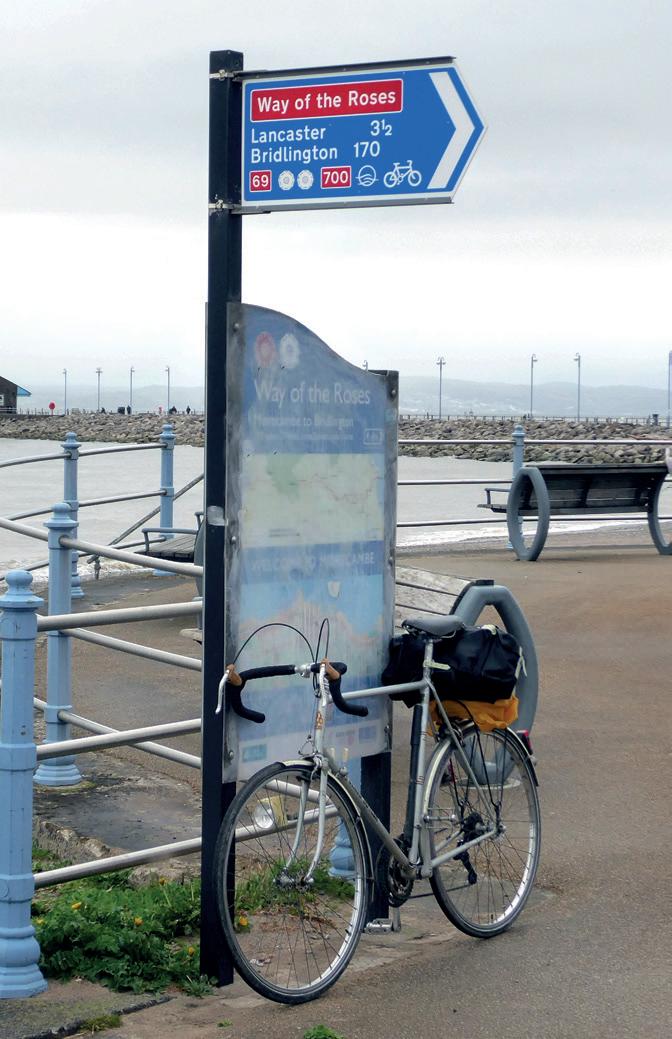


Fact File: Riding into the past
Distance: 170 miles.
Route: Way of the Roses (Morecambe to Bridlington).
Conditions: Mix of sun, rain and wind.
Bike used: 1978 Claud Butler Jubilee.
Maps/guides: Bartholomew paper maps (not useful); Ordnance Survey Landranger maps (useful).
I’m glad I had… Expandable saddlebag; rain cape; enough cash.
Next time I would… Carry on after Bridlington for the four miles to Flamborough Head. Further info: wayoftheroses.info; Cycling the Way of the Roses (Cicerone guide book); e2e.bike (Rob’s website).

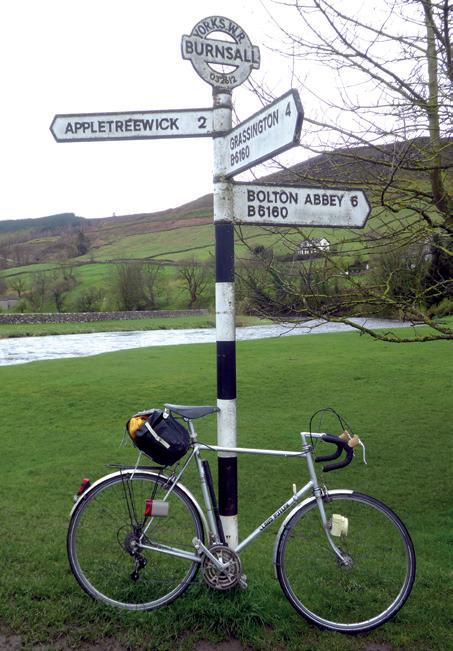
In the 1970s, I don’t remember ever booking accommodation; we just started looking out for a B&B about 5pm-ish, wherever we’d got to. We asked at tourist information centres, enquired in a pub or simply turned up at a youth hostel. If necessary we could always phone from a call box.
This approach would be more challenging today. Tourist information centres are either closed down or volunteer-run and seldom open, call boxes have been repurposed as mini-libraries or defibrillator stations, and everyone snaps up the best and cheapest places to stay on booking.com or Airbnb. So could spontaneity still work?
Surprisingly, it did – even though I couldn’t use call boxes because the ones still with a phone in only take credit cards, which I didn’t have. At Settle the cheery crew in the bike shop on the market square directed me to a guesthouse. At £80 that was too much for me but they’d also mentioned the youth hostel in Malham. Taking a punt, I rode on the few miles (albeit mostly vertical) to it and found to my delight they had dorm beds for a last-minute £15. Dynamic pricing, you see: last week they would have been £35. Youth hostels have changed since the 1970s. Then, you had to stay outside in the rain until you were admitted at 5pm, bring your own sheet
sleeping bag, and do a task such as dust the piano. Alcohol was banned and if you arrived by car you had to pretend you hadn’t. Now bedding is supplied, they have car parks, will flog you a bottle of house wine, and you can use the wi-fi all afternoon. And Malham YHA proved a sociable delight, just how I remember in common rooms of yore. A range of folk, old to young, all swapping stories... and nobody staring at a phone.
At Ripon, where I couldn’t see any B&Bs despite riding around the town-edge roads, I asked in cafés about accommodation. I was directed to the Wetherspoon hotel in the square, which – like the previous night – had invitingly cheap last-minute rooms: £55. A dynamic-pricing bounty again! I celebrated the news with fish and chips plus a Stella. That seemed Seventies enough.
Pocklington would have been much pricier (I asked in the local library, where staff were very friendly and helpful). However, I’d worked out a fix: the X46 (and some X47) York-to-Hull buses stop here and take bikes. Thanks to the current £2 flat fare scheme and yet more last-minute cheap dorm beds at York YHA (£15 again!), I could have done it cheaply. (As it happens I live in York, so I just got the bus home, then another back next morning.)

36 cycle JUNE/JULY 2024 GREAT RIDES WAY OF THE ROSES
Clockwise from above: The start at Morecambe. Checking the map by the River Lune. Crossroads at Keasden, with Ingleborough in background. The bike gets an admirer at Ouseburn village store. York Minster. Brimham Rocks. Old-style sign at Burnsall. South of Pen-y-ghent, near Settle
Malham, of Cove and Tarn fame
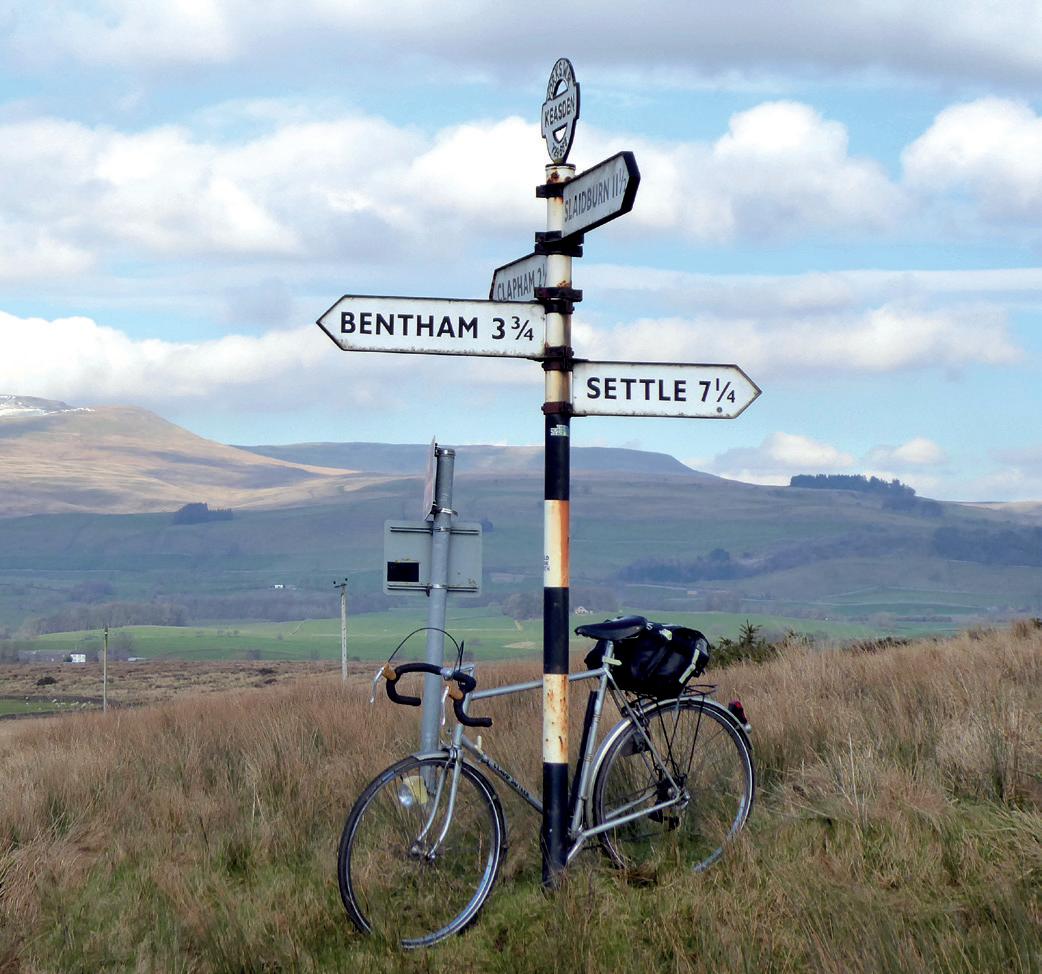
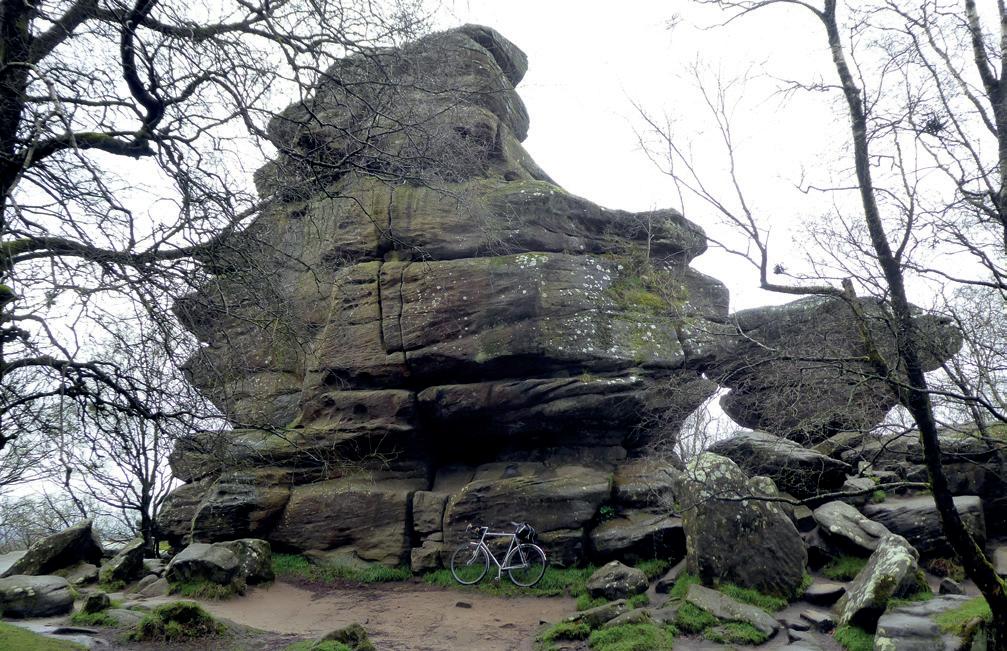
MAPS NOT APPS
Direction finding proved no issue: the Way of the Roses is well signposted all the way. Except once. At Gressingham, an hour or two from Morecambe, the road was closed, impassably, with no diversion signed.
The roadworks man, evidently under the impression my bike was an Audi and my wristwatch was an Apple one running Google Maps, advised me to take A-roads to Kirkby Stephen. I consulted my 1970s Bartholomew maps, lent by a friend who insisted these were the cartography of choice then, with a scale ideal for day rides. Unfortunately the scale was too small for the detail of how to cross the river – save for a suggested ferry, clearly now unlikely.
Curses! But, as I stood looking round bewildered, I was rescued by a local cyclist out for a spin on his self-built gravel bike. Like me, he was the same age as an old person; a super chap, precisely and gently spoken, with a smart sense of humour. I followed him down back roads and farm lanes over a bridge to rejoin the route post-roadworks. We stopped on a bench for a village-shop lunch of pork pie and fizzy pop, chatted and joked, and bird spotted. It was all very 1970s.
The café stop hasn’t changed, though I suspect coffee is better now and the sandwich choice more imaginative than back then. Such as in Burnsall, a delightful Wharfedale village whose friendly, local, traditional-feeling café overlooks the riverside green. I sat out the rain by browsing the local paper


In the '70s you had to stay outside youth hostels in the rain until you were admitted at 5pm, bring your own sheet sleeping bag, and do a task such as dust the piano
(Craven Herald & Pioneer, Voice of the Dales since 1853) whose news stories – theft of silverware from a church, cycle club rides, council rows, towpath improvements – seemed enduring, too.
One thing that has changed in the last halfcentury, however, is traffic. Levels have doubled since then, and it often feels like the size of vehicle has as well. The vast majority of the Way of the Roses is on little-used back lanes that are still a tranquil pleasure to ride. But several times a monster SUV occupying the width of a singletrack road would come barrelling up at, or past, me, forcing me to ride on the verge.
Getting to and from either end by train proved easy. Depending on who you talk to, the nationalised British Rail era of the 1970s was either a golden age (simple fares! your bike went in the guard’s van!) or awful (frequent cancellations, lateness, horrible sandwiches).
Well, I had no problems to Morecambe on the Transpennine and Northern services there. On the first I could buy my ticket in cash on the train, and have my lack of a booked bike space overlooked with a smile. On Northern, which supplied my escape train from Bridlington, bike spaces are all walkup anyway.
CYCLINGUK.ORG cycle 37 WAY OF THE ROSES GREAT RIDES
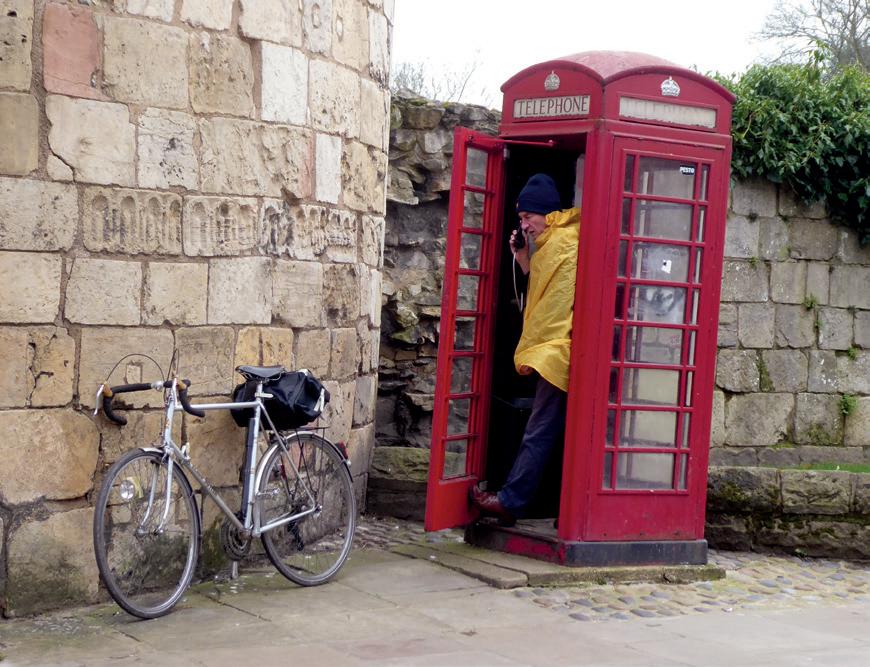
One thing that's changed in the last half-century is traffic. Levels have doubled, and it often feels like the size of vehicle has as well
HOW THE BIKE PERFORMED
My five-decades-old bike proved a delight to ride. Not just ‘considering its age’, but simply as a bike. It’s nippy and responsive, pedals smoothly, and is especially fun at speed. As ‘tourers’ were then, it’s basically a racer with minor modifications, designed to go fast. It could zoom down those Yorkshire Dales at 40mph (I guess: no computer, obviously) and stay rock steady and reliable, or skim along the long gentle downslopes of the Yorkshire Wolds at a clip (but no toeclips: they were too small for my shoes).
Yet because of that racing background, the gears weren’t low enough – which is still a common problem today for tourers. My Claud Butler’s lowest combination is 28/28. My modern Spa Cycles tourer has a much easier 24/36. No wonder the Claud Butler feels 50% harder uphill.
As for the Carradice saddlebag, well, that was something of a revelation. Its capacity equated to just one of my two mighty Ortlieb panniers, but the Longflap could easily swallow enough tools, clothes, maps, jackets and picnic items for a four-day tour, plus my 1970s SLR camera. There’s a seductive clarity about straps, I found, but the real surprise was how the weight – thanks to being on the seatpost – was unnoticeable. The bike handled differently, more snappily, than my pannier-toting modern tourers.
And the clothes, well, maybe on 70-mile days in midsummer I’d want the wicking, flexible comfort of Lycra. But on 40-mile ambles in a cool April, the cotton T-shirts, shorts and wool socks and Clarks leather shoes that I wore on this trip – as on my first tours back then –were perfectly comfortable.
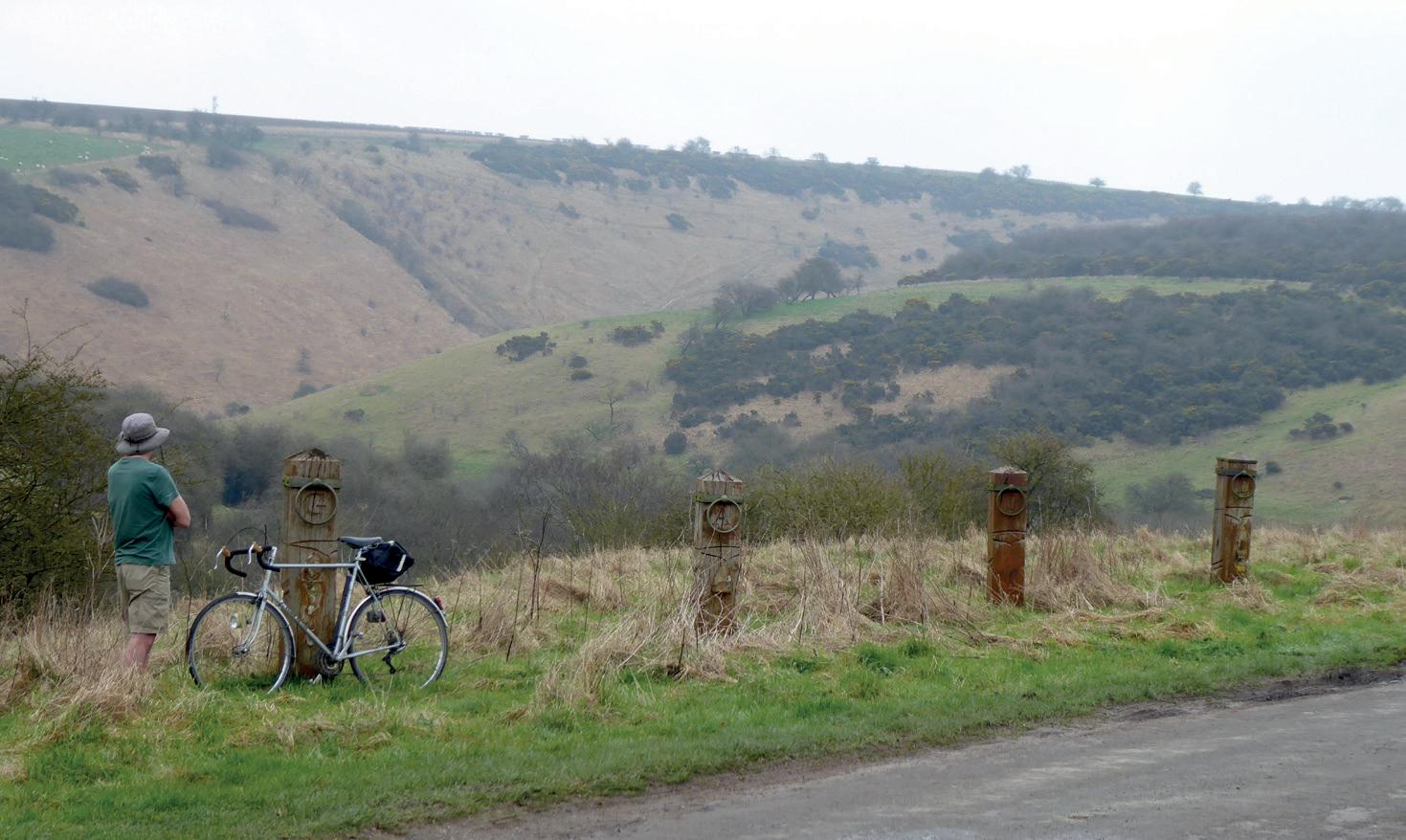
It chucked it down at times, and I needed my 1970s rain cape. It was a real museum piece: a kind of yellow oilskin kaftan with a hole for your head that covered everywhere from your hands on the handlebar to your back. It worked pretty well, keeping me mostly dry and warm even in torrential downpours, though it had a habit of pooling water and then discharging it in one go. I’ll stick with my breathable waterproofs but this wasn’t a bad experience at all.
The lights were a bad experience: 1970s Ever Readys, the front one the size of a house brick and about as good for road illumination. It required two batteries the size of baked bean tins and gobbled them up like a hungry teenager. They didn’t last two hours. The rear one was little better.
LESSONS FROM HISTORY
So what did I learn? That vintage bikes aren’t just lovely to ride, they’re also talking points. Several times a day a head would turn and someone would come and ask about the bike. (“My brother used to do time trials on that”, “I used to have a Claud Butler”, “My grandad had a Carradice saddlebag”, and so on.) That youth hostels, though far fewer than in the 1970s, are still great sociable places if you put your phone away. That last-minute bargain beds can be worth looking out for.
On the other hand, I won’t be forsaking my modern conveniences of accommodation websites, map apps and digital cameras (one of which I did actually take alongside the old SLR to make sure I had good enough photos for this feature). I learned that my Claud Butler is well worth using for pleasure jaunts and maybe for more tours, and that saddlebag touring would probably work just as well on some of my other bikes.

But mainly I learned that much of what makes bike touring a pleasure is still there. And I found it on my 1970s-style Way of the Roses. Quiet lanes, country scenery, village cafés, chatting with fellow travellers, the joy of self-contained travel... these things don’t change. Never mind the past; here’s to the future.

Then and now: what was better in the 1970s or 2020s?
Accommodation: now
Beer: now
Bikes: draw
Bike lights: now
Cafés: draw
Cameras: now
Friendliness: draw
Global sustainability: then
Phones: now
Pubs: now
Road surfaces: then
Saddlebags: then
Sandwiches: now
Simplicity: then
Traffic levels: then
Trains: now
Youth hostels: now
38 cycle JUNE/JULY 2024 GREAT RIDES WAY OF THE ROSES
Millington Pasture, shot with the old 35mm SLR
Clockwise from far left: This is a staged shot: the remaining call boxes with phones in them only took credit cards, not cash. Millington Pasture outside Pocklington. The finish at Bridlington




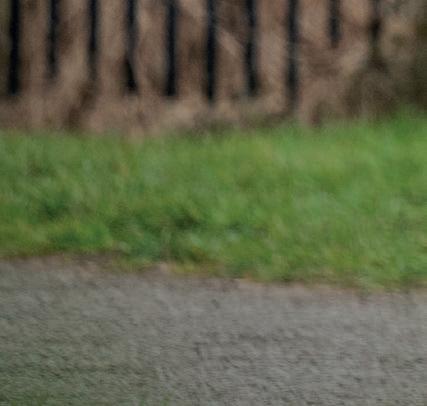

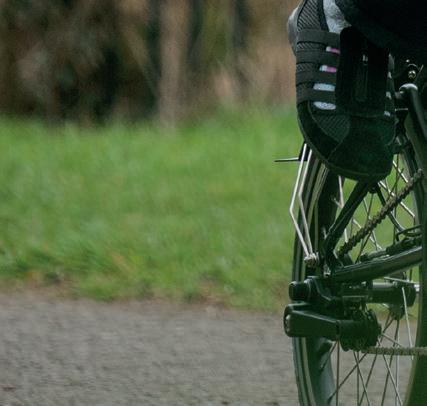
Feature
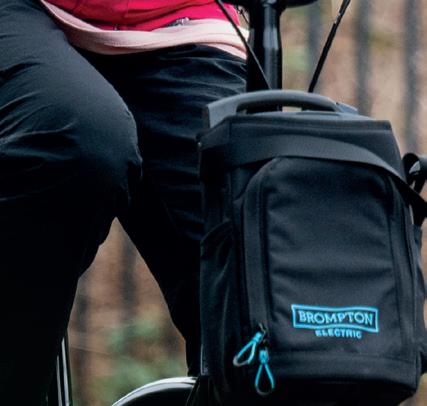


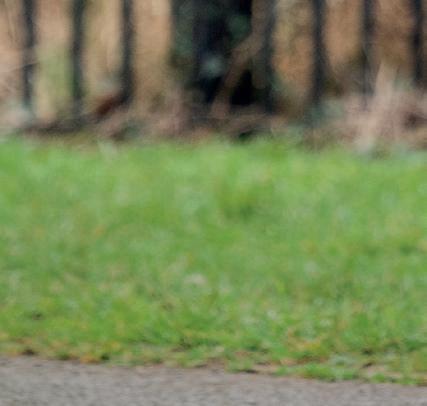



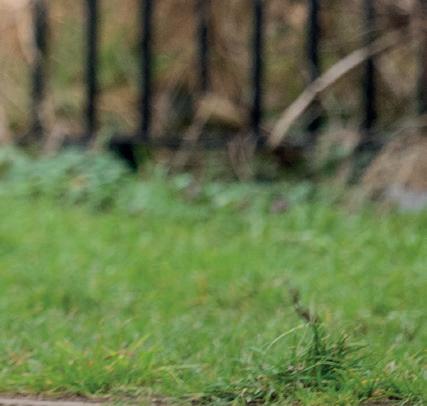




THE WAY AHEAD
 SAM WALLER
Cycling UK brand, marketing and communications manager
SAM WALLER
Cycling UK brand, marketing and communications manager
CYCLING UK’S NEW FIVE-YEAR STRATEGY LAUNCHES THIS SUMMER. SAM WALLER OUTLINES WHAT WE’LL BE DOING TO FULLY REALISE CYCLING’S EXTRAORDINARY POTENTIAL AS A FORCE FOR GOOD


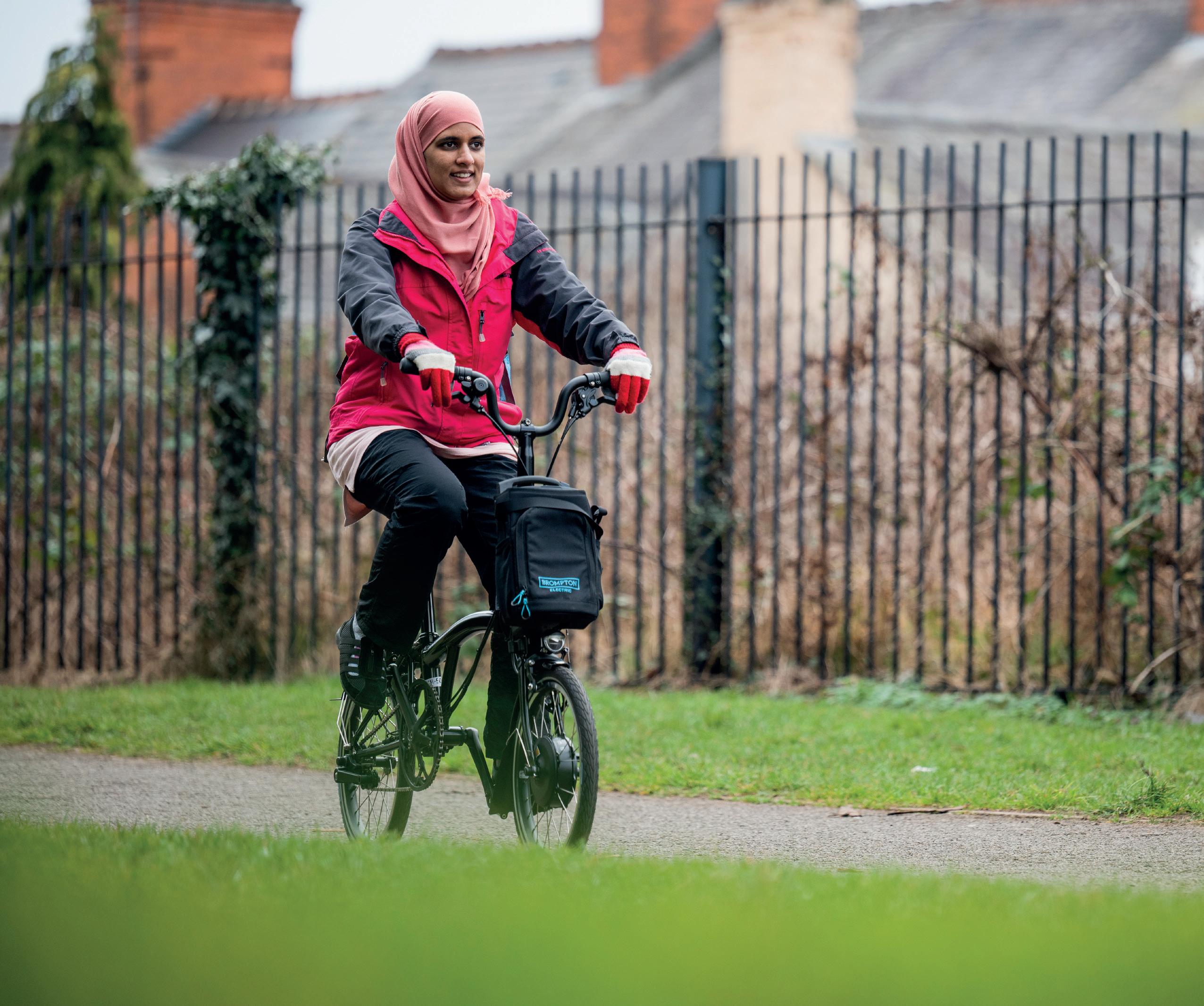
From improving our health and wellbeing to tackling climate change and creating more pleasant places to live and spend time, cycling delivers an extraordinary range of benefits. As we get ready to launch Cycling UK’s new five-year strategy, we are focused on fully realising the vast potential of cycling to help people and society.
A huge amount has changed in the external environment since our previous strategy started in early 2019. We’re proud of the achievements you enabled us to secure during that time: winning vital improvements to the Highway Code; helping hundreds of thousands of people to discover the joys of cycling; creating iconic new routes to help people explore the UK’s stunning landscapes; and bringing you exciting new member
40 cycle JUNE/JULY 2024 FEATURE STRATEGY




In a nutshell
Our vision: happier, healthier and greener lives through cycling.
Our mission: we enable and inspire people from all backgrounds and abilities to experience cycling’s joys and benefits. We speak up for all who cycle to make sure it’s a safe and easy choice for everyone to travel, explore and have fun. Our charity works with diverse partners to maximise our impact.
Our purpose: we improve lives, places and the planet through cycling’s remarkable benefits. We are powered by our heritage and expertise, and the passion of our staff, supporters and volunteers.
benefits. We’re now ready to build on these achievements with a bold and ambitious plan – one that you helped to shape by sharing your views in our surveys and focus groups over the past year.
Among the themes from your feedback was the importance of our campaigning work – from making roads safer to securing more high-quality cycling infrastructure. Another common thread was the desire to see more people cycling, particularly the next generation, with all the benefits that brings. Cycling can be a powerful force for good, a potent solution to some of the biggest problems our society faces. We now aim to fully harness this potential.
Many of you emphasised the value of our support for member and affiliate groups, plus the insurance cover and other member benefits you receive. As a charity we are powered by our members and

supporters, so providing the best possible membership experience is a vital aspect of our new strategy.
We know that there’s one thing that unites us all: we all love getting on our bikes and going out for a ride. It’s our goal to make the UK an even better and more positive place to cycle, no matter where or why you ride, or what type of cycle you use. We are in a unique position to deliver on this mission thanks to you –representing our members for the past 145 years has given us the expertise and mandate to make this change possible.
In order to shape our work for the next five years, we have agreed on five new strategic objectives, which will help to ensure our efforts are focused on the things that will have the biggest positive impact. While there isn’t space to share every detail here, we want to give you a flavour of what we will be doing under each of those objectives.
IMPROVE PERCEPTIONS OF CYCLING SO THAT EVERYONE SEES THE BENEFITS
While we all know that cycling is a force for good, some people view cycling less positively. Research shows us that this is a noisy minority but they can be influential, and these views are widely covered by some parts of the media. Convincing more people that cycling is broadly a good thing is a crucial factor in persuading more politicians and decision-makers to support and invest in cycling.
We will change perceptions by consistently making the positive case for cycling. One of the tools we will use is ‘framing’, which is about the language we use and how we can most effectively
present information and arguments in a way that will engage and persuade our audiences. As part of our new strategy, we will commission research into the ways we can most effectively make the case for cycling. Because we want to see consistent and effective messaging from all cycling campaigners, we will share this research with the wider community so together we can all have more impact.
It’s also crucial that we challenge the perception of who rides a bike. People who cycle come from all walks of life – there is no such thing as a ‘typical cyclist’. We’ll be proving that by showcasing stories from across our supporter base that demonstrate anyone and everyone can benefit from time on a bike.
Shifting public perceptions won’t be easy. It’s a major task and it certainly won’t happen overnight. However, as our director of external affairs Sarah McMonagle says, Cycling UK is up for the challenge: “Improving public perceptions of cycling is a really significant task, but it’s one we’re committed to tackling head-on. We know that if we can build a clear consensus that more people moving about by bike is a positive thing, it will put us in a strong position to secure increased support and investment in cycling. This is crucial to unlocking our other strategic objectives, including enabling many more people to start cycling.
“We won’t be able to do this alone. Developing new partnerships and coalitions with a broader range of organisations that have crossover interests in things like environment, health and wellbeing will be essential. Partnership working is also something you our
CYCLINGUK.ORG cycle 41 STRATEGY FEATURE
Main image: Promoting the power of e-bikes in Leicester Left and below: Sending politicians a message in Glasgow and Belfast
Photos, left to right: Roo Fowler, Andy Catlin, Double Take
members told us you wanted to see Cycling UK do more of, and we certainly will be.”
BOOST THE NUMBER AND DIVERSITY OF PEOPLE WHO CYCLE
To fully realise cycling’s amazing power to improve people’s lives, we must increase the number of people who cycle. That means reducing the barriers that people face, both physical and psychological.
We will build on our track record of delivering impactful community-based projects that enable people to discover or revive a love for cycling, like our Big Bike Revival programme. Now in its 11th year, it delivers sessions and events across England to help adults to cycle. All these are specifically designed to offer solutions to the barriers that are currently preventing people from cycling.
We will also continue our awardwinning cycling projects in Scotland, bringing life-changing benefits to the people who need it most, including disabled people, people with physical and mental health challenges and people who are struggling financially. We are also actively seeking partnership and funding opportunities to expand our programmes into Wales.
Alan (name changed for anonymity) started cycling regularly after attending weekly cycle sessions at one of our Community Cycle Clubs, FirstLight Trust in Gosport, Hampshire. Initially going along to improve his mental health, Alan soon discovered additional benefits to cycling. Since selling his car due to the increasing costs associated with it, he cycles for most of his journeys.
“Cycling gets you out and gets life back together,” he says. “It’s one of the best things you can do and is good for everyone. It is the best way to see the environment around you, better than car or motorbike. I used to feel stressed driving on roads, but travelling by bike is fine.”
MAKE CYCLING AN EVEN MORE POSITIVE EXPERIENCE
We all know the friendship and camaraderie of a great group ride, the thrill of discovering a new route or the reward of completing a journey under your own steam. However, we also recognise that not every cycling experience is as positive as it could be.
We are determined that cycling should be a safe, convenient and enjoyable option for everyone. Whether you’re doing the school run by bike, enjoying long road


rides with friends or seeking off-road adventures in wild places, we want to make the UK an even better place for you to ride your bike.
We will support Cycling UK’s brilliant member and affiliate groups to go from strength to strength, enabling them to introduce more people to the joy of cycling. We will create new initiatives and products, to inspire people to get involved in cycling. And we’ll use our position to engage with groups that are less well represented in cycling, like our highly successful annual 100 Women in Cycling awards.
Based on your feedback from surveys and focus groups, we know that our members value our work creating spectacular new cycling routes across the UK. As commercial director Katie Legg explains, these routes create positive cycling experiences for those who ride them, but the benefits don’t stop there.
“Our strategic focus on enabling more positive cycling experiences is at the heart of our routes work,” she says. “By developing more long-distance routes that immerse riders in the UK’s stunning landscapes and heritage, we inspire deeper connections to the great outdoors. Our
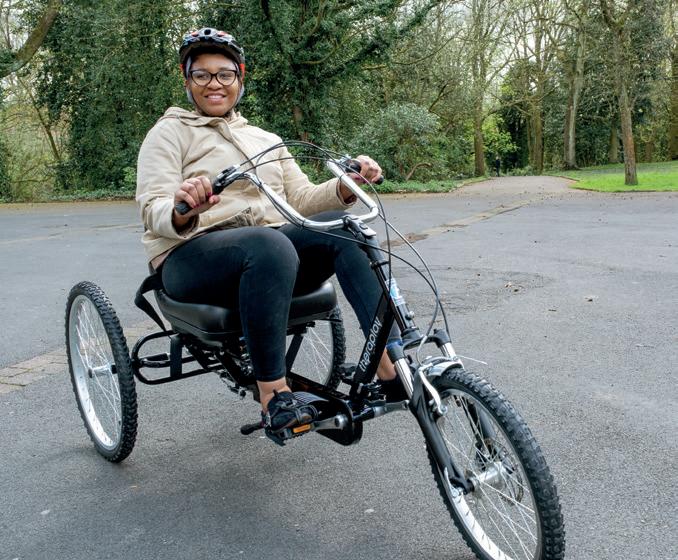
routes work also promotes sustainable tourism and financially benefits local communities, so it’s not just those who ride our routes that feel the benefits, but the businesses and attractions along them too. This helps more people feel the very tangible benefits cycling offers to communities.”
Cycling UK members Martin and Julie Gill from London stumbled across Cycling UK’s long-distance routes by watching GCN coverage of them and have since ridden King Alfred’s Way, Cantii Way and Rebellion Way. They enjoyed these routes so much they felt inspired to support Cycling UK to create a series of new multi-day routes through their charitable foundation. They say: “These routes should allow riders to explore new parts of the country – enjoying historical sites, seeing incredible views from quiet roads, and riding on a mix of terrain – so there is something for everyone. The routes will also open new sections of lost byways or closed access, to make for new adventures.”
As a member-driven charity, we’re incredibly grateful for the support of our members and route lovers who donated to our recent long-distance route appeal,
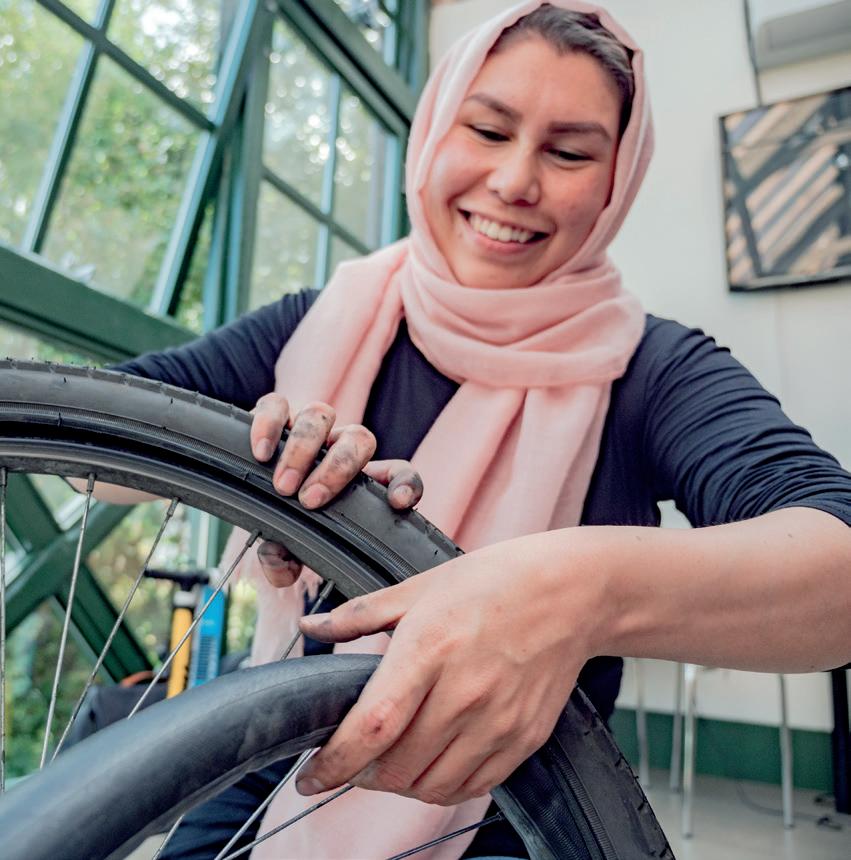
42 cycle JUNE/JULY 2024
Photos, clockwise from top: Julie Skelton; Joolze Dymond; Pannier CC; Joe Cotterill; Robert Spanring; Cycling UK
FEATURE STRATEGY
Families use bikes for transport and recreation when the active travel provision is good enough
Above: Promoting all-ability cycling in Hyde, Manchester Right: A Big Bike Revival maintenance workshop for women
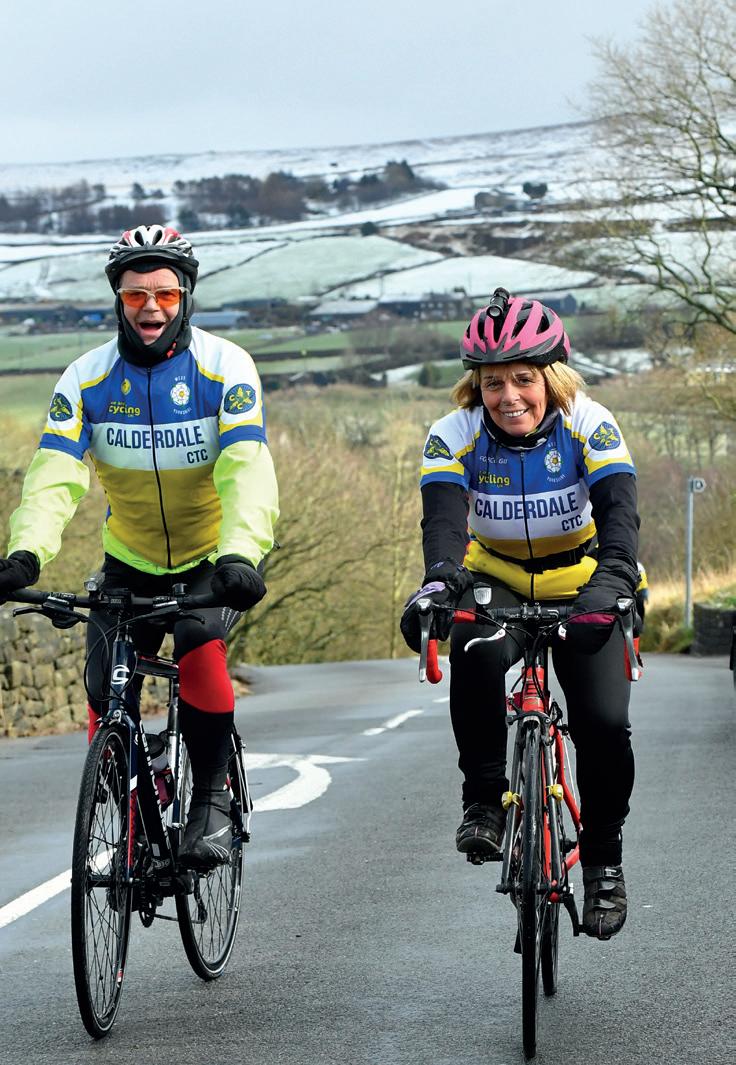


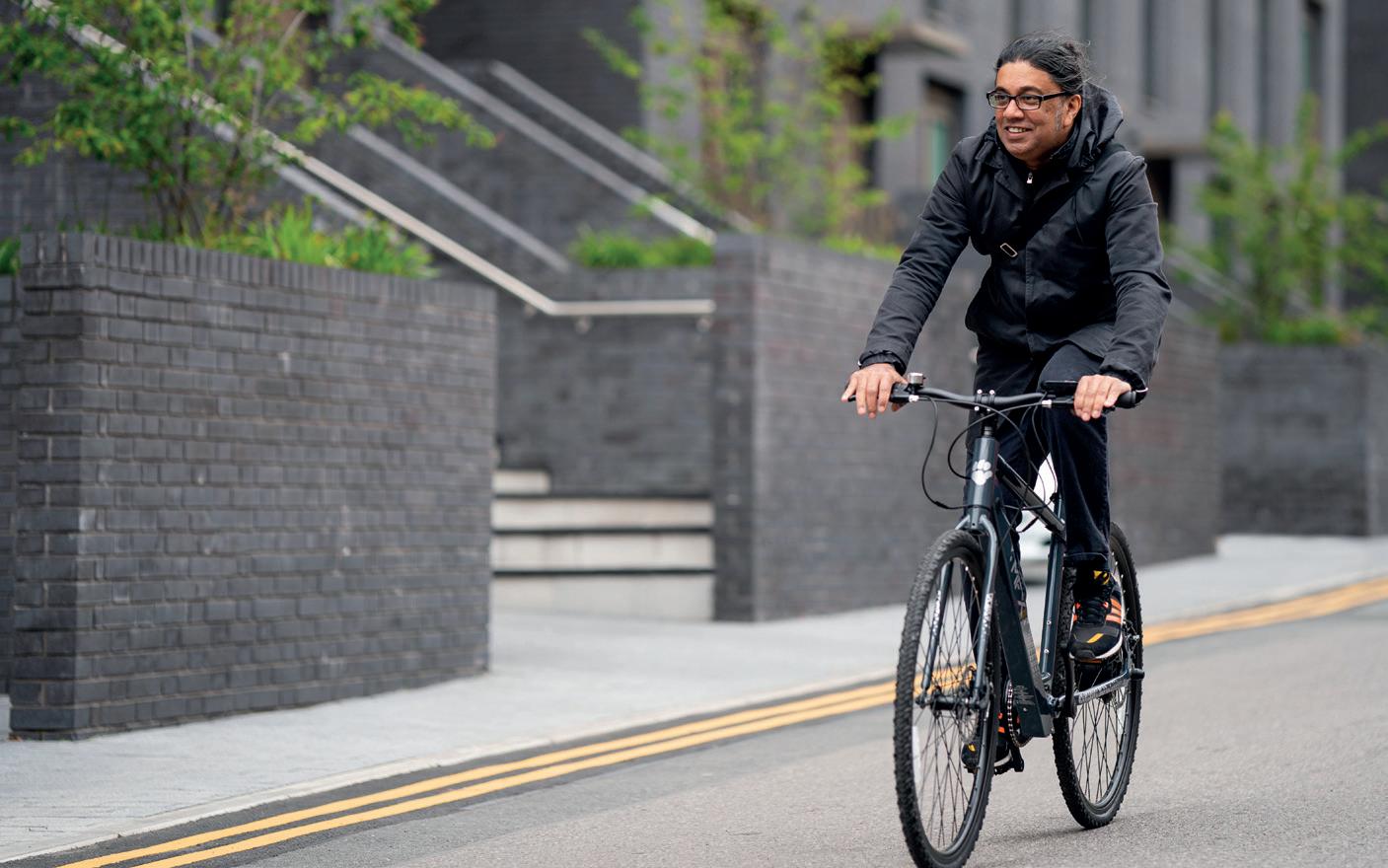
with donations doubled thanks to matched funding from the Gill Foundation. At the time of writing, you have helped us to raise £21,066, which will go towards developing the first in a series of incredible longdistance routes, allowing more people to enjoy the breathtaking British countryside for generations to come.
INCREASE TRANSPORT CHOICE BY ENABLING AND ENCOURAGING MORE PEOPLE TO CYCLE LOCAL JOURNEYS
Cycling can play a vital role in combatting climate change, reducing pollution and creating better places to live and spend time – if we can enable more people to travel by bike, especially for local journeys. To do this, people must feel that cycling is a viable, convenient and attractive alternative to driving. This is where our award-winning campaigning and policy work comes in. We have campaigned for
positive change for cycling throughout our 145-year history, and this will continue to be central to what we do.
We will continue to raise the collective voice of our members and supporters to push for safer roads, more high-quality cycling infrastructure and increased funding for cycling. We will foster partnerships to maximise our impact and have the best possible chance to influence policy and legislation. We’ll continue to empower people to make their local roads safer through our updated and improved Fill That Hole website, through which more than 200,000 potholes have been reported. We will also continue to support and empower people and groups to campaign for change in their local communities through our Cycle Advocacy Network (CAN).
One such group is Shoreham-By-Cycle, who were supported by Cycling UK after West Sussex County Council removed a
Based on your feedback from surveys and focus groups, we know that our members value our work creating spectacular new routes across the UK
popular cycle lane in the town in 2020, contrary to government guidance. Through our Cyclists’ Defence Fund and with donations from members and supporters, Cycling UK took legal action against the council. This resulted in a court order confirming that the council had acted illegally and instructing them to contribute £25,000 to Cycling UK’s legal costs.
Clive Andrews, the group’s chair and a Cycling UK member, says: “We felt empowered and represented – knowing that even in our area of coastal suburbia, Cycling UK is looking out for the issues that matter in the journey towards safer, more accessible cycling.
“We’re so pleased to be a member group within Cycling UK’s family. Access to the organisation’s wealth of knowledge, experience and support is a huge help to the work we do, pushing for improvements at a local level. Membership gives us the confidence that when we need the support of real experts in cycle campaigning, they are there for us, and that we are part of something nationwide.”
Duncan Dollimore, Cycling UK head of campaigns, reflects on the new strategy: “When we talk about the positive impact
CYCLINGUK.ORG cycle 43
STRATEGY FEATURE
Above: Cycling UK member group Calderdale CTC
Right: Routes like the West Kernow Way drive tourism
Below: Better access to bikes benefits society as a whole


cycling has on the challenges facing our society, that resonates with politicians and policymakers more than if we simply talk about cycling in isolation. And although not everyone wants to cycle, the argument that people should have more transport choices is hard to disagree with.
“So, how we communicate what we want and why it matters is a core part of an exciting new strategy which is positive about choice, perceptions and diversity. Our campaigning and wider influencing work is essential to deliver this strategy, starting with our general election campaign, which we’ll build on through priority campaigns across all four nations over the next five years.”
Our community-based cycling projects also play an important role in enabling people to cycle as part of their normal daily lives. We are proud to have recently launched the Inclusive Cycling Experience (see page 10 for more details), an exciting new programme funded by the Motability Foundation. It will support disabled communities in Greater Manchester and Inverness to start cycling, through free tryout sessions and non-standard cycle loans to enable people to consider cycling as an active travel option for everyday journeys.
ACHIEVE GREATER IMPACT BY BECOMING THE BEST POSSIBLE CHARITY WE CAN BE
In order to deliver on those first four objectives, we recognise that we must further strengthen our organisation to be the best possible charity it can be. The stronger our foundations, the greater the impact we can have.
This means investing in our fantastic staff team, improving systems and processes, and growing our capacity to
Our community-based cycling projects play an important role in enabling people to cycle as part of their normal daily lives
deliver. Because we are a charity, this also means looking at our income and finding new ways to generate more funding to deliver the work we do. Without this objective, we wouldn’t be able to realise the others – and that is why it is so crucial to our success.
Together, we believe these five objectives will put us in the best position to maximise our impact as a charity. We recognise that we can’t do it alone, so we will build exciting new collaborations with organisations and brands to achieve our aims. We will continue to enable and inspire people from all backgrounds and abilities to experience cycling’s joys and benefits. We will speak up for all who cycle to make sure it’s a safe and easy choice for everyone to travel, explore and have fun.
We’re really excited about what the future holds for Cycling UK and we’re ready to write the next chapter in our organisation’s long and proud history. None of our work would be possible without our members, so thank you for taking this journey with us. Together we can make the UK an even better place for everyone who rides a bike or might do so in the future.
What you said
• “Improved cycling infrastructure is vital to encourage more people to feel confident to start or continue cycling.” – survey response
We couldn’t agree more. If we want more people to cycle, we must ensure it’s a convenient and safe option. We will continue to campaign for more and better infrastructure that empowers people to choose to cycle.
• “An essential need for society is for cycling to become recognised as an important mode of transport” – survey response
Convincing more people that cycling is a positive thing will be a crucial factor in persuading decisionmakers to support and invest in cycling. Shifting public perceptions is a central part of our new strategy.
• “I certainly would like to see more work done on safe routes to schools and getting kids [cycling]” –focus group participant
Enabling the next generation to cycle was a clear theme from our focus groups and surveys. We want to make cycling to school or nursery a safe and enjoyable option for families across the UK.
• “I am particularly impressed by Cycling UK’s encouragement of everyone to get involved with cycling… particularly people with mobility issues [using] e-bikes, trikes and adapted cycles” – focus group participant
We passionately believe in supporting people of all ages, backgrounds and abilities to experience the joy and benefit of cycling. We continue our awardwinning community-based programmes in England and Scotland and are looking to expand to Wales as well.
44 cycle JUNE/JULY 2024
FEATURE STRATEGY
Photo: Robert Spanring
Group ride in Epping Forest to celebrate the 100 Women in Cycling awards
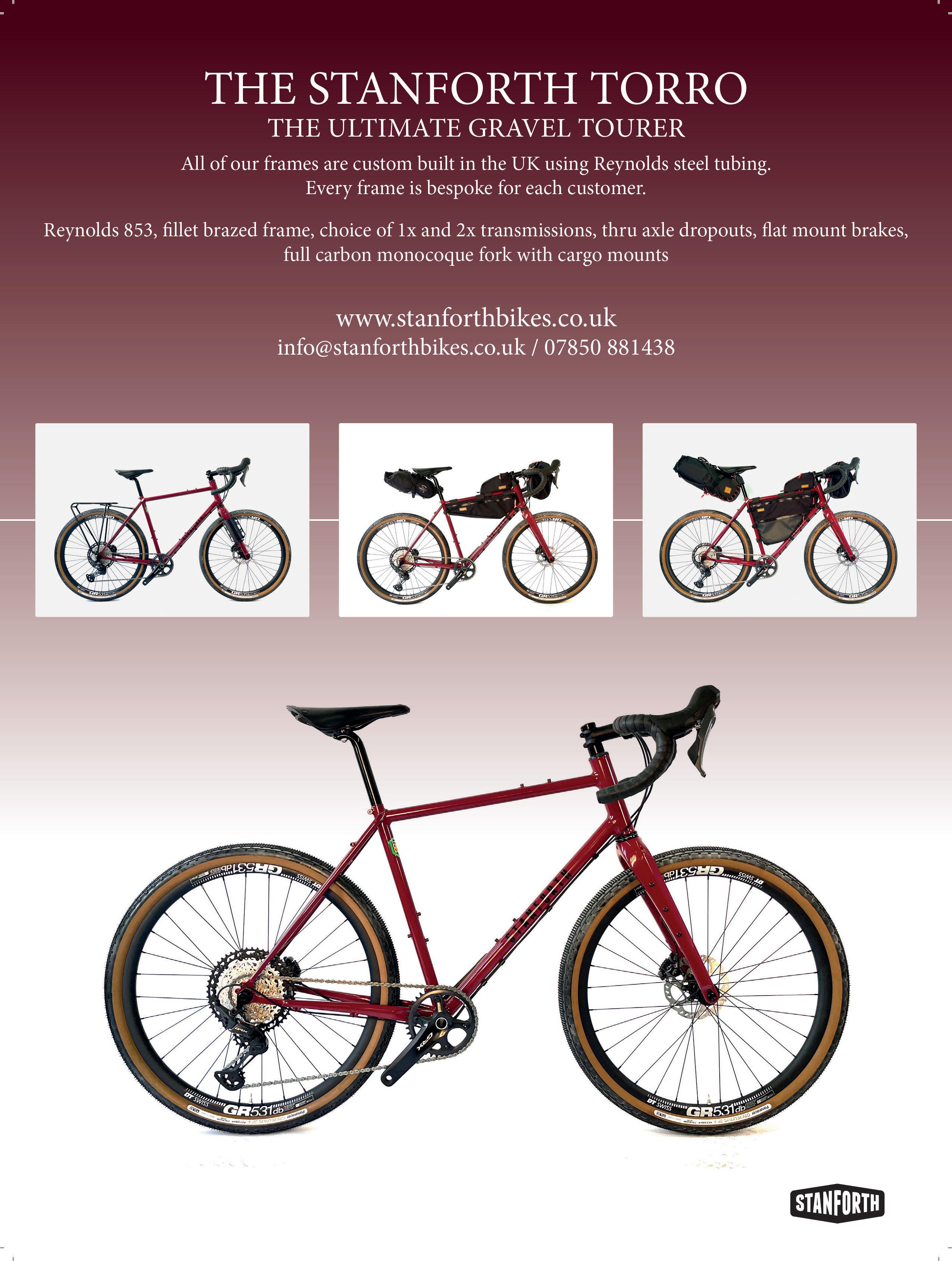



Devon Coast to Coast Weekender
One of England’s best coast to coast routes isn’t across the north but in Devon. Laura Laker rode it




LAURA LAKER
Laura is a cycling journalist. Her book, Potholes and Pavements, a Bumpy Ride on Britain’s National Cycle Network, is reviewed on page 28
In any list of the top routes on Britain’s National Cycle Network, the Devon Coast to Coast is reliably there.
Running 99 miles from the south coast at Plymouth to Ilfracombe on the north, it manages to span one of the bumpiest parts of the country largely (but not entirely) via gentle gradients on a number of rail trails
The Devon Coast to Coast stitches together several routes, including the Granite Way, Drake’s Trail and the Tarka Trail. It also offers a generous collection of breathtaking views. Once you’ve zig-zagged out of Plymouth following the little blue and red NCN signs, you climb gradually to meet the edge of Dartmoor on the first rail trail, via dripping tunnel and dizzying bridge, flying high above the tree canopy.
The moors are delightful. In the middle, somewhere around Sheepwash, are some very stiff little Devonian hills, before more glorious rail paths take you via flatter countryside and gorgeous estuary, via Okehampton, to Barnstaple and then on to Ilfracombe on country roads.
This is a route I’d happily recommend to family cyclists with child passengers (they might need e-assist). As Ilfracombe lacks a rail service, I cut the ride short and boarded a train home at Barnstaple. If you finish at the coast, it's about 15 miles back to Barnstaple station.
West
Kernow Way
Cycling UK's 230km bikepacking route is nearby in Cornwall.
cyclinguk.org/westkernow-way
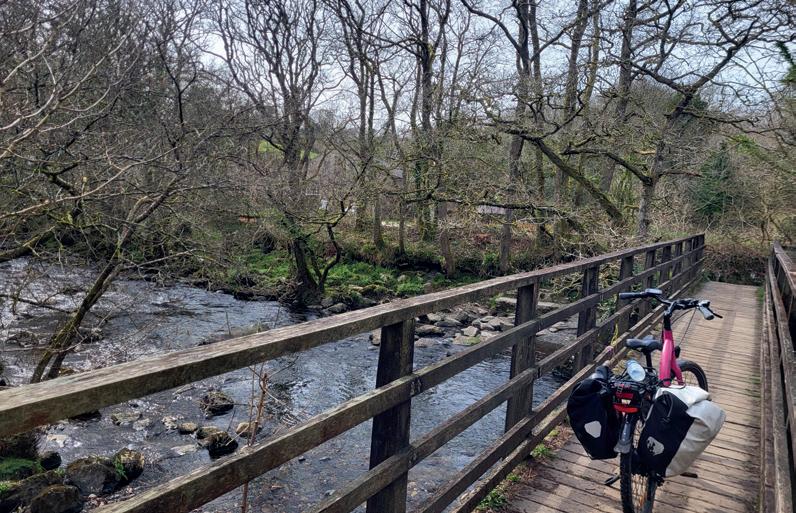

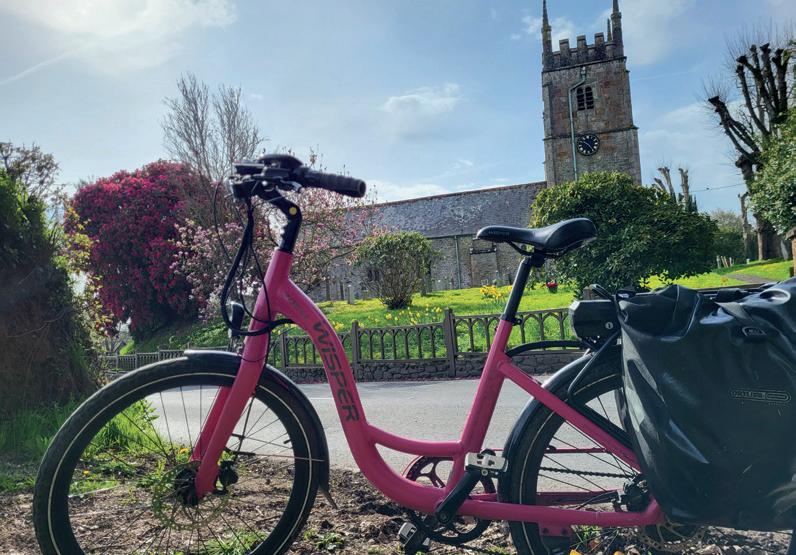
CYCLINGUK.ORG cycle 47 DEVON COAST TO COAST WEEKENDER
Top to bottom: near Hatherleigh. Offroad ‘shortcut’ after Mary Tavy. Dartmoor ponies. St James' Church, Jacobstowe
Weekend ride
DEVON COAST TO COAST
• Start/finish: Plymouth train station (SX 4660 5414) to Ilfracombe Harbour (SS 5263 4785) • Maps: OS Landranger 180, 191, 201 • Ride length: 157km (97.6 miles) • Climbing: 2,064m • Bike type: touring, hybrid, gravel, a rugged road bike or a long-suffering e-bike like mine • Ride level: regular • GPX file: cyclinguk.org/weekender-devonC2C
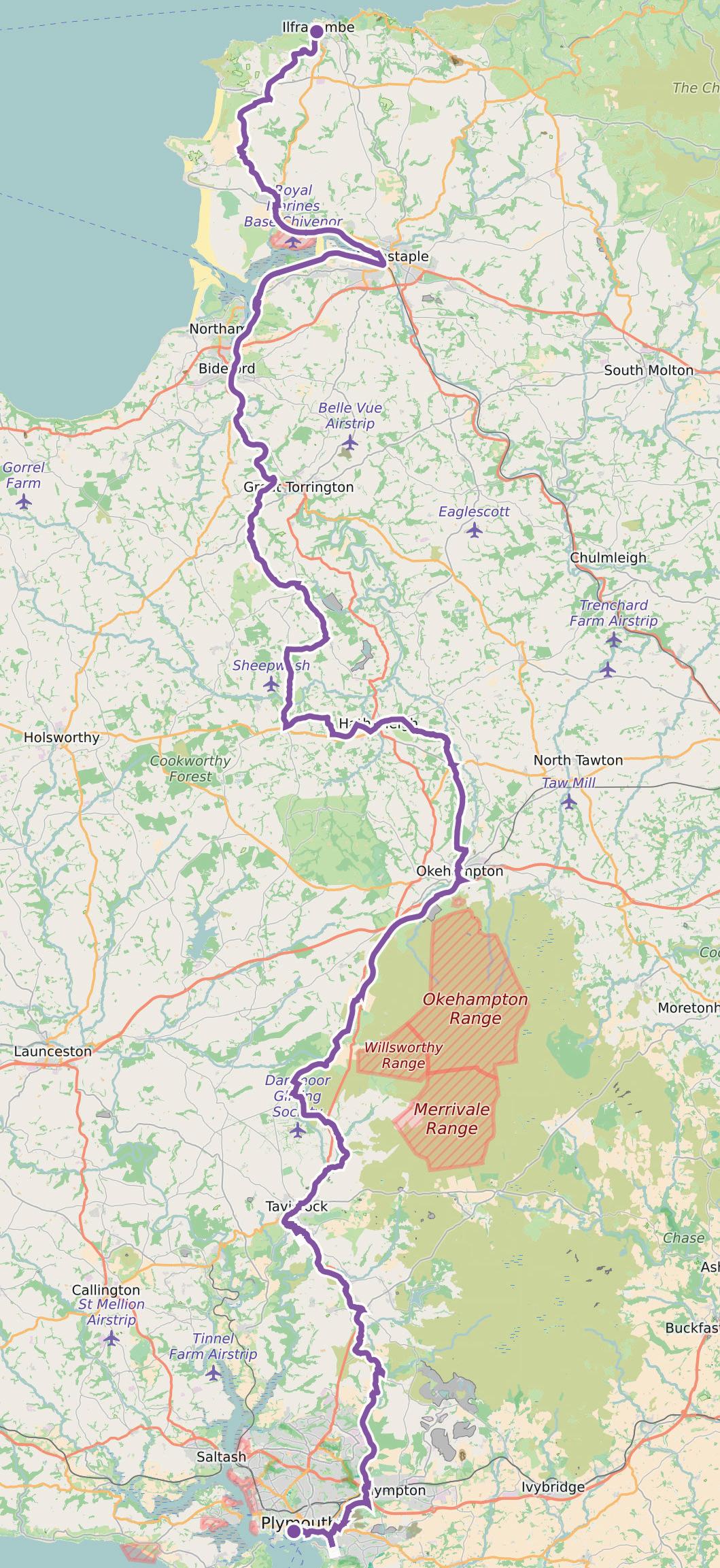


1 DRAKE'S LEAT
Approaching Dartmoor your route follows a former tramway and an intact 16thcentury waterway. Two ‘leats’ carried fresh water from three rivers to the expanding docks at Devonport and Plymouth. Construction was overseen by Sir Francis Drake who, legend has it, rode his horse ahead of the water all the way to Plymouth.
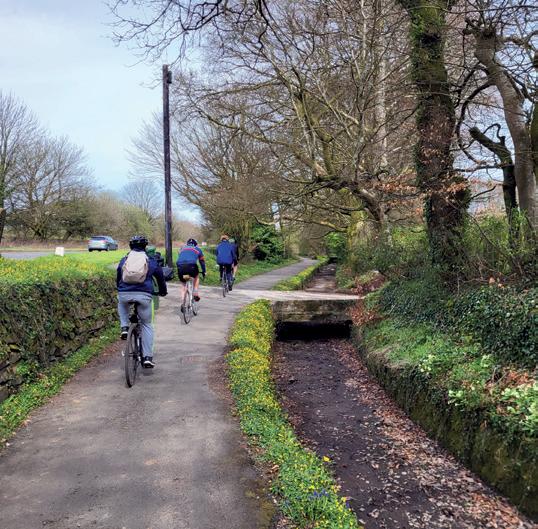
2 Norman Fort, Lydford
A medieval castle with its own prison, peering into its ruins takes you back almost a full millennia to its founding after 1066. Dismounting to wander around the site, including the later Norman additions, gives you a breather after some stiff climbs.
3 F armer's gates near Sourton
On the rail trail near Sourton and Prewley Moor, two gates bookend a liminal space of rocks and saplings, which the farmer retains the right to lock at their pleasure. If it’s closed, follow the detour map on the gates.
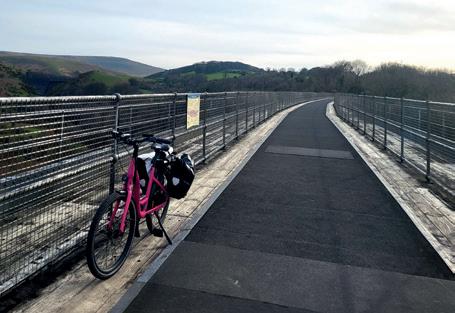
4MELDON VIADUCT
This wonder of Victorian engineering was built in 1874 and spans 164m between steep hillsides. Beneath it are former mineral mines. Almost 50m high, and with views towards Dartmoor and Meldon Dam and reservoir, this truly is breathtaking.
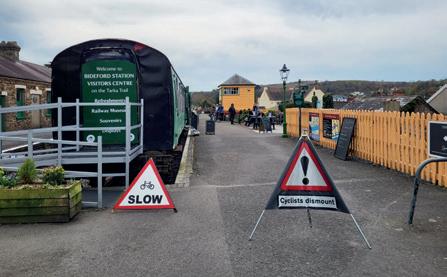
5 FREMINGTON
Delightful riverfront spot with a café in the former railway station. Grab some refreshments and look out over the water. The waterfront stretch from Bideford is a delight, affording plenty of photo opportunities.
6 Barnstaple
This historic town grew rich on wool imports from the 14th century, and glimpses of its age – and splendour – can be sniffed out. Peek in the restaurant at 62 The Bank for a jaw-dropping, intact Jacobean plasterwork ceiling, completed in 1620 and featuring an array of creatures, including dizzylooking elephants.
48 cycle JUNE/JULY 2024 WEEKENDER DEVON COAST TO COAST
2 6 3
1 4
5
Map © OpenStreetMap, produced with Inkatlas.com. Photos by Laura Laker



Great Rides
DUSK ’TIL DAWN
Cycling through the night is an achievable adventure that’s best enjoyed with company. Matilda Welin is a member of night-riding group the Fridays





Just after midnight on the last night of April: our group of seven had pedalled for what felt like hours through dark, freezing Cambridgeshire fenland. Finally, we emerged onto a bigger road. A much-anticipated petrol station was lit up next to a junction. Hands almost numb, I approached the night hatch.
“Do you serve hot beverages?”
“Hot beverages? No.”
I was on an overnight ride from Ely to King’s Lynn and back with the Fridays Cycling Club, a Cycling UK affiliate. Tonight’s guide, Claire Geary, had said that while the garage would likely serve coffee and tea, we couldn’t be sure. Now we felt our spirits drop. Claire approached the hatch beside me.
“You don’t serve hot drinks?”
“Drinks? Of course.”

Ah-ha! My accent and frozen lips had muffled my delivery. Lesson number one for exhausted, overnight cyclists: don’t attempt foursyllable words when onesyllable ones will do.
FRIDAY NIGHT’S ALRIGHT (FOR RIDING)
The Fridays has been arranging overnight rides from London to the coast for almost two decades, with groups containing anything from a handful of people to more than a hundred. Always moving at the pace of the slowest rider, the group has ‘tail-end Charlies’ at the back, leaders at the front and wayfinders who stop to point directions at junctions. The rides are almost like a night-time parkrun for cyclists – invigorating and adventurous but gentle and relaxed, too. Participants range from Lycra-clad roadies to recumbent cyclists and bearded 70-year-olds on Bromptons.


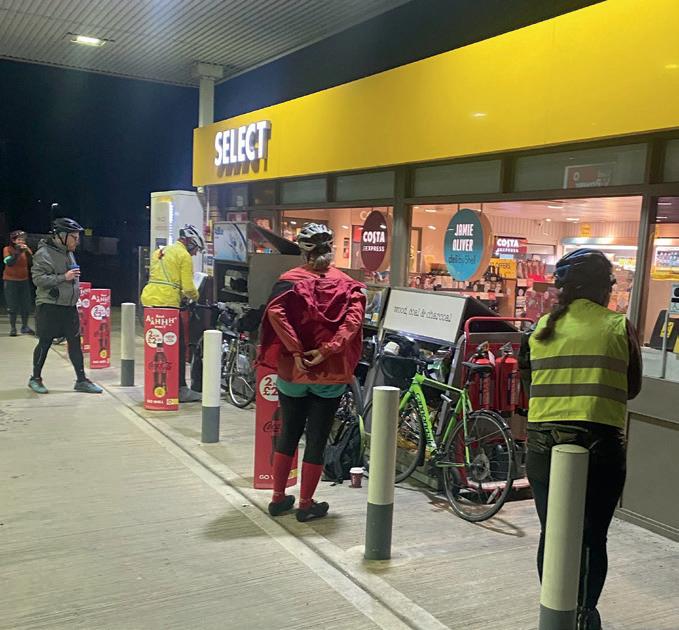
I first took part in the late 2010s. Back then, I was an everyday cyclist, riding a city bike around town and enjoying the odd, gentle cycle holiday with my family. But I sensed there was more. In 2016 I heard about the Dunwich Dynamo, a 180km ride from London to Dunwich on the Suffolk coast. I was keen to try it but I rode a secondhand mountain bike and dressed in worn-out
50 cycle JUNE/JULY 2024 GREAT RIDES NIGHT RIDING
MATILDA WELIN
Matilda is a Cycling UK member whose day job is working for the BBC
from start to finish
Top: No one gets left behind on the Fridays’ rides. They’re group rides
Photos: Titus Halliwell, Barry Wilson, Matilda Welin
Hot drinks for the Fen Bridges riders!
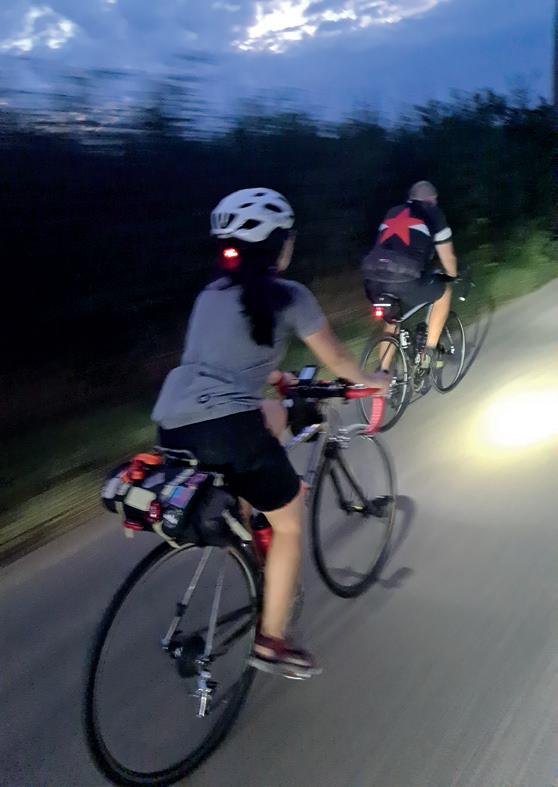
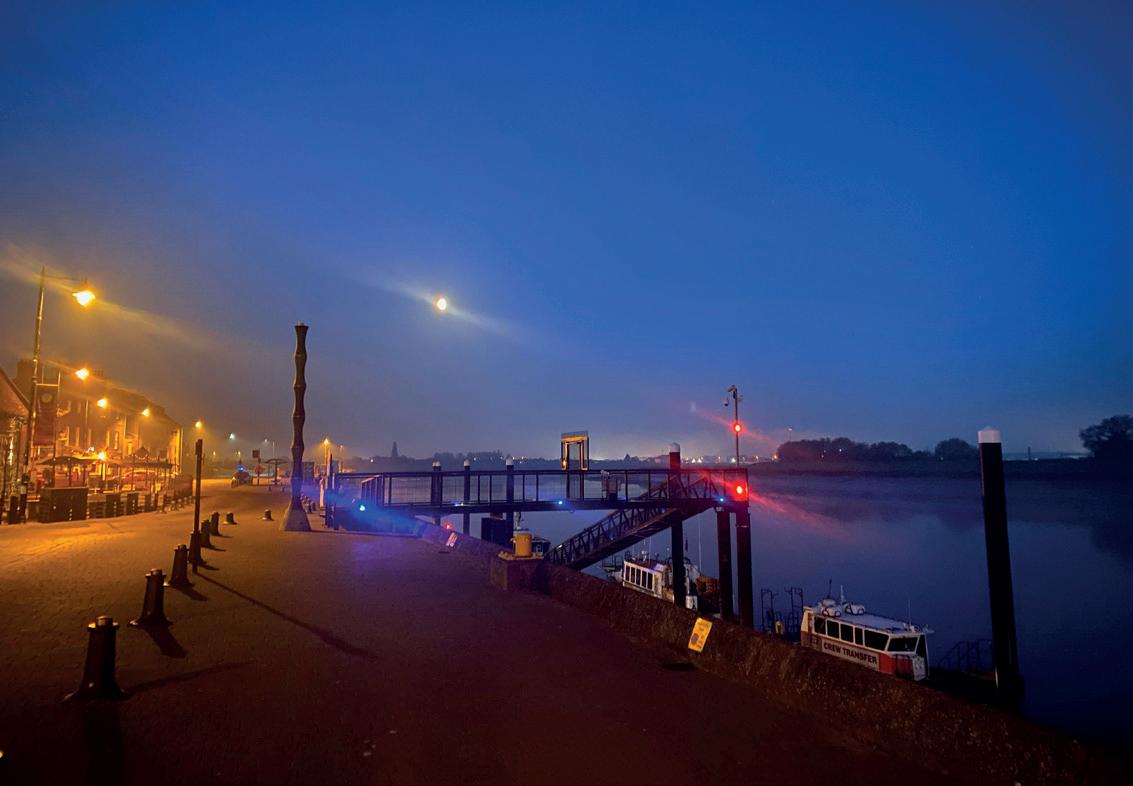
running shoes and jeans. I didn’t do the Dynamo that year; I did discover the Fridays.
On a rented town bike, I joined 40 or so others cycling from London to Whitstable on the Kent coast. It felt like an adventure. We stopped in Strood and paid a few pounds for rolls and handmade cakes served by volunteers, with the money going to a charity for disabled children. Later, as someone fixed their flat tyre, ride leader Tim pointed out Soviet submarine the Black Widow, looming in the dark River Medway.
After serving as a wayfinder and stopping to direct stragglers at a junction, I raced to catch up with the rest of the group ahead. For a few, glorious moments I was alone on a dark road. It was scary and liberating. Then I turned a corner – and there they all were, warm bike lights glowing. For the last seven miles of our ride, once dawn had broken, those of us keen to sprint broke free for a last, glorious descent into Whitstable and the breakfast café on the seafront.
The next year I joined another ride, borrowing my first ever road bike with toe-clips from a fellow Fridays member. We rode to Shorehamby-Sea. Soon after, I signed up for the 300km Vätternrundan sportive in Sweden, renting a road bike and learning to ride with cleats. There followed more night rides and, finally, the Dynamo. When I arrived in Ely in 2021 for the King’s Lynn ride, I had my own road bike, cycling shoes and fingerless gloves. I had, thanks to the Fridays, become a fully fledged night cyclist.
CYCLING INTO THE SUNRISE
After our petrol station stop in the Fens, we continued to King’s Lynn and a brief tour of the riverside before beginning our ride back. Cycling in the Fens at night, it turned out, was almost like being at sea. You felt yourself surrounded by a low, flat nothingness. No hills. No trees. A distant, almost indiscernible horizon. Houses and patches of street lightning emerged from the dark, then receded. I was glad of the others’ company. Claire shared her knowledge about the
Cycling in the Fens at night was like being at sea. You felt yourself surrounded by a low, flat nothingness. No hills. No trees

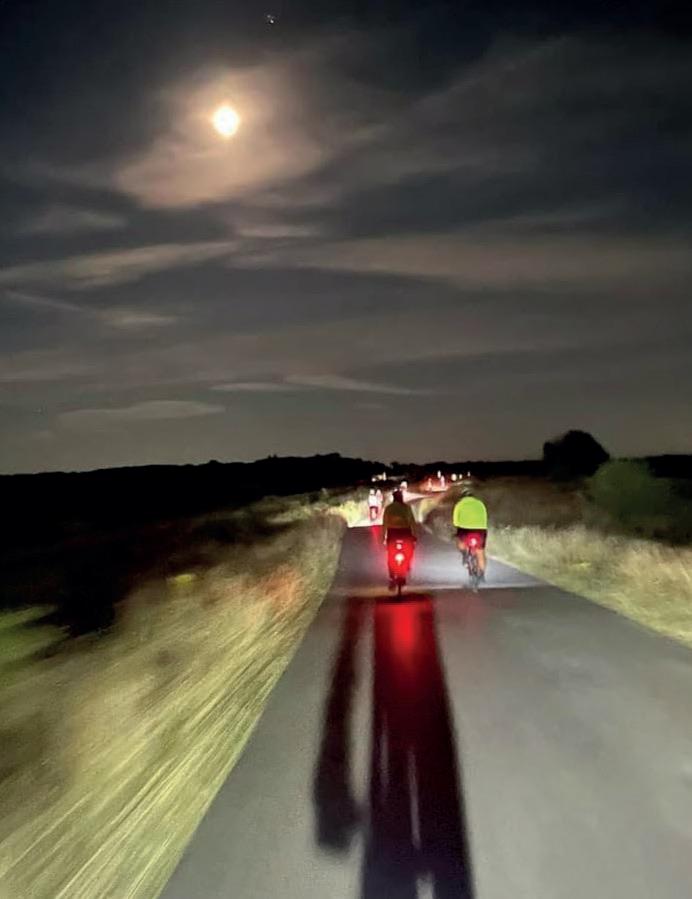
Fact file Fen Bridges night ride
Distance: 80 miles. Fridays routes range from 55-75 miles.
landscape – how attempts to drain the marshlands had been ongoing since Roman times, and how the Dutch installed a muchopposed, costly drainage system that resulted in the dry peat bogs disintegrating and the land sinking even lower than before. At one point, the already flat road made a small dip. “Now we are cycling below sea level,” Claire announced. When you cycle through the night, the same thing always seems to happen with your mood. You start out energetic and excited but towards three or four o’clock in the morning, your enthusiasm fades. It’s dark. It’s cold. There’s no one else around. But the sunrise is not far away.
Slowly you become aware of a shift in the quality of the darkness. You can see the landscape around you. The dawn chorus starts up. A car drives by. The people inside are not on their way home after a long night, you realise; they are awake to go to work because it is a new day. An early morning pensioner walks a dog. The occasional other cyclist passes on their way to work. Now there’s life inside the houses by the road. You are back in the land of the living. And you’re still riding.
After passing Denver Sluice, the heart of a system protecting the Fens from the invading North Sea, we started on a long path following the River Ouse. Here my energy levels flagged. But when I struck up conversation with one of my fellow riders, a little bit of vigour returned.
FRIDAYS ON MY MIND
The Fridays Cycling Club was started in 2005 by Simon Legg. “One night he got a few friends
Route: From Ely in Cambridgeshire to King’s Lynn in Norfolk, and back via a different route.
Conditions: It was cold for late April, with a chilling wind blowing in from the Wash. Roads were mainly narrow tarmac lanes and canal paths.
Bike used: My beloved Cannondale road bike obtained through the Cycle to Work scheme and continuously upgraded ever since.
Maps/guides: The beauty of Fridays’ rides is that you don’t need a map or even a general sense of direction – the ride is carefully guided for you throughout.
I’m glad I had… My gloves. Riding through the night can be cold, even in late April. Next time I would… Engage others in conversation as soon as I felt my energy levels drop. It seems counterintuitive but it can really help.
More info: fnrttc.org.uk
CYCLINGUK.ORG cycle 51 NIGHT RIDING GREAT RIDES
Left to right: Summer nights are best for big rides, being shorter and warmer. King’s Lynn – the halfway point for the Fen Bridges. Good lights are essential on any night ride

Bright ideas
• Sleep in as much as you can the day before.
• Conversely, accept that you might sleep badly due to being nervous. That way you won’t fret so much if it happens.
• Use powerful lights! Riding in the dark is less about merely being seen (which is key for city riding) and more about seeing where you are going. I sometimes use my nightrunning headlamp – either around my forehead or around my bar bag.
• You tend to eat fewer snacks than you think you will but do bring some.
• Dawn will give you an energy boost. Hang on until then!
• Never drive after an all-night cycle excursion. It’s not worth the risk.
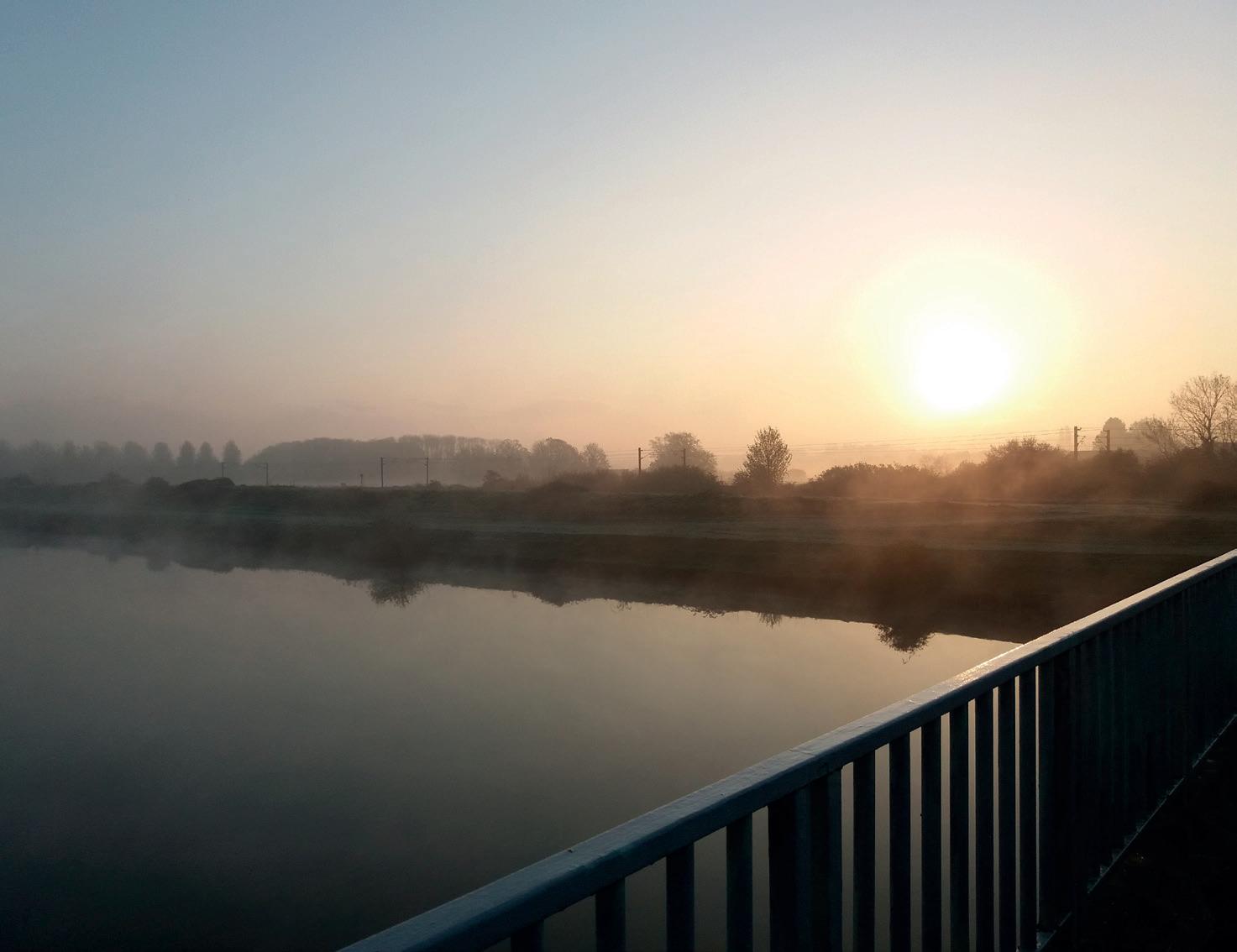
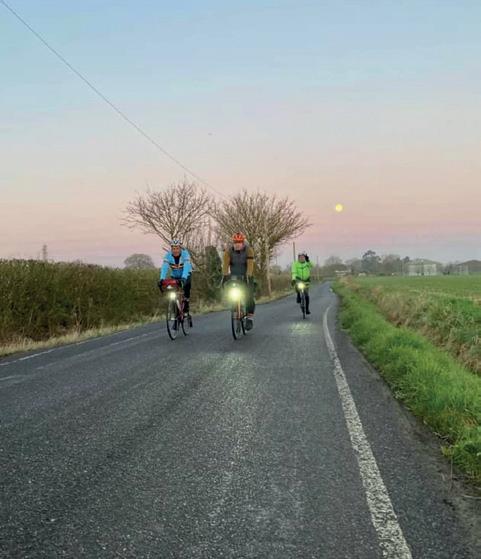
and they cycled overnight to Brighton at a conversational pace, had breakfast there and headed home,” Fridays organiser Titus ‘Bob’ Halliwell tells me over the phone. “They said: ‘Let’s do it again.’ They brought friends along and it grew and grew.”
Titus did his first Fridays ride in 2009. He soon started taking part in other cycling events, too, like the Dynamo, London-Edinburgh-London and Paris-Brest-Paris. The Fridays, he says, is a gateway drug.
In 2015 when Legg, who until then had done all the planning and admin, decided to step down, Titus and some other regulars asked if they could take on the job. “We all thought we’d do it for a couple of years,” he says. “But some of us are still doing it.” Newer members help, too. Today the club has 2,000 members.
The new leaders have been conscious of keeping Legg’s ethos alive. “Anyone is welcome as long as you have a bicycle,” Titus says. “It doesn’t matter if it’s a £50 mountain bike or a £5,000 road bike.”
Other clubs can be quite misogynistic and all about performance, he says, but although there is still a male bias in the Fridays – around 40% of riders are women – that is not the mood here. “If you come on a ride, we’ll get you there. It’s a pleasure to see new riders arriving at a seaside town, realising they have cycled through the night. That is what keeps many of us going.”
But what, I ask, happens
Slowly you become aware of a shift in the quality of the darkness. You can see the landscape around you. The dawn chorus starts up
if people are simply too slow? “There are a few rides where we have suggested quite strongly that people leave,” Titus says. “But they are not left behind. It’s done in agreement with them. Stronger riders may show them the way to the train station. You have to think about the benefit of the whole group. If it’s really cold and 60 people end up standing about waiting for someone who is a lot slower, for example, it gets very cold.”
As the Fens ride continued onwards that April morning, I was not at risk of falling behind but I was tired. When would the River Ouse cycle path end? And when would we see Ely Cathedral – the ship of the Fens – towering over the surrounding land and heralding the end of our tour?


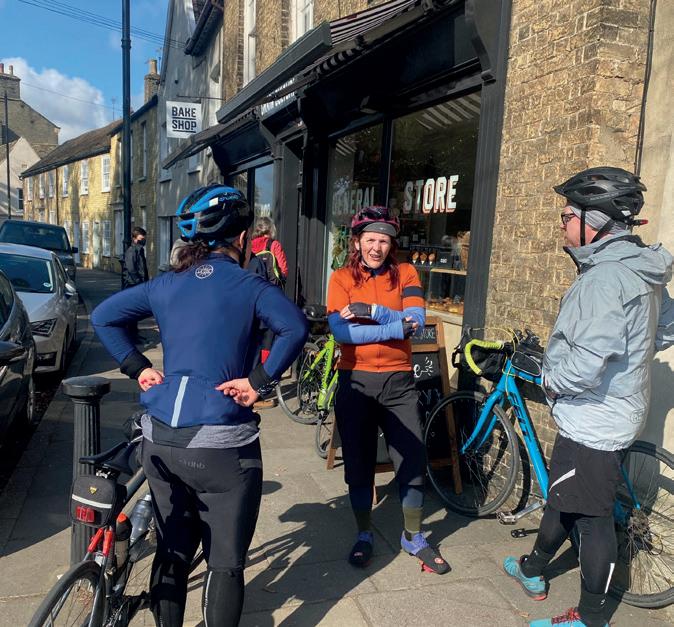
Finally we arrived at Ely’s Market Square. Around us milled people who had just woken up, looking fresh and rested in the bright sunlight. After buying coffee and perusing the food stalls, we sat on a low wall to eat and chat. Soon I cycled back to the train station to take the train home for some sleep. Another night ride was over.
52 cycle JUNE/JULY 2024 GREAT RIDES NIGHT RIDING
Back at Ely in the morning for coffee and farewells
Left to right: Dawn is always a long way into an overnight ride but gives an energy boost when it arrives. Early morning roads are wonderfully quiet. A misty sunrise on one of the bridges the Fen Bridges ride is named for
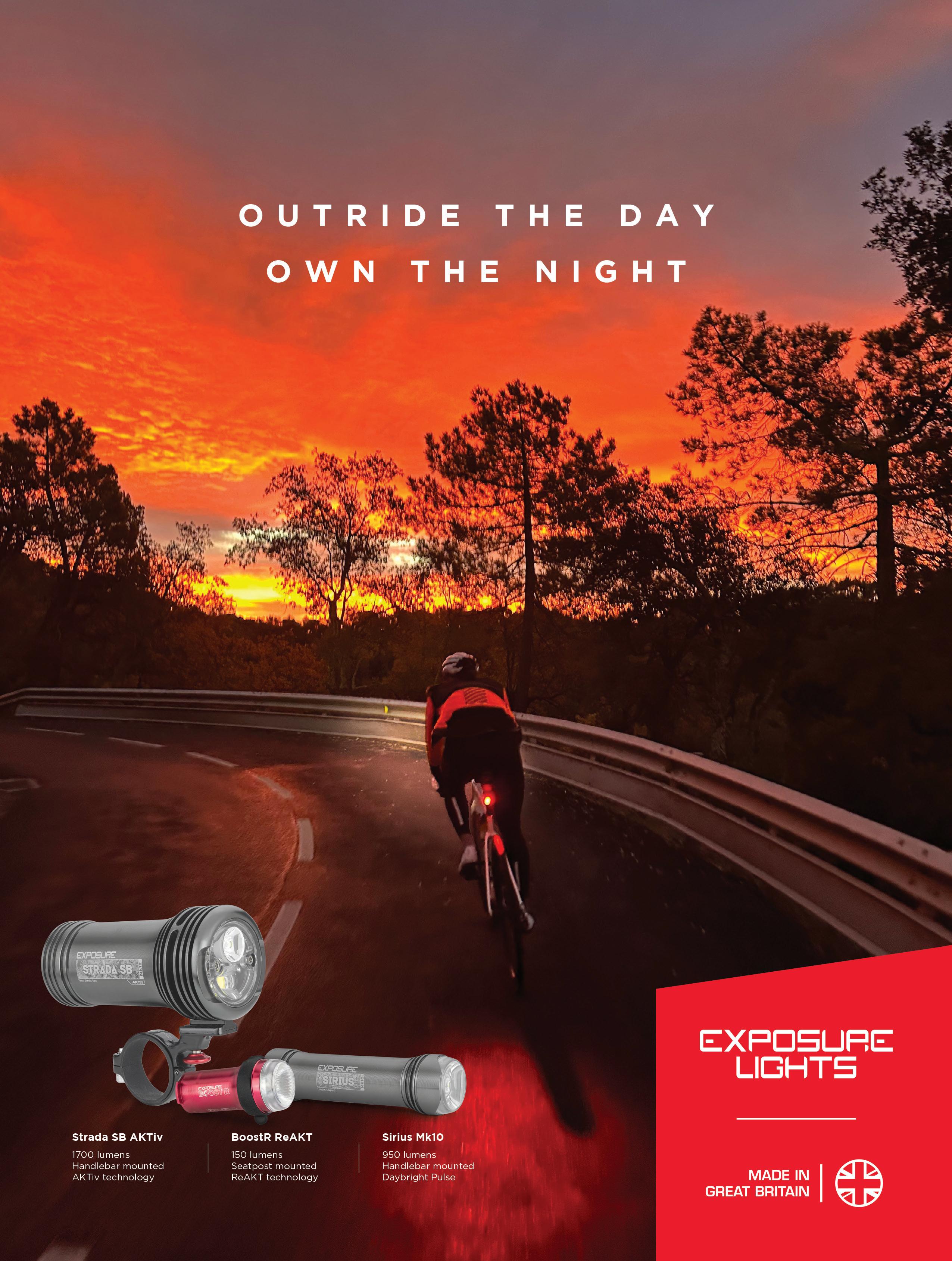
Questions answered, subjects explained – Cyclopedia is your bimonthly cycling reference guide

Q
& CYCLOPEDIA
ALegal Case closed
QWhat’s the advice and legality regarding temporary road closures for cyclists? If the closure is with bollards, experience shows that 90% of the time cyclists and pedestrians can get through safely. If there’s a metal fence across the road it’s pretty clear it’s closed to all users. I had a ticking off from a council guy after scooting between cones at a ‘road closed’ sign.
Dave Rowell
AWhile I can see a certain practical logic in what you say, I am sure that unless the sign were qualified in some way, one has to accept it at face value or face potential consequences.
The Highway Code features a circular white sign with a red border, under which is notice that reads ‘No vehicles’. The interpretation is given as ‘no vehicles except bicycles being pushed’. But that probably wasn’t the sign that confronted you.
When might the meaning be tested? Most likely in a civil court if some misfortune had befallen you. It’s not immediately clear precisely what argument could be advanced if, for example, you had dropped your bike on some spilled slippery substance, sustaining injury. The council would point to the sign and bollards and invite a judge to consider
Your Experts

DR
KATE BRODIE Retired GP {Health}
 RICHARD HALLETT Cycle’s technical editor {Technical}
RICHARD HALLETT Cycle’s technical editor {Technical}
 PAUL DARLINGTON Consultant solicitor, Cycle SOS {Legal}
PAUL DARLINGTON Consultant solicitor, Cycle SOS {Legal}
the reasonable road user’s interpretation, which I am confident would not include an implied exception for cyclists.
Wearing my Bikeability instructor’s hat, it would not be acceptable to permit students to apply their own interpretation.
Paul Darlington
Technical
Suspended load
QI’m thinking of buying a FreeQence stem (cyclinguk.org/freeqencestem) but I have one question. At present I have a KlickFix bar bag mounting bracket. This has a cable going over the handlebar and under the stem. Not sure if this would still work? If not, maybe the cable could go through one of the hinge pins if they are hollow? Be interesting to know if you think this is possible before I buy the stem.
Jonathan Smith
AThe FreeQence stem has been returned so I can’t make a direct examination, but I suspect the cable would rub against the pivot plates. It might be possible to pass the cable through the hollow pins but this would result in four sharp bends, which may prevent the cable from tightening properly. The obvious solution if you wish to use a bar bag in combination with a suspension stem is to opt for one of the other stem options in the review (Redshift Shockstop or TransX Antishock), either of which will happily accept the KlickFix cable.
Richard Hallett
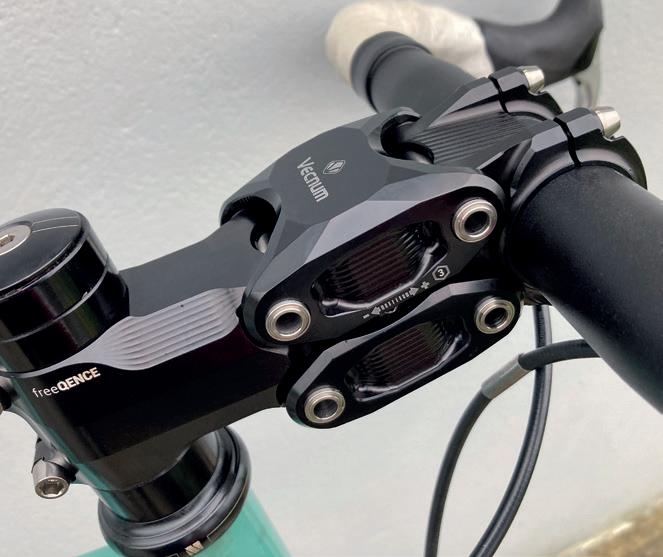
54 cycle JUNE/JULY 2024
Advice
Right: Getty Images

Breathing uneasily
QI will be 80 in a few weeks' time. Following chest and breathing problems and a visit to A&E, I have been diagnosed with bronchiectasis. I will be attending a chest clinic for advice but would appreciate information about this condition
Martin Watts
ABronchiectasis is a long-term respiratory condition that causes scarring and inflammation of the lungs. It results in coughing, breathlessness and reduced lung capacity, and may feature recurrent chest infections. More information can be found here: uk/conditions/bronchiectasis/. You may be offered inhalers, antibiotics and physiotherapy to help you manage the condition.
Technical
In charge on tour
QI’m a multi-day camping tourist who is looking to buy a rim/ sidewall dynamo to charge my Garmin and phone. I don’t ride at night so lighting isn’t a requirement. I would be grateful if you could suggest some cheap(ish) dependable generators.
Ian Coy
AThe PedalCell Rim Dynamo (cyclinguk.org/pedalcell) meets your requirements but does not appear to be currently available, while Velogical’s lightweight offering (June/July 2018) is even more expensive and needs to run at 30km/h or more to produce the power needed to charge your devices. Bottle dynamos driven by the tyre sidewall and generating the usual 6V/3W output are available online for under a tenner, but they are noisy and inconsistent. I strongly recommend having a wheel built around a dynamo hub for device-charging purposes – Shimano dynamo hubs are available from around £60 (DH-3N31-QR model, for example, although the DH-3N72 is pictured) and they work well. You’ll also need a USB dynamo charger such as the Cycle2Charge ) to turn the dynamo output into the 5V required by your devices and to provide a USB port.
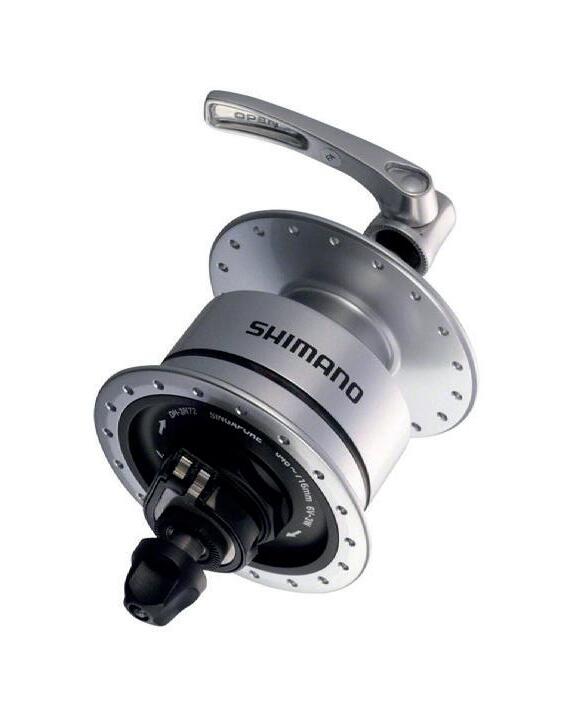
Richard Hallett
Technical
AYour chainset and cassette are the GRX 2×11 standard and work with the short-cage RD-RX810 rear mech. You should be able to substitute the RD-RX812 long-cage rear mech, which will handle an 11-42 cassette. This will need a longer chain and careful use of gears to avoid chain slack in some combinations.
Richard Hallett
Technical
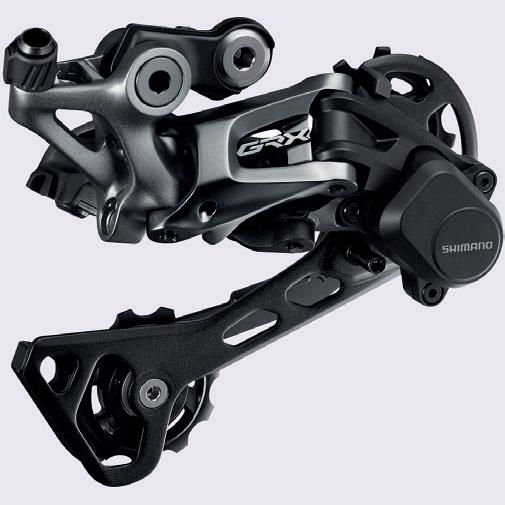


Torque talk
QRichard Hallett Health
You will be pleased to hear that exercise, and especially cycling, has been shown to improve lung function and improve all-round fitness in sufferers. Don’t be afraid of getting breathless when cycling: it won’t harm you as long as you take things steadily. Bear in mind, however, that extremes of heat and cold and air pollution will affect you more due to your reduced lung function. On those days stay indoors and use a static bike. You may also find an e-bike makes it easier to keep up with your cycling companions.
Dr Kate Brodie
Lower gears with GRX
QMy Genesis Croix de Fer has a Shimano GRX 11-speed mechanical groupset with a 46-30 chainset and 11-34 cassette. Living in a hilly part of Devon and no longer being a powerhouse rider, I am looking to lower my gearing. The advice I’m getting is that lower gearing is not an option due to ‘clearance issues’. I would appreciate your advice please.
Patrick Jeffery
I’m building a new bike. It’ll have a few carbon bits (steerer, handlebar, seatpost), which means I need to be careful not to over tighten crucial bolts. I understand that the tension in a bolt will differ for the same torque setting depending on whether the threads are dry or have grease, antiseize (or even threadlock) applied. Most manufacturers give a torque setting but generally don’t say how the threads should be treated (or not).
Tim Rusbridge
AA ‘dry’ thread – one assembled without lubrication – will require a greater tightening torque to achieve the same clamping force, due primarily to friction between the mating surfaces. Small threads in soft materials may even fail during tightening through damage to the thread surfaces, so it is usual to lubricate them with oil or grease. Component manufacturers specify tightening torques with this in mind and, in my experience, usually state that threads should be lubricated before assembly.

Get in touch
EMAIL your technical, health, or legal questions to editor@cyclinguk.org or write to Cyclopedia, Cycle, Cycling UK, Parklands, Railton Road, Guildford, GU2 9JX. Cycle magazine cannot answer unpublished queries. But don’t forget that Cycling UK operates a free-to-members advice line for personal injury claims, TEL: 0330 107 1789.
CYCLINGUK.ORG cycle 55
Q&A CYCLOPEDIA
Left: Getty Images



Bike finder
Which bike should I buy? Ask us at cyclinguk.org/bikefinder
Light, comfy belt-drive hybrid
For: Ian Nicholson, aged 55, from Glasgow. Bike needs: I commute on a 2018 BMC Alpenchallenge 02 ONE. It’s ideal for a city where it rains a lot: hub gears, belt drive, hydraulic disc brakes, mudguards. But I’m now finding the riding position uncomfortable as I have back problems. I’d like something similar that’s just as light but with a more relaxed, upright riding position. Must have: Hub gears, belt drive, hydraulic disc brakes, mudguard and rack compatibility. A more upright riding position. Must not have: Chain, derailleur, tyres narrower than 38mm. Budget: £2,000.



 MATT LAMY
MATT LAMY
Before I pitch any ideas, a quick managing of expectations. Modern bikes are holistically designed with all areas of their build aimed at a certain outcome. In your Alpenchallenge’s case, that’s a fast but practical flat-bar road cycle. The spec, weight and riding position are all part of this package, so it will be tricky to find the same ingredients in a more upright bike. (Spoiler alert: in this case, increased weight is probably going to be your key compromise.)
All that said, the Trek District 4 (£1,675, trekbikes.com) is a fine starting point. It has a more relaxed riding position, 8-Speed Shimano Alfine hub with Gates CDX belt drive, 40mm tyres, fitted racks and mudguards, and disc brakes. The one downside, as expected, is weight. It's 15.5kg.
Slightly lighter, but only by 100g, is Cube’s Travel Pro (£1,199, cube.eu). Overall spec is similar in nature to the Trek, although it features a lower-range Shimano Nexus 8-speed hub.
Perhaps best of the lot, Canyon has a whole host of viable models. I wondered if a step-through option, such as the Commuter 7 mid-step (£1,749, canyon.com) might help you to achieve improved comfort. Thanks to its very high spec, it weighs in at an easier-to-carry 13kg.
To finish, something of a left-field choice. Although it features drum brakes rather than discs and a chain-driven geared hub rather than belt drive, Pashley’s Parabike (£875, pashley.co.uk) does provide a more traditional riding position – and looks fab!


DAN JOYCE
 Ian Nicholson
Ian Nicholson

As Matt notes, lightweight hybrids – even those with belt drives – will come with the sportier, lower-handlebar riding position that you don’t want. There are belt-drive hybrids similar to your BMC, such as the Cannondale Bad Boy 1 (£2,000, cannondale.com), Cube Editor (£1,799, cube.eu) and Cube Hyde Race (£1,199). But they’ll probably be only slightly more comfortable than your existing bike.
You’ve said you like everything about your BMC except the riding position. So my recommendation is to keep the bike and just change how you sit on it. A 35º System EX stem (£21.99, extrauk.co.uk) will put the handlebar higher and closer than your BMC’s flat stem. That might be enough by itself.
If not, swap the handlebar as well. An On-One Geoff (£29.99, planetx.co.uk) or another bar with back-sweep (see p69 for ideas) would enable you to sit much more upright. The gear cable and brake hoses will likely be too short for the new bar/ stem combination, so you'll need to replace those.
If you’re desperate to scratch that new bike itch and don’t mind some extra weight, one option that ticks all your other boxes is the ARCC Abington Non Electric 8 Speed – Orange (£1,600, arccbikes.com). This has a taller head tube, a longer steerer tube and a riser handlebar so it will sit you more upright than your BMC. It comes with 38mm tyres and can be ordered with mudguards. While ARCC doesn’t quote a weight, it will be heavier than your BMC because it’s steel.
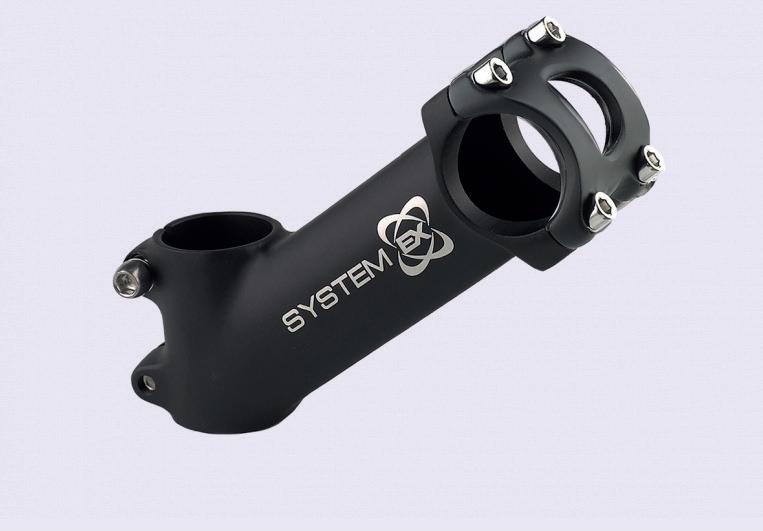
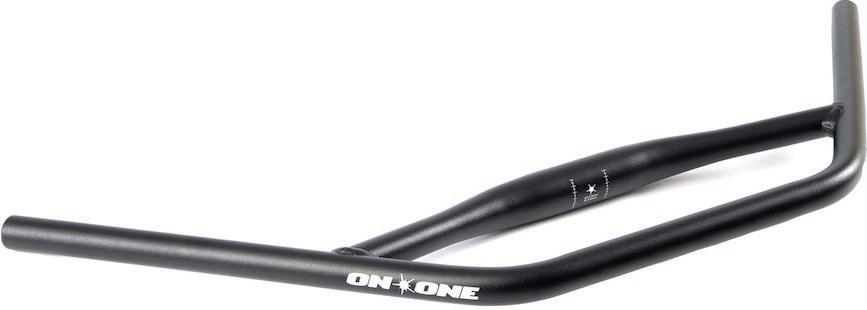

CANYON COMMUTER 7 £1,749 CYCLINGUK.ORG cycle 57 CYCLOPEDIA
SYSTEM EX 35º STEM £21.99 ON-ONE
HANDLEBAR £29.99
GEOFF
CYCLOPEDIA
Knowhow
Making sense of commonly misunderstood subjects
Groups
How can we build community through cycling?
Many people would assume cycling in a group is an elite sport for (primarily) male participants wearing Lycra and shoes that make a strange clickety-clackety noise when they dismount their carbon fibre machines to drink double espressos in a trendy café –if they stop at all during their 100-mile blast.
Happily, however, there are now groups working towards encouraging greater participation by people from communities that haven’t, until now, felt as if they ‘belonged’ in cycling at all. Nicola Carass is co-founder of the Cycling UK-affiliated New Forest Off-Road Club, which “centres on the experience of women, trans and non-binary people”, with some riders also at the intersection of perceived barriers such as disability, age or body size.
The group has a mission “to increase representation in the outdoors by providing guided, matriarchal experiences” and to supply the tools for others to do the same. ‘How to build community' workshops explain how the group is “dismantling the patriarchy, one ride at a time” and “guide others through how to start their own mission-led vibe”.
Nicola advocates cultivating a culture of community, compassion and tolerance when it comes to attracting people from underrepresented backgrounds to cycling. Her top tips for creating a space where everyone feels confident and connected include the following.
• Remove barriers such as expensive branded jerseys and other cycling kit. Let people to wear whatever they feel comfortable in.





• Don’t comment on or criticise their choice of bike unless it’s unsafe. “Recognise the inequality in bike ownership and make concessions and adjustments where needed.”
• Lead with empathy and vulnerability, focusing on community and opportunities for social contact above the amount of mileage covered.
• Assume everyone is doing their best. All mistakes provide a learning opportunity.
• Create a mission, vision and principles based on a shared mindset that reflects your group’s ethos.
• Equip people with the skills they need to become confident ride leaders, guides and mechanics by reinvesting any surplus funds into the group.
• Recognise that cliques can arise and take steps to ensure that everyone feels included.
• Focus on the pleasure of cycling and “recognise the glory of the matriarchy!”
• Form allyships with like-minded organisations and individuals.
• Celebrate difference and diversity so that people come for the riding but become ‘accidental activists’.
• Establish a network of facilitators from early adopters of the above principles.
Build your own community through cycling
Have a culture of ‘smiles not miles’ Create rides around a theme or food, such as a ‘pie ride’
Promote rides with interesting destinations
Take time to learn people’s preferred pronouns
she/her he/him they/them

Resources for groups
Cycling UK has a wide range of articles and resources for groups looking to attract a more diverse audience or people who wish to set up their own cycling clubs. From an Introduction to EDI (Equity, Diversity and Inclusion) webinar to an EDI officer toolkit to tips on how to set up a new group and welcome people to it, we’ve got it covered. Affiliation to Cycling UK also brings with it the benefit of peace of mind when it comes to having insurance for your activities, as long as they are run in accordance with our guidelines.
cyclinguk.org/local-groups
cyclinguk.org/new-forestoff-road-club
Avoid creating cliques by not only riding alongside people like you
58 cycle JUNE/JULY 2024
Photo: New Forest Off Road Club
JULIE RAND Cycling UK volunteer communications officer
New Forest Off-Road Club is actively inclusive

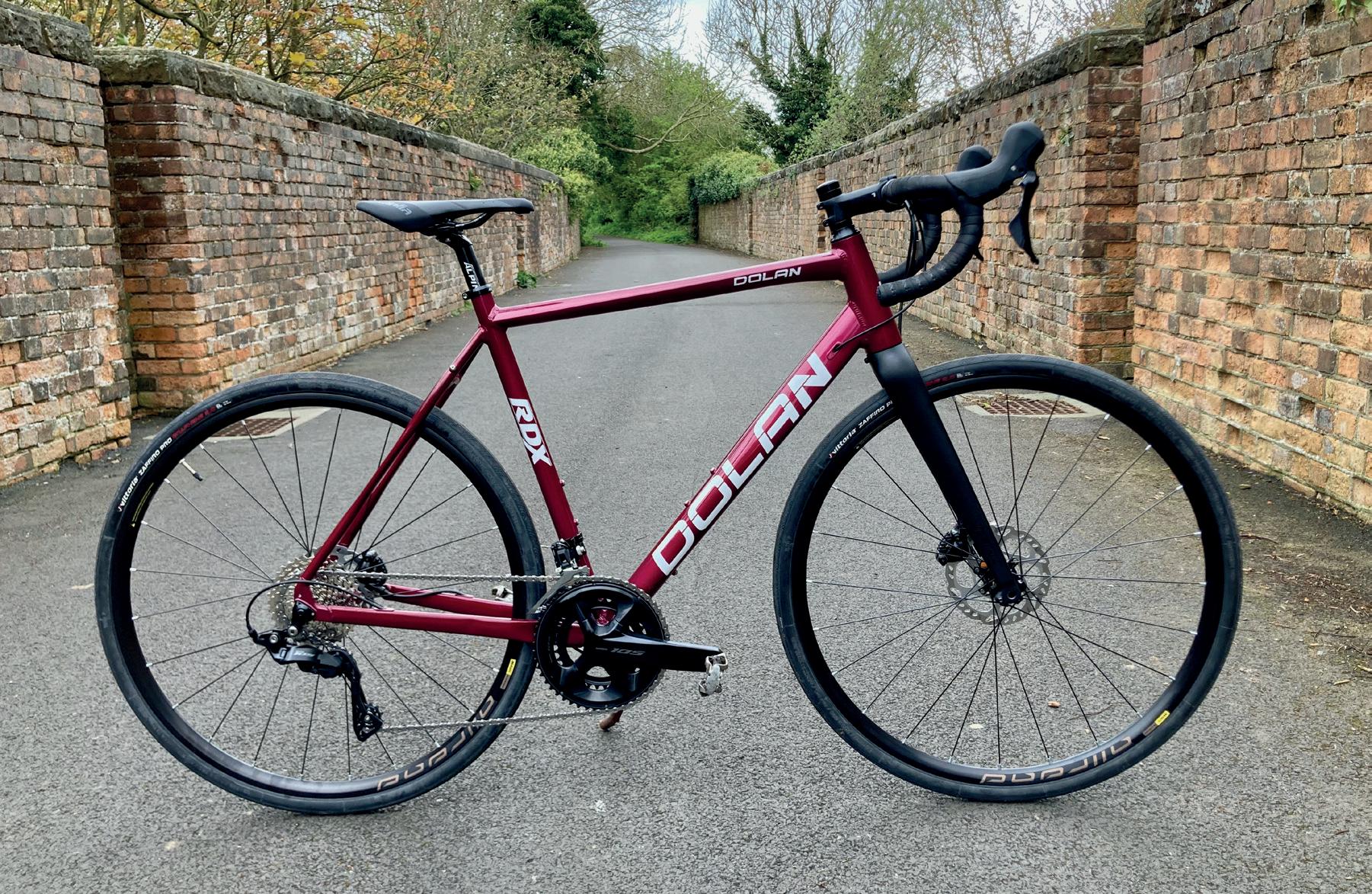
Bike test

DAN JOYCE
Dan is 177cm tall (5ft 9 1/2in) and weighs 63.5kg (10st). He rides with his local club’s fast group, despite unfashionably high handlebars on all his bikes

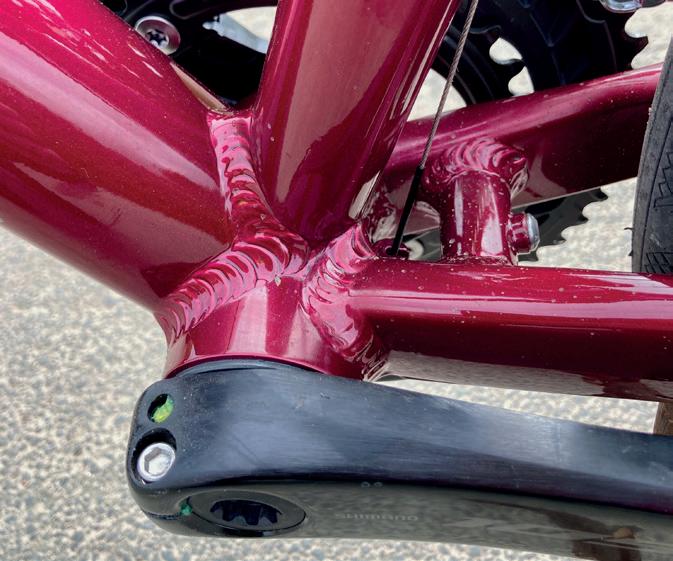
Aluminium all-rounders
Fancy a road bike that isn’t an overly expensive one-trick pony? Dan Joyce tests two from British brands: a Dolan RDX and a Kinesis R1
Road bikes that will take wider tyres, mudguards and a rack tend to be branded winter bikes or commuters.
The implication is that proper road bikes are too thoroughbred and expensive for such tasks. Too expensive might be right; some cost £12,000! But it’s odd to make a virtue out of a lack of versatility. What’s not to like about a road bike that will tackle everything from commuting and club runs through to sportives, lightweight touring and even some gravel rides? The fact that you don’t need a dentist’s salary to buy one is a bonus.
The bikes on test, both from British brands, cost around £1,500. Both have nice aluminium frames, full carbon forks, tubeless-ready wheels, hydraulic disc brakes and decent drivetrains – Shimano 105 and SRAM Apex. They weigh just under 10kg, which isn't too heavy unless you’re a whippet-thin racer,
and they both have a riding position that’s ‘endurance’ rather than ‘race’. For most purposes, that’s better.
The Dolan RDX is offered in four different builds, each of which can be fine tuned further using the configuration options on Dolan’s website. The R1 is Kinesis’s gravel-influenced road bike. Unlike the Dolan – and its own R2 stablemate – it has a 1× drivetrain.
Frame & fork
The test bikes are different sizes because, at 177cm tall (5ft 9 1/2in), I’m invariably borderline between M (54cm) and L (56cm). I often pick L in road bikes because that results in a taller head tube, and thus less back strain, and more toe room. The longer reach can be fixed with a shorter stem – one of the options available with Dolan’s bike configurator. The Kinesis comes as it comes. The medium looked like
60 cycle JUNE/JULY 2024 BIKE TEST ROAD BIKES
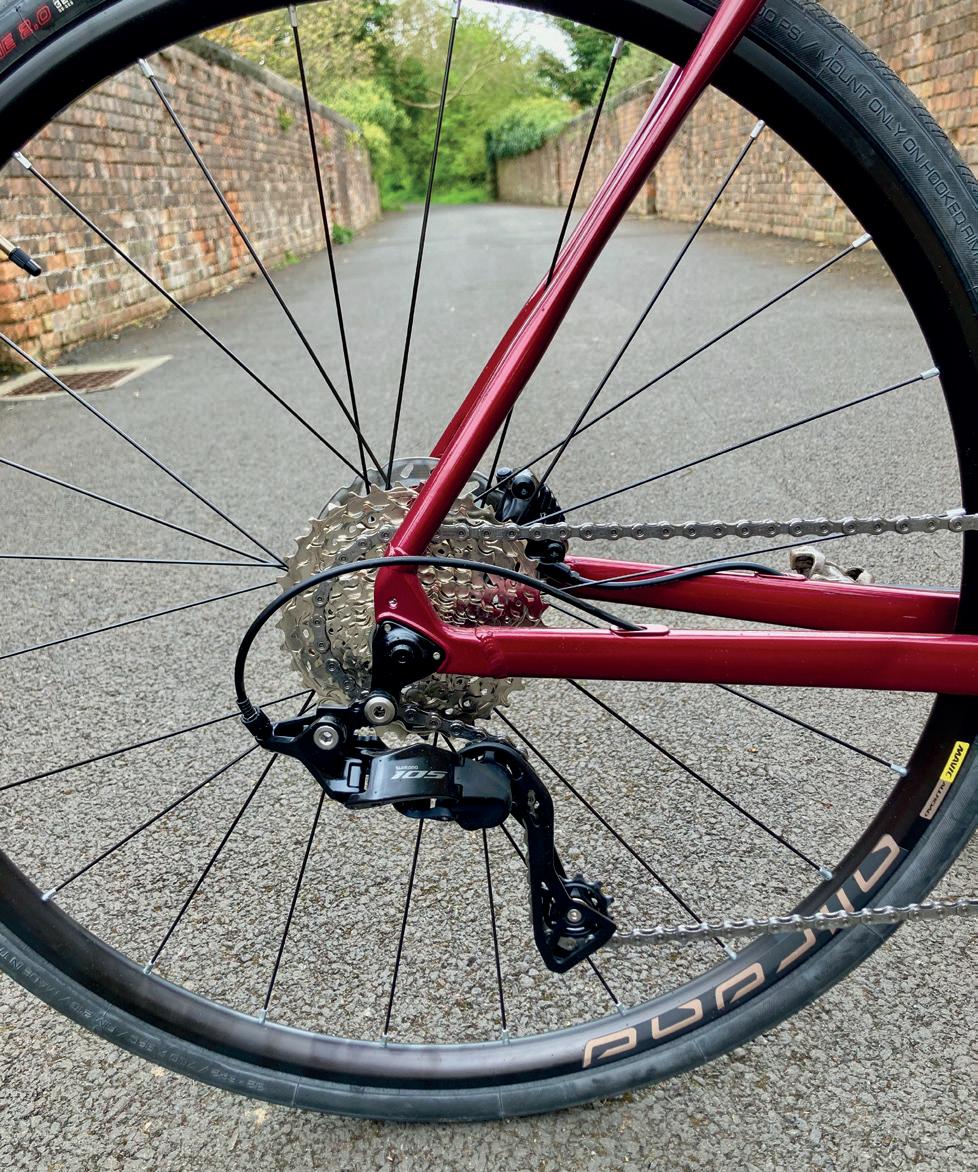
it would fit me better out of the box than the large. It did – albeit with toe overlap that the large would have avoided.
Both bikes are neatly TIG welded from butted aluminium tubes. The down tubes are biaxially ovalised – vertically at the head tube and laterally at the bottom bracket – to improve strength and stiffness where it’s needed. Although the Dolan and Kinesis tube profiles differ, I didn’t notice any difference in stiffness. Cables and hoses are internally routed, which is both neat and annoying. The Dolan goes further (and fiddlier) in running the rear brake hose and derailleur cable through the chainstays.
First look Versatile, good value road bike with big clearances, 12-speed 105 and à la carte options
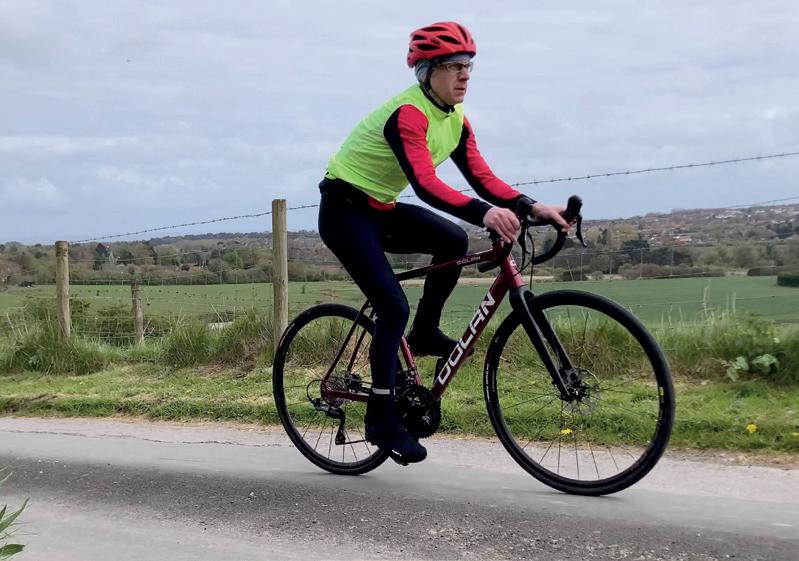

Tech spec
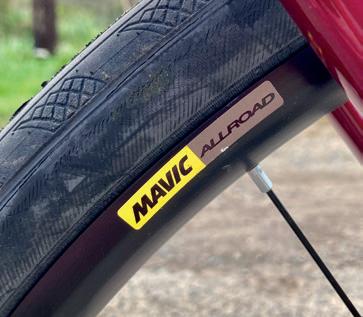
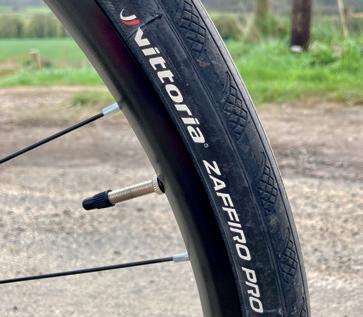
without. The Dolan is listed as taking tyres up to 32mm with guards and 35mm without, but my vernier callipers say it will run 35mm with guards and 42mm without – and perhaps wider still.
The Dolan RDX is offered in four different builds, each of which can be fine-tuned using the configuration options on the Dolan website
RDX 12S 105 R7120
Price: £1,509.97 as tested (from £1,449.98, frameset £499.99).
Sizes: 49, 52, 54, 56 (tested), 58cm.
Weight: 9.95kg/21.9lb.
Top: Tubeless-compatible rims but not tyres
Bottom: These are nominally 32mm but plump up to 35mm on the wide Mavic rims

In terms of geometry and frame clearances, the Dolan and Kinesis resemble gravel bikes as much as endurance road bikes. They have: a taller front end, which is more comfortable; a head angle of 72 degrees, which gives a bit more stabilising trail than 73-74 degrees; and room for bigger tyres. The Kinesis will take 30mm tyres with mudguards (maybe 32mm) and 36mm
Both bikes have fittings for mudguards and a rear rack. The Kinesis has mounts for two bottle cages, the Dolan three; there’s an extra set under the down tube. I prefer the 68mm threaded bottom bracket shell of the Kinesis to the Dolan’s press-fit but it’s not a deal breaker. I’d fit a screw-together bottom bracket from (for example) Wheels Manufacturing when the Dolan’s bottom bracket needed replacing. This would keep the bearings aligned and (in theory) problem free.
Components
Like Ribble, whose Endurance SL Disc Sport I tested recently (cyclinguk.org/ endurance-road-bikes), Dolan has an extensive component selection menu. I really like this, not so much because you can add accessories or upgrades –although that’s nice – but because you
Frame & fork: Triple-butted 7005 aluminium frame with press-fit BB, 142×12mm axle and fittings for rear rack, mudguard, three bottles. Full carbon fork with tapered steerer, 100×12mm axle and mudguard fittings.
Wheels: 32-622
Vittoria Zaffiro Pro 2.0 tyres, Mavic Allroad Disc wheels (tubeless compatible 622×22 aluminium rims, 24×2 spokes, Mavic Center Lock hubs).
Transmission: no pedals, 170mm 105-R7100 chainset, 50-34 chainrings, Shimano BB86 bottom bracket, Shimano M6100 chain, Shimano 105 R7100 12-speed 11-36 cassette. Shimano 105 R7120 levers and R7100 derailleurs. 24 ratios, 26-124in. Brakes: Shimano 105 R7120 levers and callipers, 160mm/ 140mm f/r rotors. Steering & seating: 380×31.8mm Deda Zero RHM bar, 80mm×8º Deda Zero 1 stem, Alpina 1 1/8-1 1/2 F35 headset. Selle Italia X3 Boost Flow saddle, 27.2×350mm Alpina setback seatpost. dolan-bikes.com

ROAD BIKES BIKE TEST CYCLINGUK.ORG cycle 63
DOLAN
Dimensions in millimetres and degrees 73˚ 1037 170 622 142 560 437 60 35 278 610 810 565 657 72˚ 694 65 45
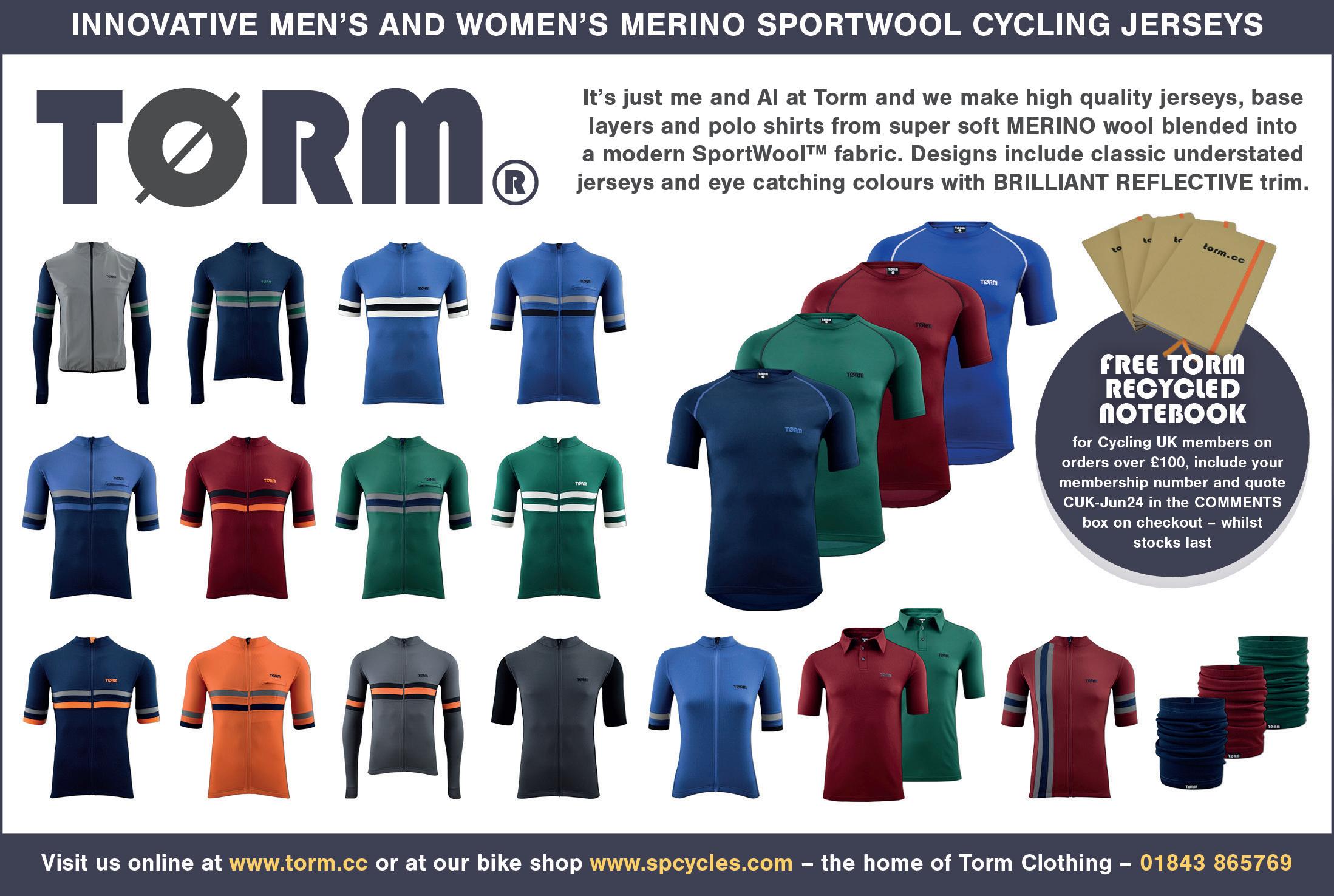


First look
Gravel-influenced road bike with practical frame fittings and a 1× drivetrain

can match the specification to your riding preferences. I chose: 170mm cranks, an 11-36 cassette, a layback seatpost, a 38cm handlebar and an 80mm stem. As a result, it fitted me as well as my own bike. I also selected 32mm Vittoria Zaffiro Pro tyres (+£59.99), which have a folding rather than a wire bead and are wider than the default.
The tyres of both bikes plump up larger than the advertised 32mm as they’re fitted to fairly wide rims.
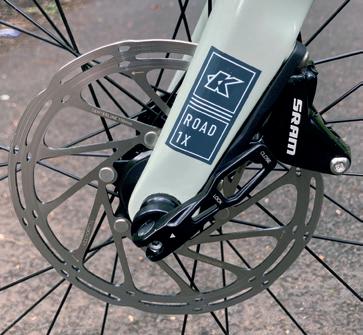
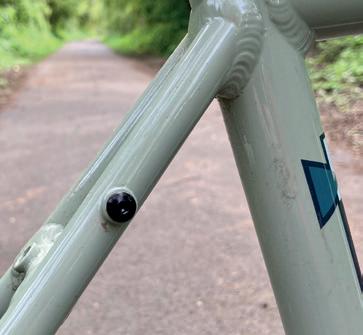

The wheelsets are both tubeless ready although the tyres are not. You can upgrade to tubeless at point of purchase with the Dolan, but those Vittoria Corsa N.EXT TLR tubeless tyres (+£89.99) weren’t showing as available at the time of the test.
Like the majority of bikes with disc brakes these have thru-axles. This helps stop the rotors chirruping on the pads and also prevents accidental wheel ejection. The Dolan’s Mavic hubs have cartridge bearings, which are easier to live with; just replace when worn. There are only 24 spokes apiece in the Dolan’s wheels. Even at my weight that strikes me as low, given that this bike might
carry panniers. Since they’re straight-pull spokes, you can at least replace any broken ones quicker, with the disc rotor and cassette in situ. The Kinesis has 28 (J-bend) spokes front and rear, which I’m happier with.
The Dolan uses the new 12-speed version of Shimano 105. While I consider the extra sprocket over 11-speed irrelevant, 12-speed 105 does introduce a useful 11-36 cassette option. With this fitted, the bottom gear is about 10% lower than the Kinesis (26in versus 29in). Shifting is as good as you’d expect from 105. I’ve never been a fan of 50-34 compact doubles, however; I usually wanted a chainring about halfway between these sizes.
Kinesis has gone full-on gravel with the R1’s drivetrain, fitting 1× SRAM Apex. You can have essentially the same bike with 2×10 Shimano Tiagra – the identically priced R2 – but I like 1× setups. While I’d prefer a slightly smaller chainring than the 44 fitted, the range of the 11-42 cassette itself is good. There’s not a lot to choose between the Dolan’s 105 hydraulic discs and
No gearing setup will suit everyone but I like the 1× Apex drivetrain of the Kinesis. It’s similar to what I use on my road bike
Tech spec KINESIS R1
Price: £1,680.
Sizes: S, M (tested), L, XL.
Weight: 9.87kg/21.7lb.
Frame & fork: Double-butted 6061 aluminium frame, 68mm threaded BB, 142×12mm axle and fittings for rear rack, mudguard and two bottles. Full UD carbon fork with tapered steerer, 100×12mm axle and mudguard fittings.
Wheels: 32-622
Continental Grand Sport Race tyres, 622×19 Jalco TRX 415 tubeless-ready aluminium rims, 28×3 spokes, Novatec Center Lock alloy hubs. Transmission: no pedals, 172.5mm SRAM Apex 1
Dimensions in millimetres and degrees
chainset, 44t X-Sync chainring, SRAM BB GXP bottom bracket, SRAM PC1110 chain, SRAM PG-1130 11-42t cassette. SRAM Apex 1 HRD shifter and SRAM Apex 1 long-cage derailleur. 11 ratios, 29-109in Brakes: SRAM Apex 1 HRD levers, Apex 1 HYD callipers, 160mm rotors. Steering & seating: 440×31.8mm Kinesis 6061 aluminium handlebar, 90mm×6º Kinesis 6061 aluminium stem, FSA sealed-bearing No. 42 integrated headset. Selle Italia X3 saddle, 27.2×350mm Kinesis 6061 aluminium seatpost. kinesisbikes.co.uk

CYCLINGUK.ORG cycle 63 ROAD BIKES BIKE TEST
Top: Hydraulic discs with 160mm rotors front and rear Bottom: Fittings for proper mudguards and a rear rack provide year-round practicality
74.4˚ 1005 172.5 622 142 540 420 60 34 278 595 785 545 650 72˚ 694 65 45

Cycle’s test promise
At Cycle, we are proudly independent. There’s no pressure to please advertisers as we’re funded by your membership. Our product reviews aren’t press releases; they’re written by experienced cyclists after thorough testing.

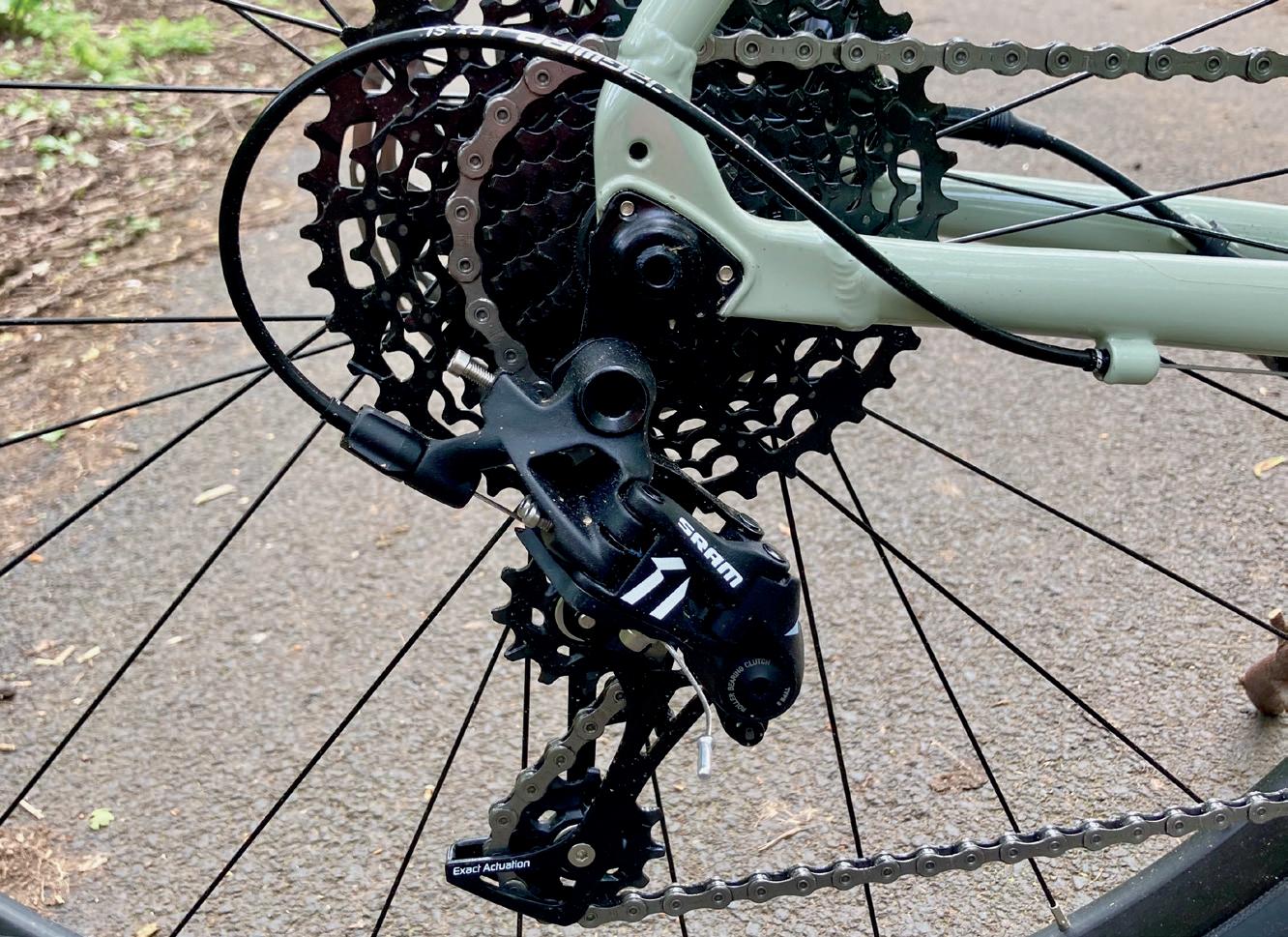
the Kinesis’s Apex ones. They’re both well modulated, with more stopping power relative to the lever effort than any rim brake I’ve tried. The bigger tyre footprints improve absolute stopping power as well.
The ride
Even with entry-level, innertube-only tyres, the plushness of wider, softer rubber is noticeable. It’s a large part of what makes both these bikes more comfortable than racers. Having more rubber in contact with the tarmac also improves traction and therefore cornering and braking confidence. There isn’t the same pressure to stick to tarmac-only routes, either.
No gearing setup will suit everyone but I like the 1× Apex drivetrain of the Kinesis. It’s similar to what I use on my own road bike. The sequential shifts are intuitive and you can change down on climbs without backing off on pedalling pressure like you do when shifting a front derailleur.
A wider-range 1× cassette means the steps between gears are bigger but this bothers me far less than the cadence-spoiling 16-tooth jump of the Dolan’s compact double. If you live anywhere lumpy or like to spin, you find yourself regularly shifting back and forth between the 50- and 34-tooth chainrings. So that big jump keeps on jarring. It's not like an 40-24 Alpine double, where you can just stay in the big ring most of the time.
I enjoyed riding the Dolan more overall
Other options

SONDER COLIBRI
AL TIAGRA
£1,099
The cheapest Colibri has an aluminium frame, carbon fork and 2×10 Tiagra with mechanical discs. It takes 32mm tyres with mudguards. Review at cyclinguk. org/sonder-colibri-al-tiagra alpkit.com
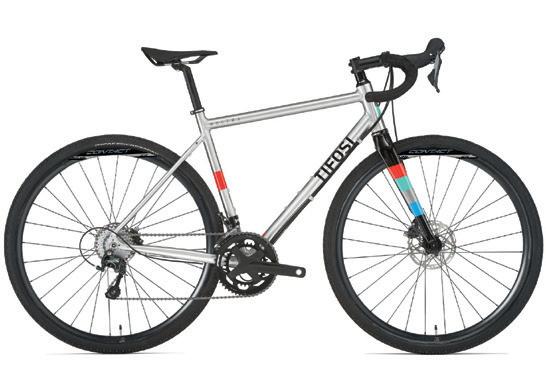
TIFOSI ROSTRA TIAGRA
£1,499
Aluminium frame and carbon fork again but with hydraulic Tiagra levers rather than mechanical. Takes 35mm or 38mm tyres (with/without guards.)
chickencyclekit.co.uk


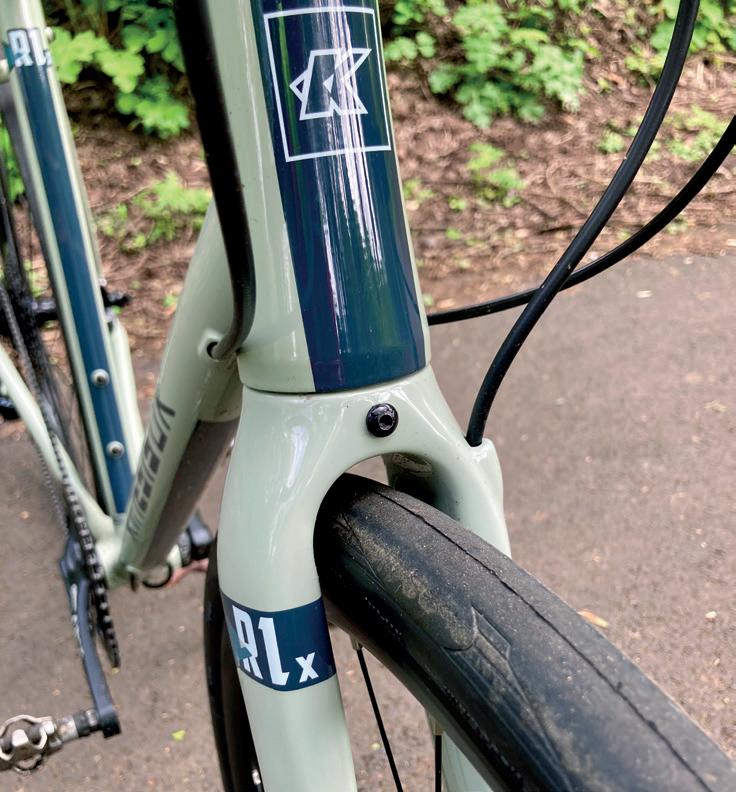
because the component choices available meant I could copy over the riding position from my own bike.
The Kinesis has a gravel-style flared drop bar that’s 44cm across the hoods and 50cm on the drops. This may help off-road control but I found it less comfortable. It’s also less aerodynamic on road, which is where a bike like this will spend most of its time. The Kinesis was measurably slower on country lane loops due to the bike’s wider-armed, wind-blocking riding stance. There was more weight on my hands, too – a consequence of the bike's shorter head tube and steeper seat angle, and the wider bar requiring more forward lean. Still, swapping in a different handlebar is neither difficult nor expensive.
Verdict
Both of these bikes are practical, comfortable and versatile enough to perform a range of roles well.
The Dolan RDX is particularly good value. It’s nice to see Shimano 105 with hydraulic discs at this price, irrespective of it being 12-speed. The online configurator saves you money, since you don’t end up with components you’ll ditch, and also enables you to fine tune your fit. Win win.
The Kinesis R1 is a practical endurance road bike that’s slightly hampered by its gravel handlebar. Swap that out and it’s ready for any non-racing, real-world road ride. Clearances are a bit tighter than the Dolan’s but still more generous than most road bikes’, and sufficient for comfortable tyres and mudguards. Don’t like 1× drivetrains? Get the R2.
Fit isn’t too racy
Internal routing 64 cycle JUNE/JULY 2024 BIKE TEST ROAD BIKES
The cassette is an 11-42


Bike test
Kona Sutra SE
An all-steel tourer with everything required for big adventures on tarmac and beyond… Simon Withers reviews the Kona Sutra SE
These days you can buy aluminium or titanium tourers with double or single chainrings, but a traditional steel frameset with a touringfriendly triple chainset will still better suit many cyclists. Kona’s Sutra SE even comes with a Brooks saddle. It is neatly TIG-welded in Taiwan rather than being brazed and lugged in the Midlands like the British tourers of yesteryear.


It’s very well considered for heavily laden long-distance touring, with little to fault. Unlike the Sonder Santiago I tested recently, the Sutra has the low (20in) bottom gear you need for loaded expeditions in hilly areas. The barend shifters are old school but effective. The left-hand lever has a super-light, non-indexed action, so you can eliminate front-mech rub, while the right has

precise indexing throughout the range. The drivetrain shifts smoothly and that bottom gear bails you out on steeper climbs.
The cable-operated disc brakes and wide tyres are pretty much what I’d have chosen. The brakes are consistent in all weathers, even if they require more effort than hydraulic stoppers, and they’re easy to fix and fettle. Thru-axles help to make the most of them. Schwalbe Marathon Mondial tyres roll smoothly on tarmac, with the shoulders offering greater grip on gravel and broken surfaces, and they have an effective reflective strip. I’d have picked a different saddle than the venerable Brooks B17 but I know it’s popular.
I couldn’t question the Sutra SE’s comfort overall – nor the number of bosses (six pairs on the frame), which

Tech spec KONA SUTRA SE
Price: £1,899 (reduced to £1,599 at time of writing).
Sizes: 48, 50, 52 (tested), 54, 56, 58cm.
Weight: 14.5kg (32lb).
Frame & fork: Butted chrome-moly steel, six pairs of bosses, thru-axle; Kona
Project 2 Cromoly Disc Touring fork, four bosses on each leg, thru-axle.
Wheels: 42-622
Schwalbe Marathon Mondial tyres, WTB ST i23 TCS 2.0 rims, 36 stainless black 14g spokes front and rear, Formula hubs.
Transmission: Prowheel 26-36-48 chainset, Prowheel 73mm BSA bottom bracket, Shimano
Deore chain, Shimano Deore 11-36 cassette. MicroShift bar-end shifters, Shimano Deore derailleurs. 10 ratios, 20-121in.
Braking: Tektro RRA-L levers, TRP Spyre-C callipers, 160mm rotors.
Steering & seating: Kona cork tape, 44cm Kona Road handlebar (52cm across drops), 60mm Kona Road stem, FSA No.1/No.10 headset. Brooks B17 saddle, 27.2mm Kona Deluxe Thumb offset seatpost, Kona seat clamp.
Equipment: Mudguards with mud flaps, 25kgcapacity rear rack. konaworld.com
provide plenty of luggage- and bottlecarrying options. The handling is light, and the flared bar offers excellent steering leverage. I’d go for a longer stem than the 6cm one fitted, though that’s an inexpensive and easy change to make.
The frame geometry is what you’d expect, with a relaxed head angle and a metre-plus wheelbase for stability. The result is that the Kona Sutra SE is a lovely long-distance cruiser for touring, bikepacking and gravel riding. It’s comfortable, has stable handling and is ready to roll when you buy it.
SONDER SANTIAGO RIVAL 22 GRAND TOURER
£1,799.99
Steel tourer with guards, rear rack and high-quality Britishbuilt wheels – though you might need a lower bottom gear for loaded touring. alpkit.com
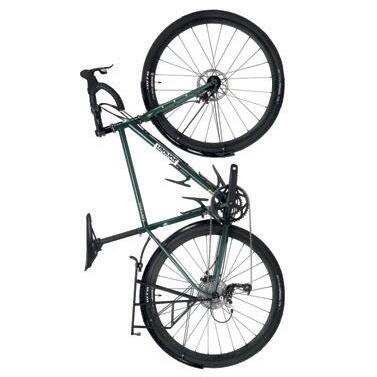
SPA CYCLES D’TOUR
725 DISC TOURER
9SPD £1,395
Reynolds-725-framed, triplechainset-equipped tourer with handbuilt wheels, Brooks saddle, mudguards and Tubus rear rack. spacycles.co.uk

Verdict
Fully equipped steel tourer with a lovely plush ride, a super upright and comfortable riding position, an excellent gear range and more bosses than (old joke alert!) British Leyland. (As Cycle went to press, it looked like the Kona brand would be sold. Bikes remained available.)
BIKE TEST KONA SUTRA SE 74˚ 1061 170 622 142 520 445 66 41 283 626 793 550 620 70.5˚ 710 73 50 Dimensions in millimetres and degrees 66 cycle JUNE/JULY 2024
Other options
Top: Bottom gear is 26/36, which is fine for loaded touring Bottom: Tektro Spyre-C cable discs provide reliable braking





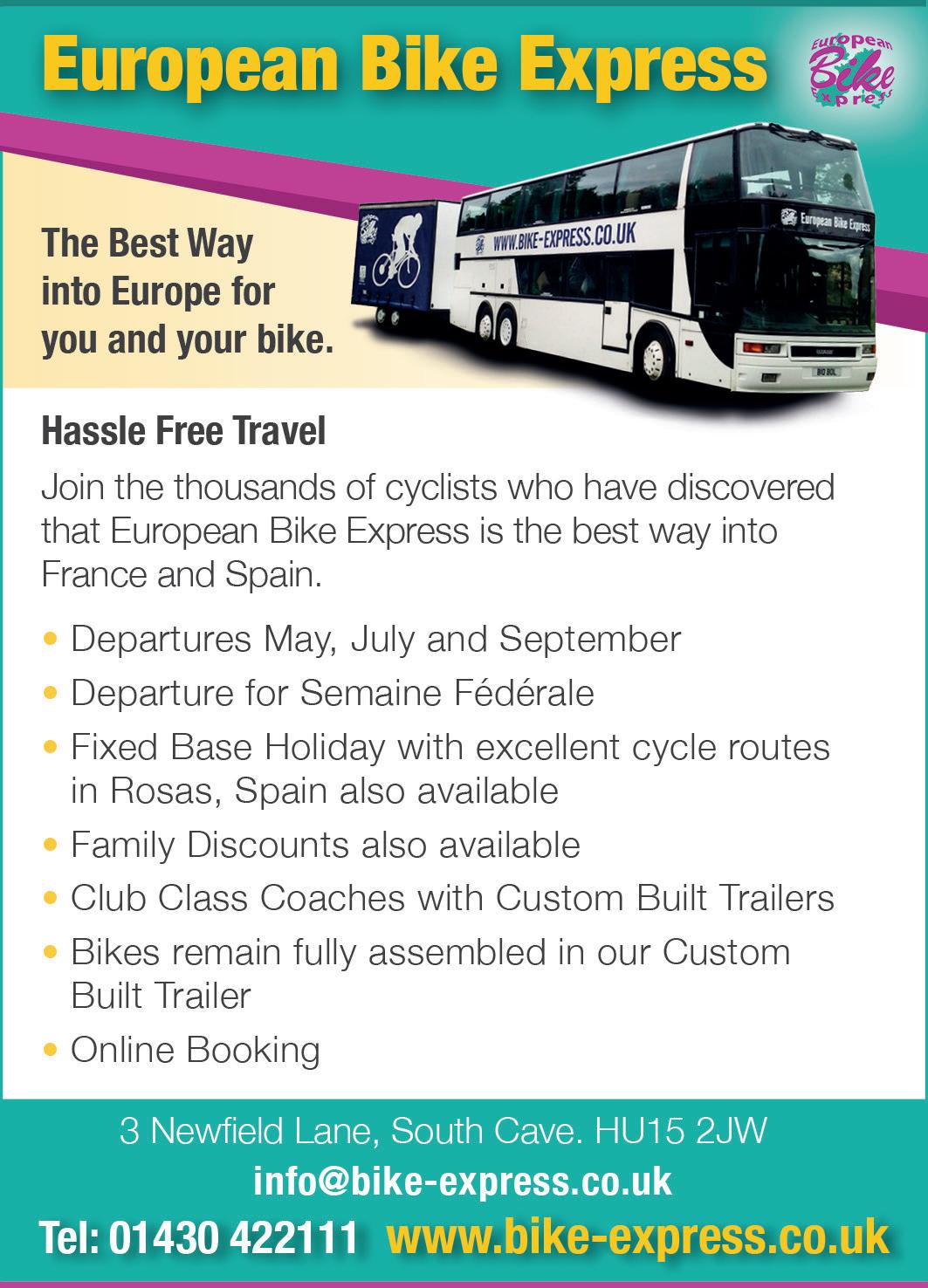

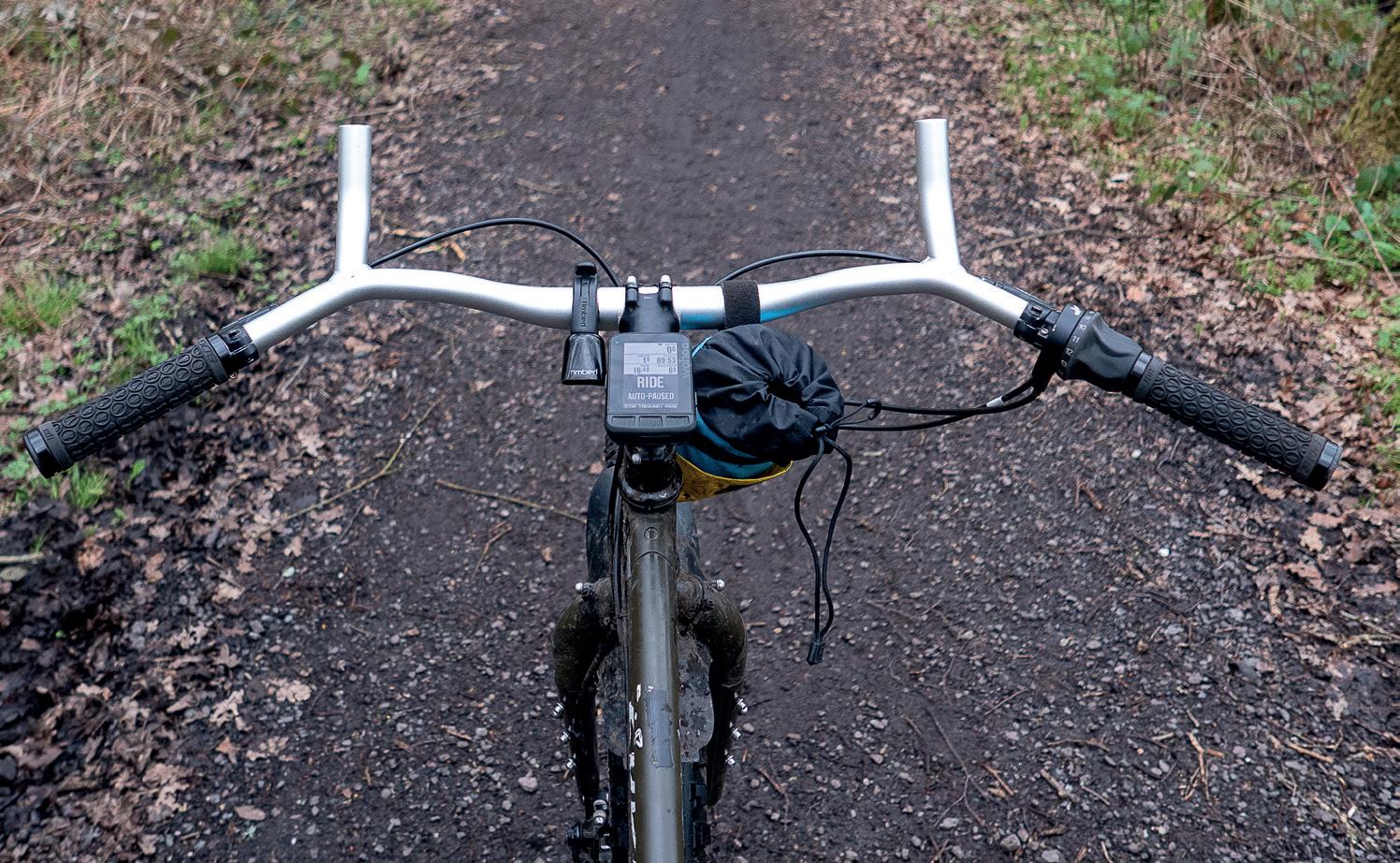
Grouptest Alternative handlebars
A flat handlebar gives you one hand position, which isn’t always comfortable. Sam Jones reviews four alternatives with a choice of handholds




Sam is access lead in the Surrey Hills and a keen bikepacker
Alternative handlebars (‘alt bars’) are designed primarily for long-distance off-road riding, where comfort and capability on tricky terrain are key design factors. They’re a subset of the flat bar found on mountain bikes and hybrids, and offer a multitude of different hand positions.
A standard flat bar gives you just one, which works fine for control off road but locks you into that handhold. If you ride for any great length or time, no matter the terrain, being able to change your hand position is always welcome. That’s where alt bars excel.
These bars are often designed with bikepacking in mind. Compared to drop bars, they are more compatible with handlebar rolls and not as restrictive in terms of luggage and accessory space.
If swapping to these bars, it’s worth bearing in mind that their width may mean that you need longer cables, housings and hoses – though that’s less likely if coming from a modern mountain bike with a wider bar.
One bar missing from this test is the On-One Geoff, which is a cheaper copy of the Jones. We’ve reviewed that at cyclinguk.org/geoff-handlebar. (Tester Dan Joyce now has two.)
Cycle’s test promise
At Cycle, we are proudly independent. There’s no pressure to please advertisers as we’re funded by your membership. Our product reviews aren’t press releases; they’re written by experienced cyclists after thorough testing.
Details WHAT TO LOOK FOR
1 Hand positions
Loops, ‘horns’, grip length: all provide more options for hand placement, which is vital to relieve hand fatigue. Bars with a lot of sweep give you more choice in how you sit, from leaning forward to an upright Dutch style (assuming long grips are fitted).
2 Luggage/ accessories
Loops have an additional benefit for loaded riders: making your bar roll more secure without the need for a harness. Additionally, all that extra tubing means room for lights, GPS, bells, baguettes and so on.
3 Material
Most alt bars are aluminium. Steel, titanium and carbon bars are available,
with different benefits usually offset by increased price. In likefor-like comparisons, non-aluminium bars reportedly soak up more trail buzz.
4 Dimensions
All those tested are 700-800mm wide and have a 31.8mm stem clamp area. Greater width gives control on technical terrain and space for luggage. Too much width complicates tight woodland trails and train travel!
5 Rise
Like a standard riser bar, a bar that curves upwards puts the hand positions higher, sitting you a bit more upright and taking the strain off your back. This can be of particular benefit to taller riders looking for improved comfort on long rides.

CYCLINGUK.ORG cycle 69
SAM JONES
ALTERNATIVE HANDLEBARS GROUPTEST


Verdict

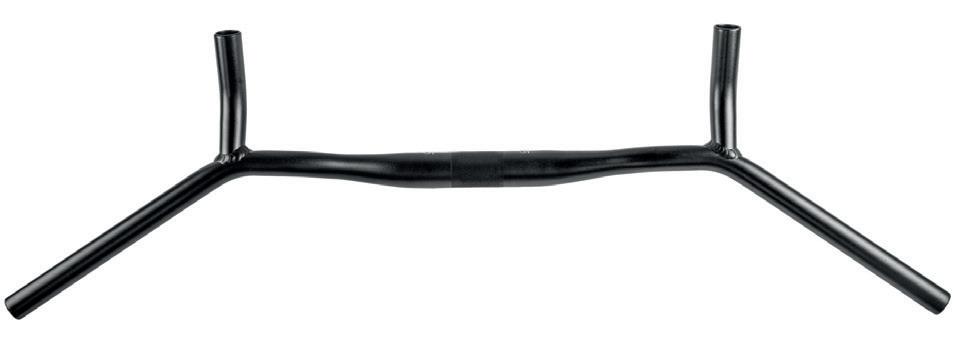
All these bars are bikepacking capable. Alpkit’s Confucius is an affordable entry point into alt bars. For those who ride hard and light it’s a great option, although it’s not as comfortable for long-distance riding as the others. Velo Orange’s Crazy Bar is the outlier in design, but despite the impracticalities it creates in terms of transport and tight singletrack, the confidence it lends to your ride is worth considering if you’re not a fan of the loop. Jones and Surly both raise the bar (pun intended) in terms of luggage-carrying capabilities, extra equipment placement and overall comfort. Between the two, the Surly Moloko’s lower price, steel tubing and ‘hornlets’ carry the day for me.
1 Surly Moloko Bar
£129.99 surlybikes.com
THE HEAVYWEIGHT CONTENDER in this review, the Moloko bar (anyone else thinking of A Clockwork Orange?) is 722g on my scales. That’s down to it being made of steel; the others are aluminium. Steel helps eliminate some off-road buzz, meaning less stress on your paws over long rides. At 735mm wide and with a more modest sweep of 35° (10° less than the Jones), it’s another comfortable bar that gives plenty of options for hand placement. There’s guidance on where to trim the bar if you find it too wide. The wee ‘horns’ are a nice touch if you’re trying to be aero – or need something to hold fast to when hauling yourself uphill.
2 Jones
SG Loop H-Bar standard rise
£149 jonesbikes.com
ARGUABLY THE BAR that launched a thousand (well, quite a few) variations, there’s a reason why the Jones bar is so popular: it’s incredibly comfortable. Uncut at 710mm and weighing 625g, it can seem monstrous initially. Its length, 45° sweep and loop give multiple hand positions, providing comfort on all terrain, and allowing for a more upright or aggressive position as you see fit. The loop also gives plenty of room for lights, bells and other equipment, and provides a stable platform for fixing luggage. It’s hard to fault the original alt bar, but the price may make some hesitate. Available in the UK from bothybikes.co.uk
A worthy and slightly cheaper alternative to the original Jones – although also heavier Incredibly versatile and rightly loved, but very expensive
3 Alpkit Sonder Confucius
£34.99 alpkit.com
IF YOU’RE ALT-BAR curious the wallet-friendly Confucius could be for you. The bar has minimal rise and sweep (15°). The minimalist theme continues as it’s also the lightest bar at 481g – despite being the second widest at 760mm. Modern mountain bikers will find the width and sweep familiar, with the smaller loop (in comparison to the Jones and Surly bars) also providing enough hand positions to prevent fatigue as well as space for gadgets. I found the lack of sweep meant these bars suited technical rather than longer rides, while the smaller loop was less convenient for lashing luggage to than the others reviewed here.
Best on test for shorter, technical bikepacking trips. Very affordable
More online
For more reviews of bikes, kit and components, as well as how-to guides, visit... cyclinguk.org/advice
4 Velo Orange
Crazy Bars v2
£109 velo-orange.com
THE ORIGINAL CRAZY Bars had no rise, which was changed to a 40mm rise for the v2 on test. The name is highly appropriate, as even if accustomed to alt bars the width (780mm) of this one is a bit bonkers. This width can make train travel difficult in the UK (even more so than other alt bars), and you’ll need to dial back your woodland and city riding until you get used to it. Despite the width, it’s a modest 539g on the scales. Like the Moloko bar it has a 35° sweep, which gives a more relaxed, upright feel to the ride – although if you drop onto the ‘horns’ you can adopt are more wind-cheating posture. Available in UK from veloduo.co.uk
Great for plains and moors. Maybe steer clear of forest singletrack!
70 cycle JUNE/JULY 2024
GROUPTEST ALTERNATIVE HANDLEBARS
1 2 4 3
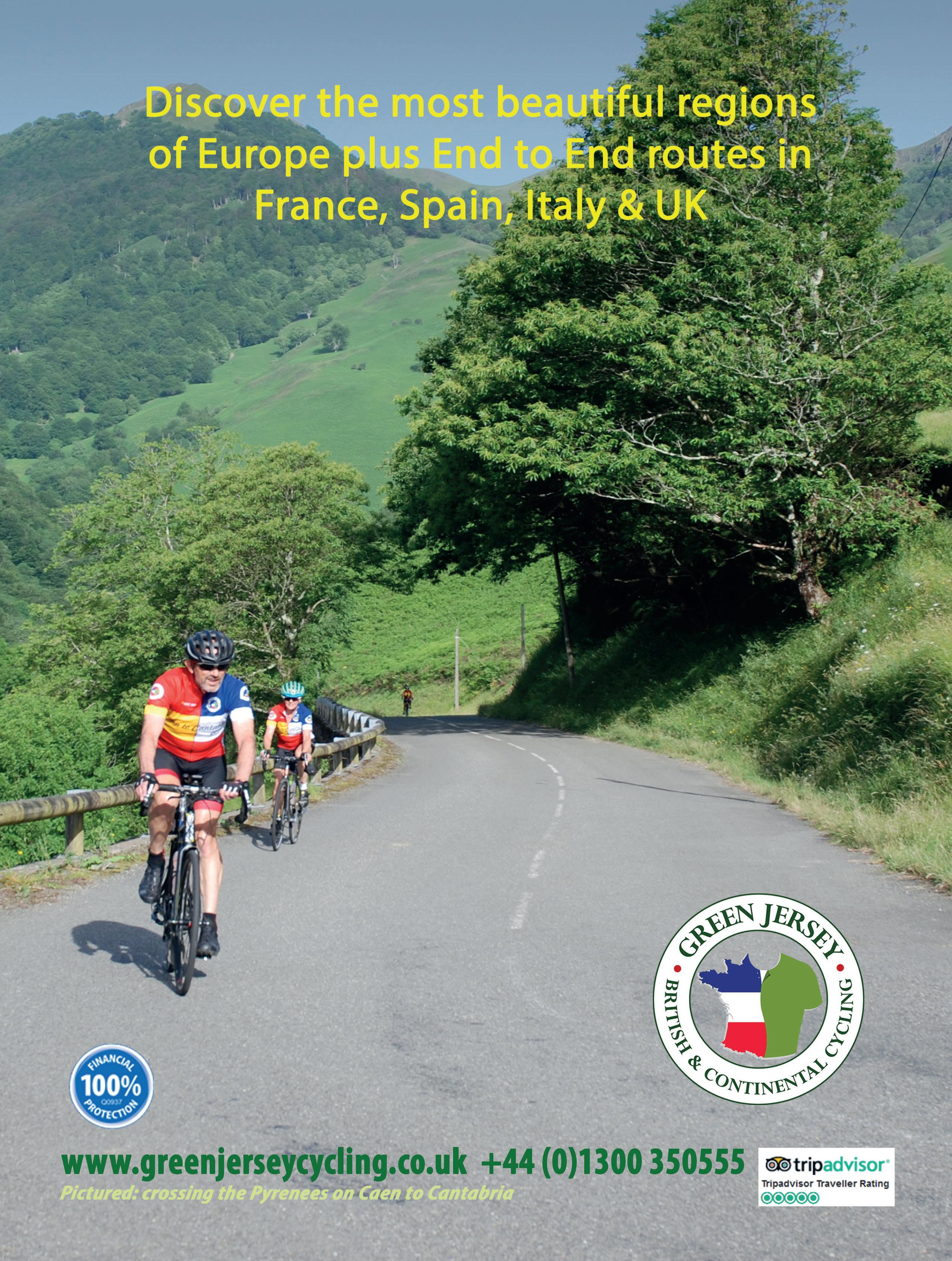





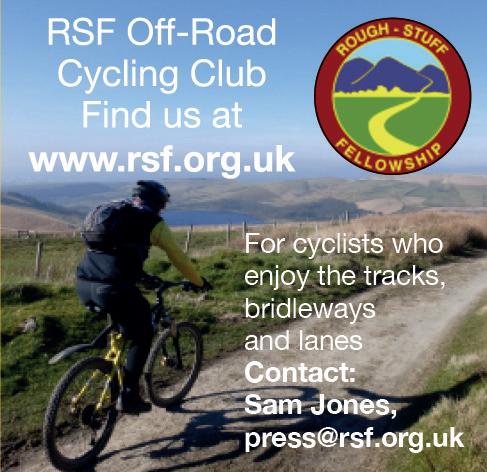
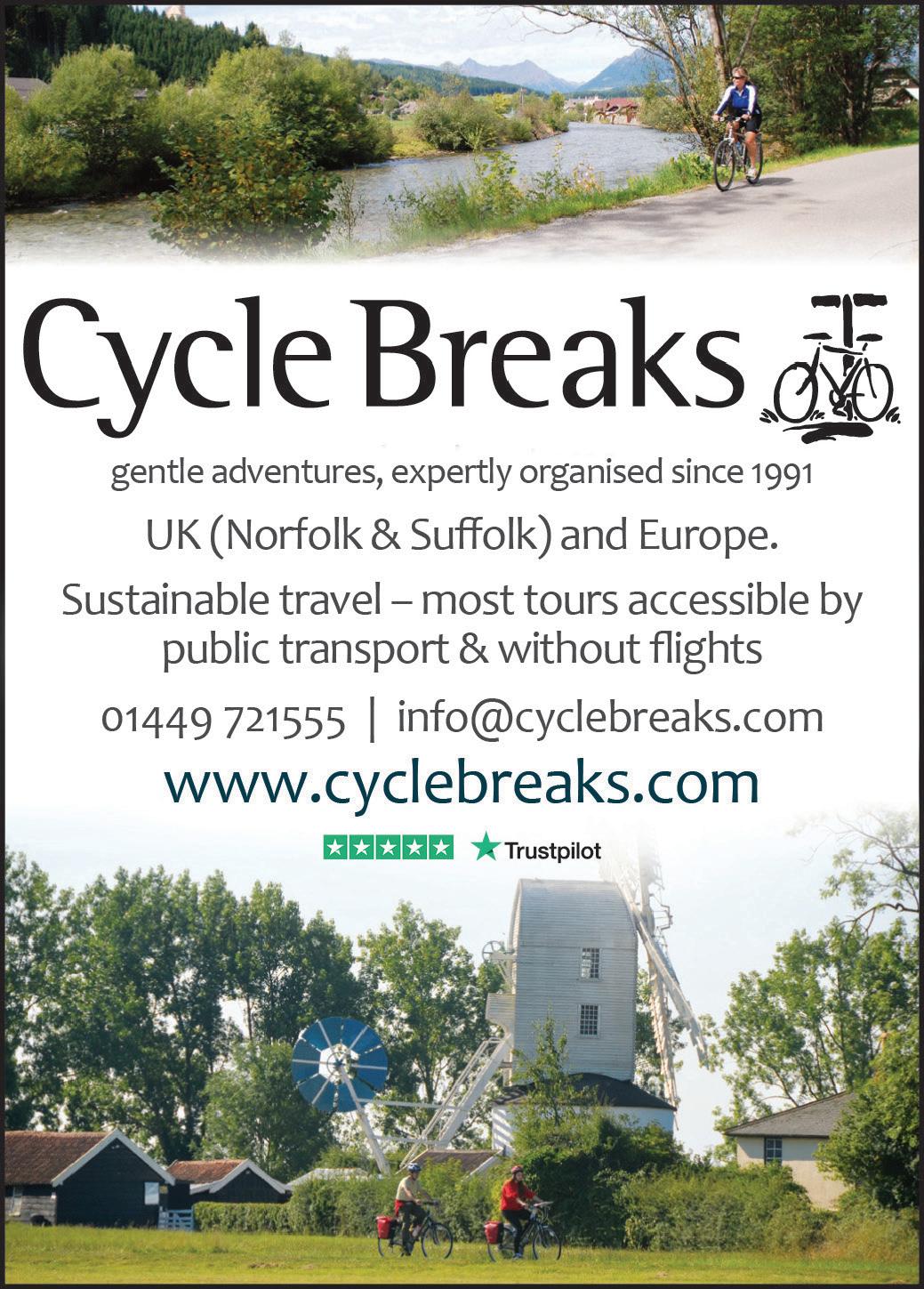
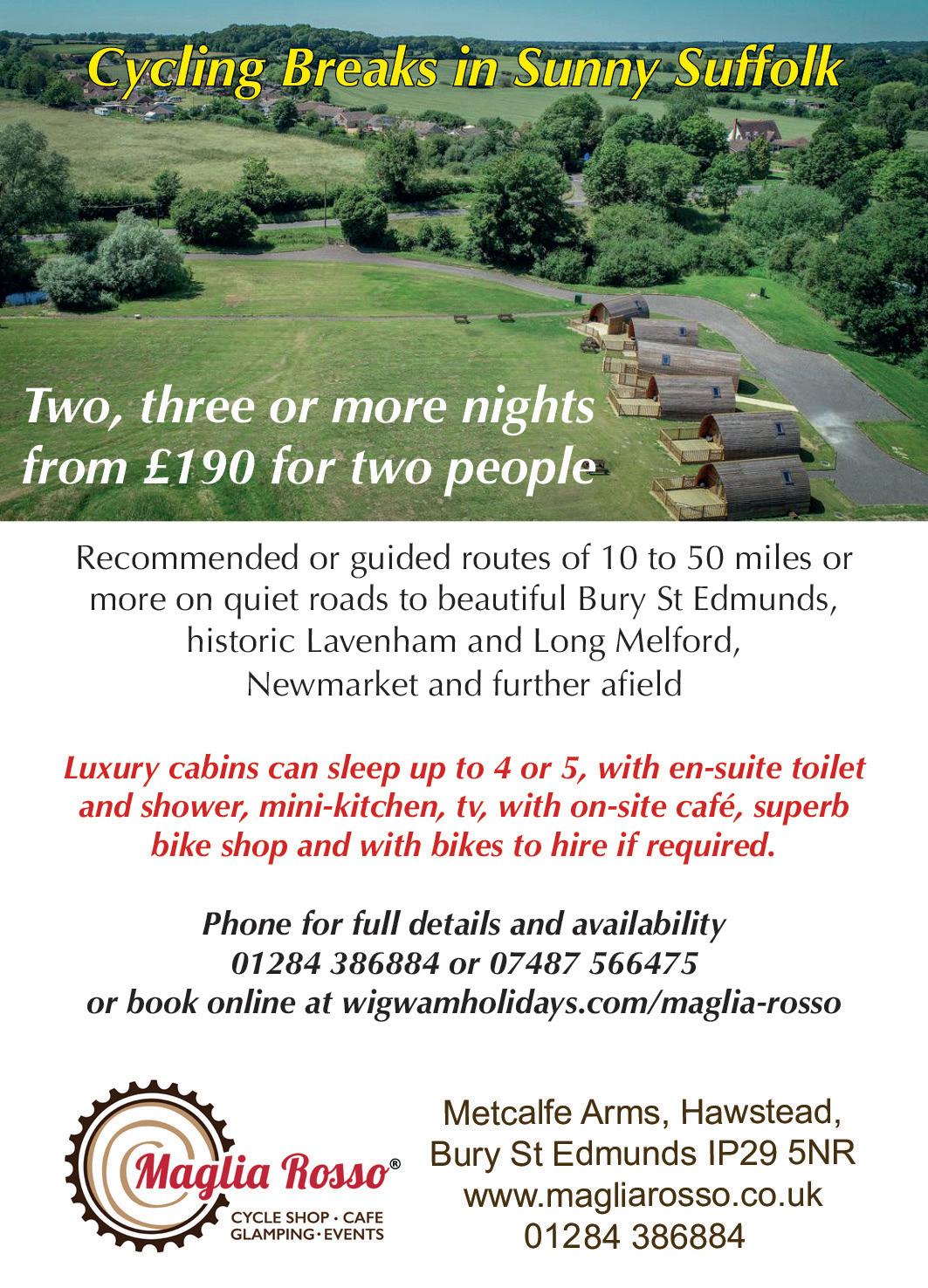
To advertise in the next issue of Cycle please contact: 0203 859 7100 jacob.tregear@jamespembrokemedia.co.uk Jacob Tregear CYCLE HOLIDAYS & DIRECTORY To advertise contact Jacob Tregear: jacob.tregear@jamespembrokemedia.co.uk To advertise in the next issue of Cycle please contact: 0203 859 7100 jacob.tregear@ jamespembrokemedia.co.uk Jacob Tregear
TRAVELLERS’ TALES


Finland
The longest day
Sometimes cycling touring doesn’t go to plan. Dan Wynn recalls a day that was too long, too hot and too mosquito plagued…
On the cycling trips I’ve done, I find there’s one day when you really hate your bike. Most of the time it’s great but that bad day is also part of cycle touring. That day where you have to grit your teeth and ride through the hate to rediscover your love for cycling. For me that day came on the Åland Islands, halfway through a tour of the Archipelago Sea.
I was overtired and sunburned. Already 30km into the ride, the campsite was another 24km away. It was unbearably hot. I had no food or water. Then I arrived at the campsite, there in the middle of nowhere, and it was closed. It was devastating.
I huffed and puffed but no matter how hard I blew, that wooden barrier wasn’t opening. So of course I did what any reasonable person would do: I blamed it all on my bike. It was as if the previous 160km and four days that it had carried me meant nothing. Then I searched my torn map and found another campsite 18km away. I would likely arrive at 10pm –even hotter, even thirstier, even more miserable.
With little choice I rode on under
the midnight sun along heat-reflecting tarmac, passing Falu red barns and mottledbrown Ayrshire cattle. Open farmland shelved away to the right, ending in an azure sea that mirrored the clear skies overhead. On my left was sparse pine forest. Feathery green needles and brittle pine cones littered the road.
A blast of decaying seaweed hit me around the next bend. It marked the bridge to Prästö Island. The map said my campsite would be opposite. To my relief it was – and it was open. I pedalled into a deserted field and wearily unpacked my tent. Resting my cramped legs in the calm evening, I began to rekindle my love for cycle travel. Then an army of mosquitoes arrived…


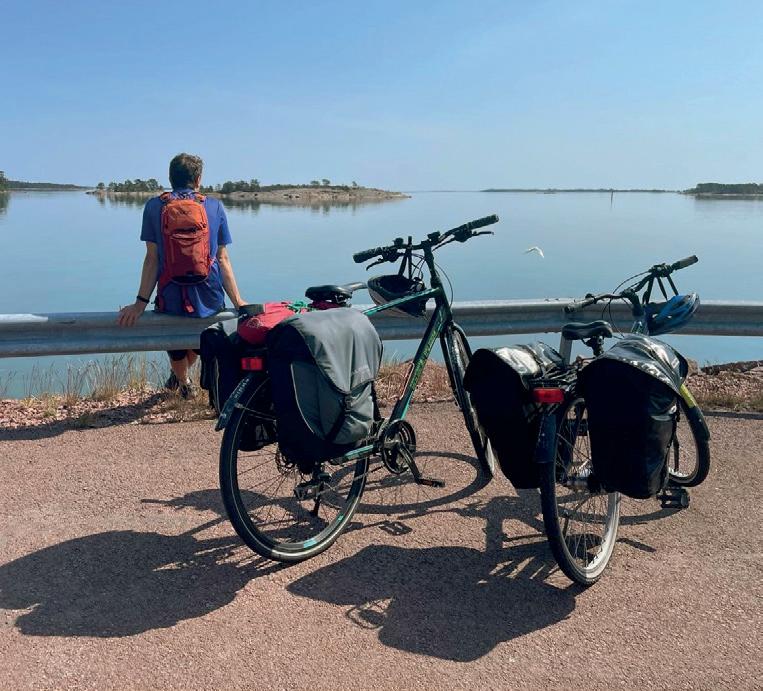
Share your story
We’d love to hear your Travellers’ Tales! Email: editor@cyclinguk.org

Scotland
Northern islands
Last
summer, 78-year-old ex-Marine Jonathan Thomson rode across Orkney and Shetland
ON A SEVEN-DAY cycling adventure across the Orkney and Shetland islands, I joined three ex-forces colleagues to raise funds for UK veterans’ mental health charity PTSD Resolution. We aimed to cycle to the northernmost road in the British Isles and back, covering over 700km.
This journey tested our grit and determination as we battled the elements, while also rewarding us with diverse landscapes and wildlife. From ancient stone circles to wartime history, Orkney’s otherworldly beauty fascinated us. Crossing to Shetland brought mist and rain but the vibrant wildflowers were a heart-warming sight.
We reached our northernmost point at SaxaVord Spaceport, before turning south to Lerwick. Our final day in Shetland brought peaceful scenery and playful lambs. On Orkney, the Neolithic sites and lush green fields captivated us. Seeing dolphins on our return to the mainland was a delightful ending.



This trip allowed us to connect with history and nature while raising money for a meaningful cause. Despite challenges from the weather, each day brought accomplishment. The array of wildlife, from dolphins to groundnesting birds, was a privilege to observe. The diversity of landscapes, from open moors to green valleys, created an unforgettable backdrop. Most special was the camaraderie between myself, Jim, Matt and Jez.
Our fourth cycle for PTSD Resolution has now raised over £100,000. This journey tested our limits but brought profound rewards.
CYCLINGUK.ORG cycle 73
A break by the Baltic
Dan waiting for an Åland Islands ferry
Hoy, Orkney –Scapa Flow to north
TRAVELLERS’ TALES
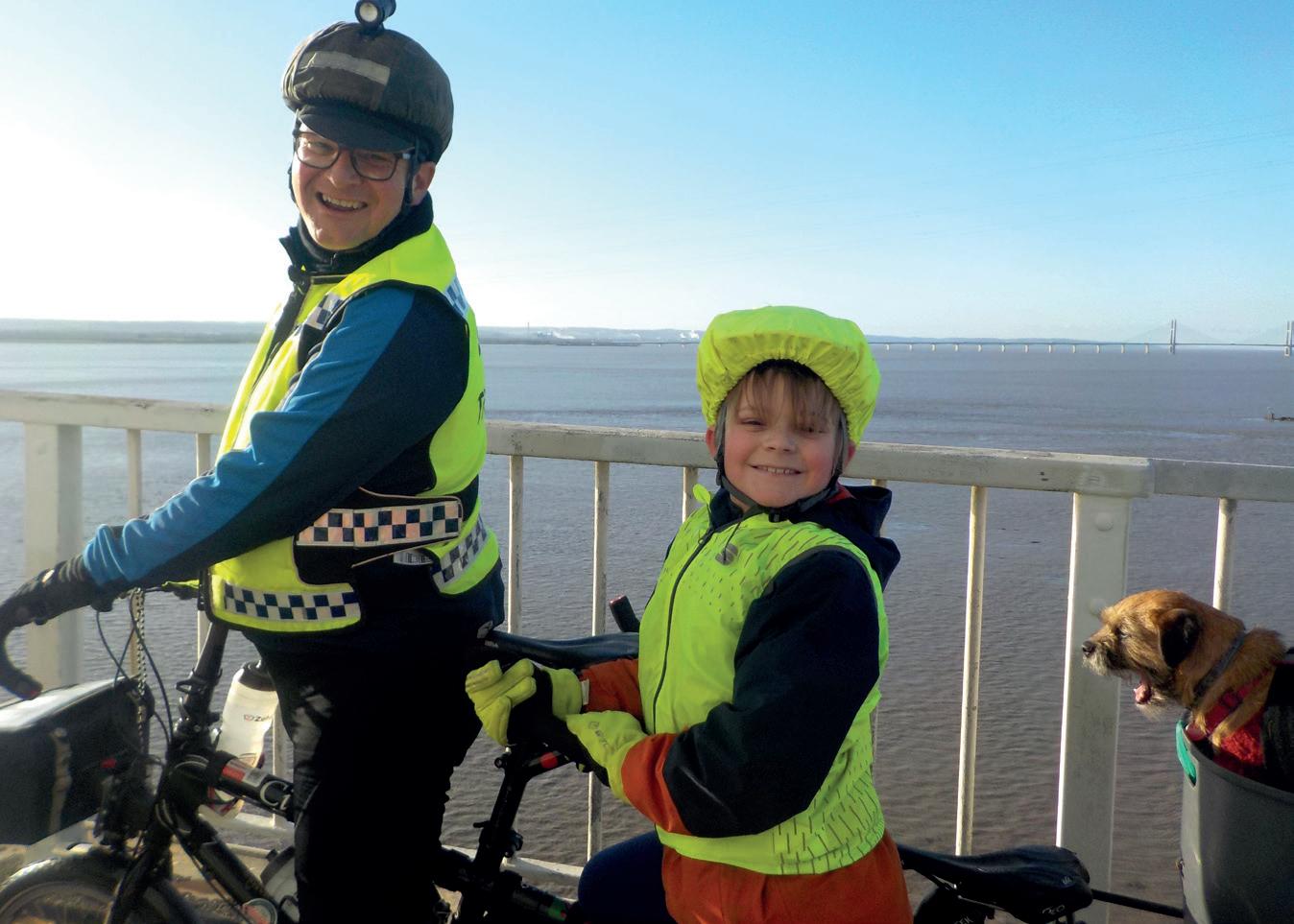

South-west England
Half-term staycation
Exotic destinations aren’t required for cycling holidays. Mark Siddall had a great family trip near home
We love getting away on long-haul holidays but it is extra special to take a break locally, reducing our carbon footprint, costs and stress levels all at the same time. Bike touring with children and a dog might not sound easy or fun but with the bike paths in our region it’s easily achievable. Home-to-home touring makes life much simpler.
The four of us left from home on the Saturday of February half term on our two Circe Helios tandems, with Biddy our border terrier on the back. One of the tandems has Shimano STEPS electric assist, making it easier to carry spare clothes and wet weather gear. Our route took us through Over to Highnam, all on bike paths. We then took the lanes through Tibberton and Birdwood, where we enjoyed a cracking full English.
After Flaxley and Little Dean, we went on through the Forest of Dean to Park End, where we stayed overnight. The Fountain Inn looked after our bikes and us very well. From Park End we rode on the next day to St Briavels before enjoying Chepstow Castle and a lovely pizza for dinner. The Beaufort Inn kept our bikes nice and safe in the ballroom.
Day three took us over the old Severn Bridge, which has a bike path
along both sides. It was a special experience to be suspended 100 metres in the air above the estuary.
From the Bristol side of the Severn Estuary, we rode back through lovely, wide and empty lanes through Berkeley, where we stopped at a tea room. Our final overnight stay was at the Tudor Inn in Slimbridge. The old skittle alley had no one using it and so we had a really fun evening enjoying pub skittles.
Our last day was on familiar territory, along the canal to Frampton and then back along the lanes through Saul and, finally, home to Quedgeley outside Gloucester. It was a very special time. We always had something to do and experience together. The trip gave us memories to last a lifetime – and with a very low carbon footprint.



North Wales
Wild Wales Challenge
Snowdonia’s roads make for a spectacular day out, as Jim Wright discovered
THE WILD WALES Challenge was named after the book ‘Wild Wales: Its People, Language and Scenery’, by Victorian rambler George Borrow. Each August bank holiday for the last 39 years, riders have followed a choice of hilly routes through Snowdonia: long (95 miles this year) or ‘short’ (65). Both have lots of climbing.
Last year I rode the shorter version with my son and daughter. The start was Bala Rugby Club. We meandered down the east shore of Bala Lake (Llyn Tegid), tracking the narrow-gauge steam railway. Turning left just before Llanuwchllyn, we started the tough climb up Bwlch y Groes.
The descent into Dinas Mawddwy is long and steep, as the 11 arrows on the OS map confirm. It was a lovely late summer day as we descended into Dinas and then climbed over Ochr y Bwlch to arrive at the first feed station at Brithdir. The route then took us via Coed y Brenin forest among a myriad of quiet lanes, eventually following the Afon Wen towards Pont Aber.
Avoiding Llan Ffestiniog, we stopped to admire the Rhaeadr y Cwm waterfall. Shadows lengthened as we neared Llyn Celyn reservoir, and the sudden drop in air temperature reminded us that autumn was approaching. Back at Bala we collected our commemorative Welsh slate plaques.
For those wishing to try the 2024 version, visit merseysidectc.co.uk/wwc
Stay connected facebook.com/CyclingUK @wearecyclinguk membership@cyclinguk.org editor@cyclinguk.org
74 cycle JUNE/JULY 2024
More online Fancy contributing to Cycle? Read the guidelines here: cyclinguk.org/be-part-cyclemagazine
Crossing the old Severn Bridge
One of the two Circe Helios bikes
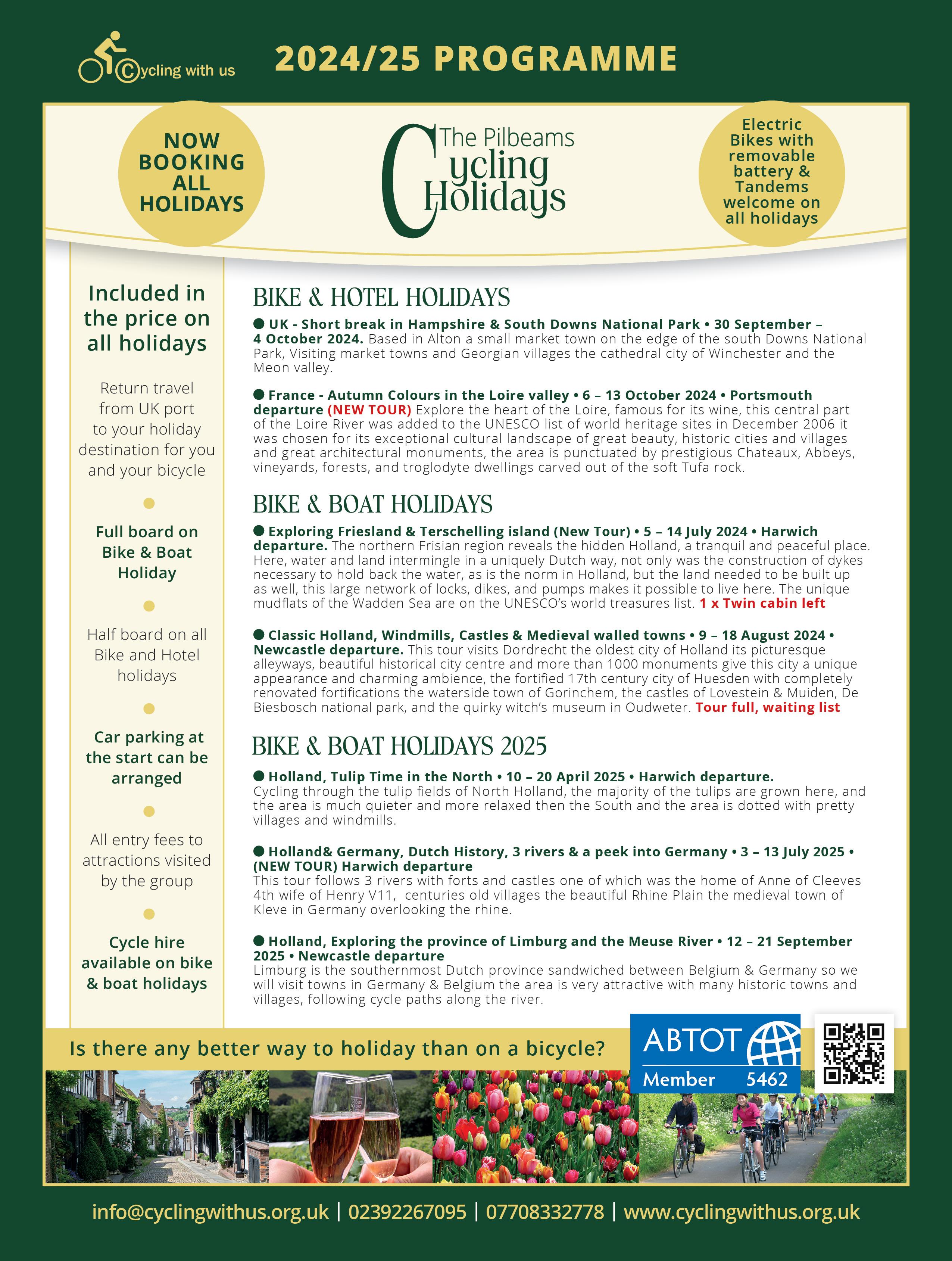































































































































































































 Disability cycling
Disability cycling















































































































































































 SAM WALLER
Cycling UK brand, marketing and communications manager
SAM WALLER
Cycling UK brand, marketing and communications manager


























































 RICHARD HALLETT Cycle’s technical editor {Technical}
RICHARD HALLETT Cycle’s technical editor {Technical}
 PAUL DARLINGTON Consultant solicitor, Cycle SOS {Legal}
PAUL DARLINGTON Consultant solicitor, Cycle SOS {Legal}












 MATT LAMY
MATT LAMY


 Ian Nicholson
Ian Nicholson






















































































